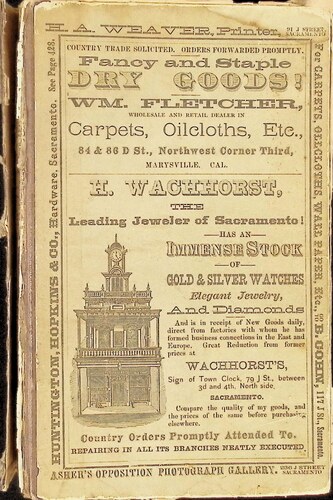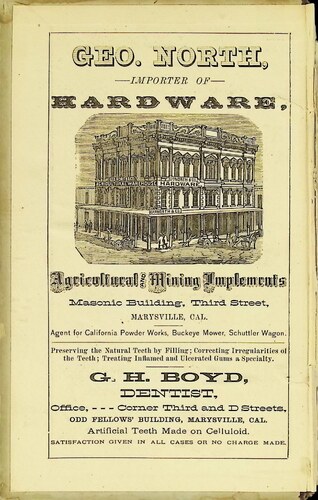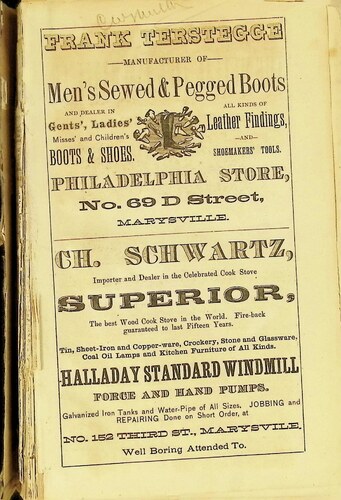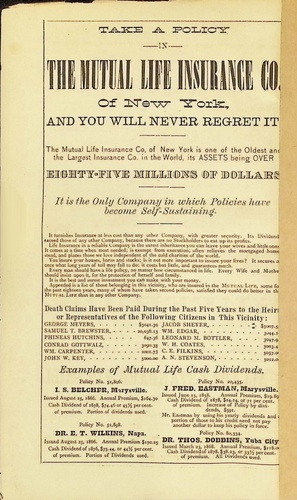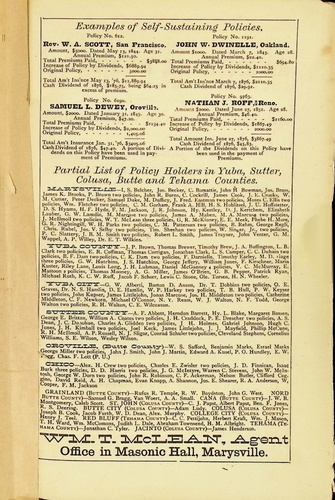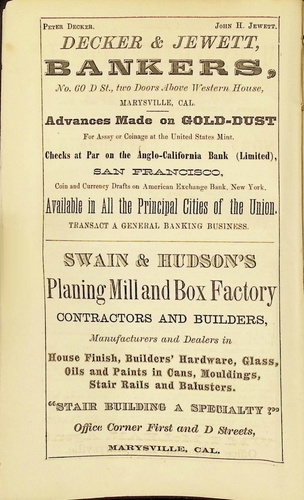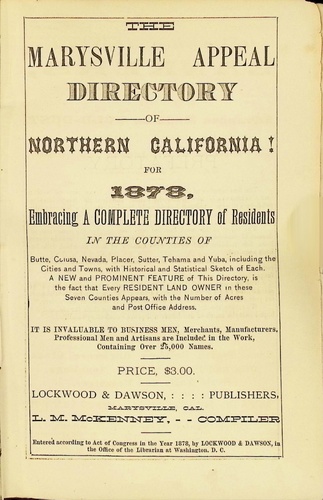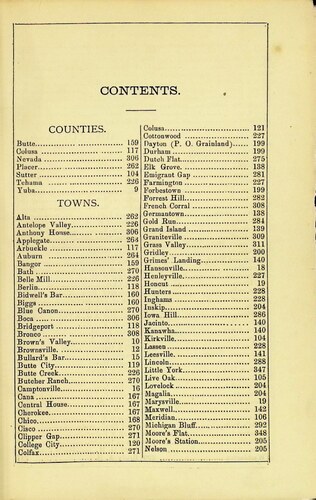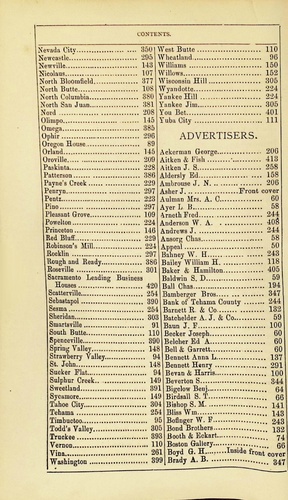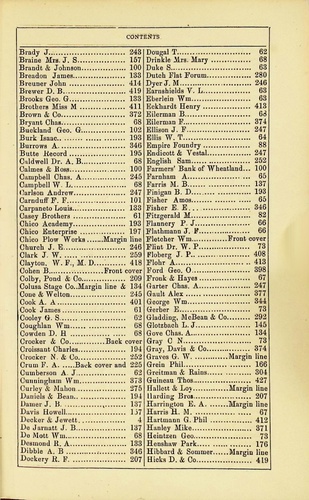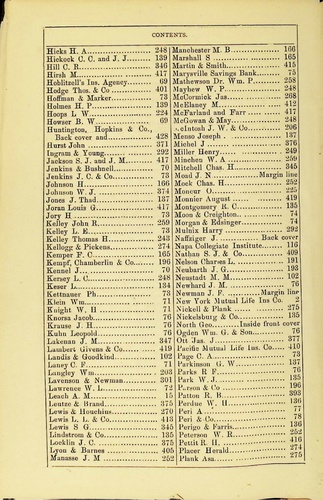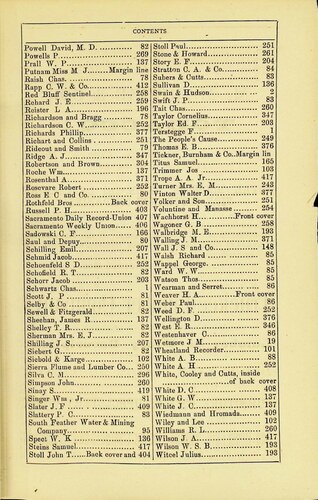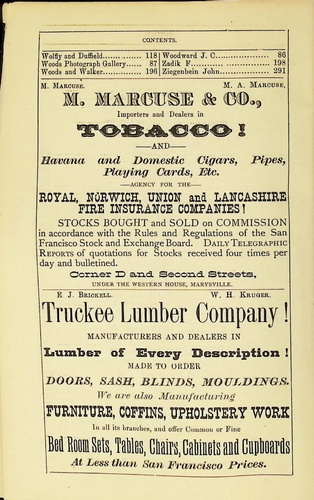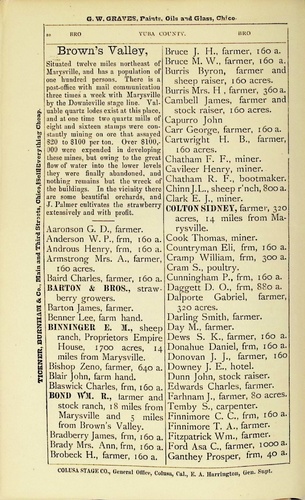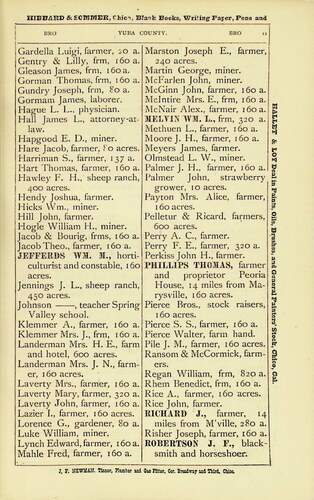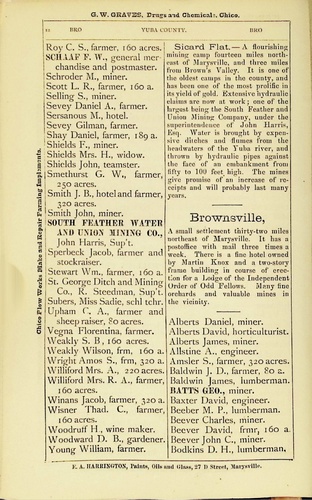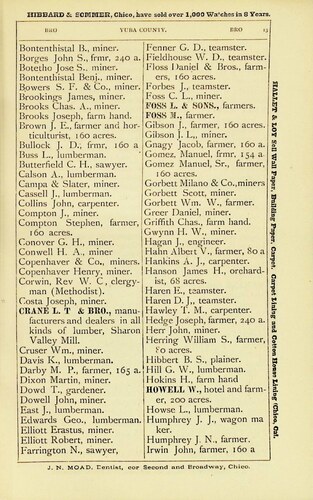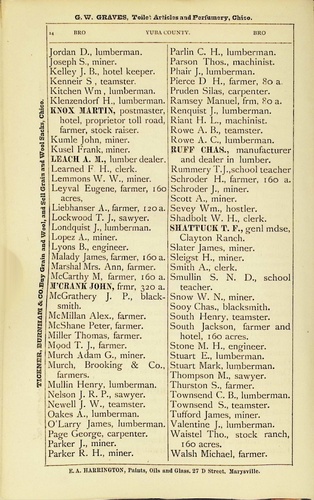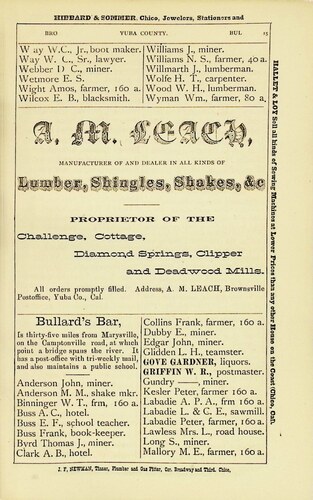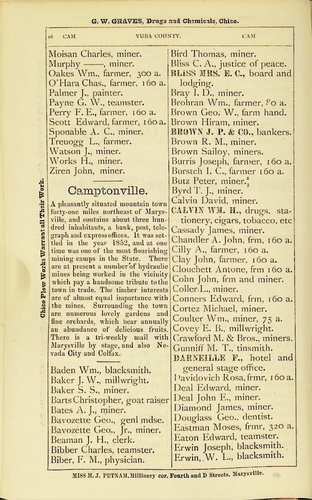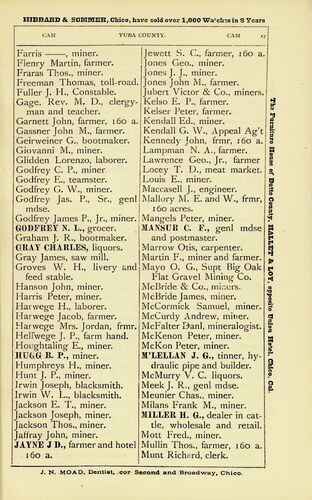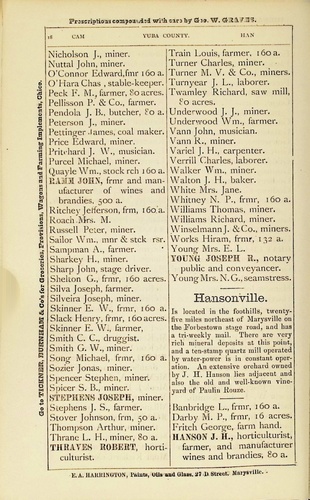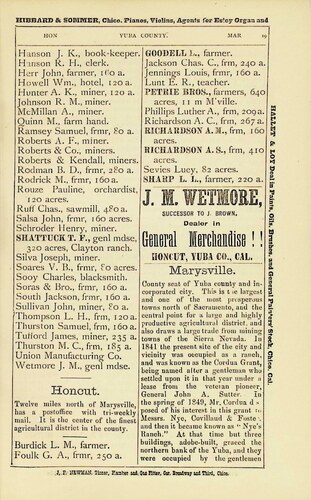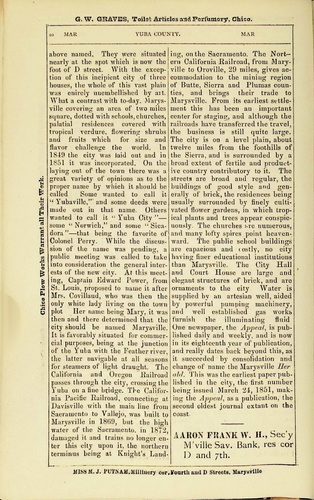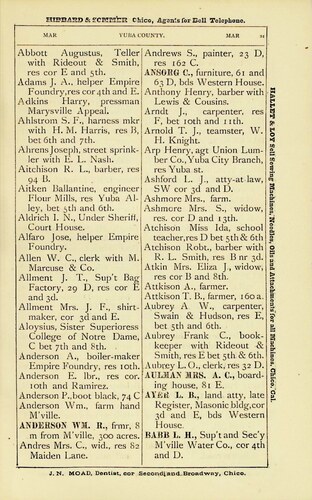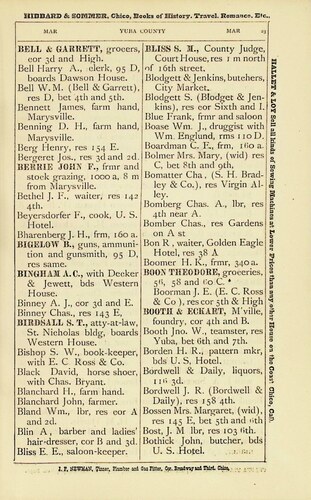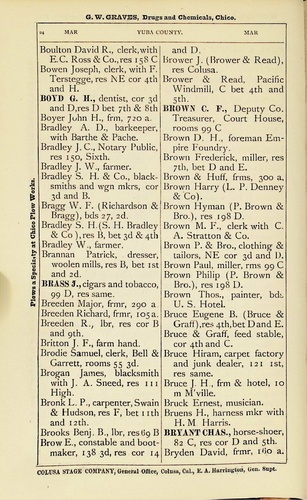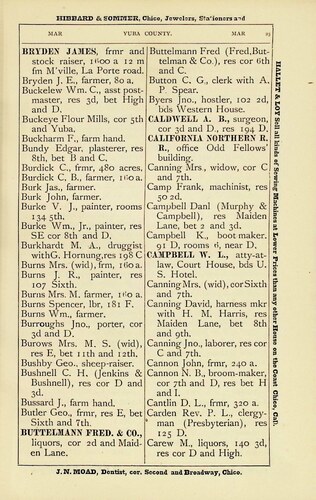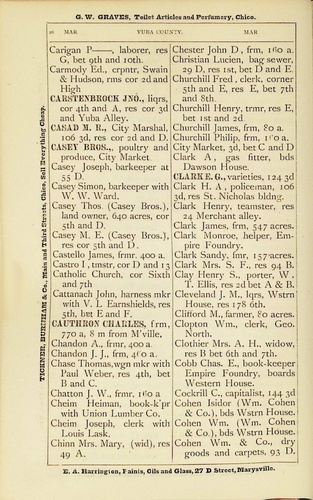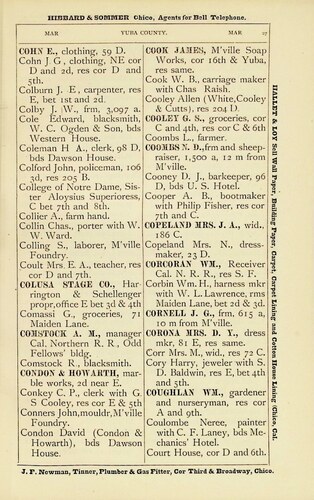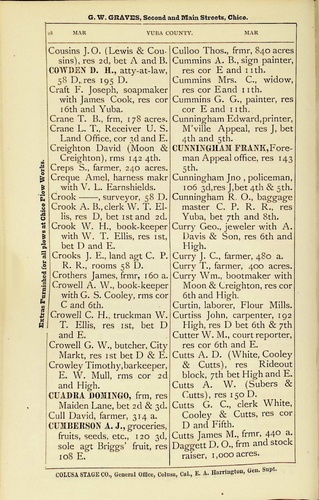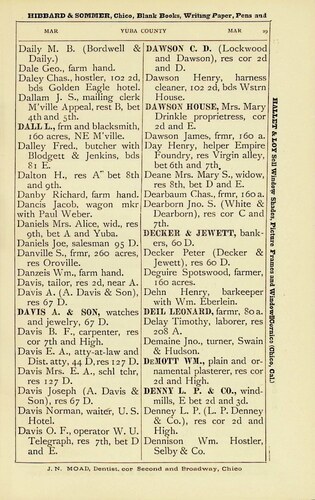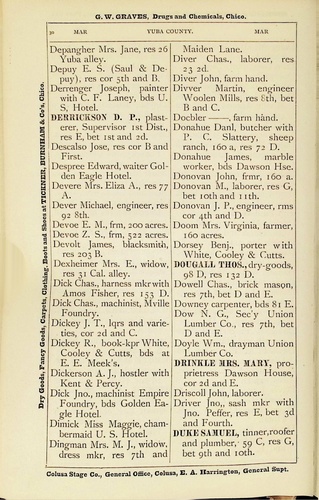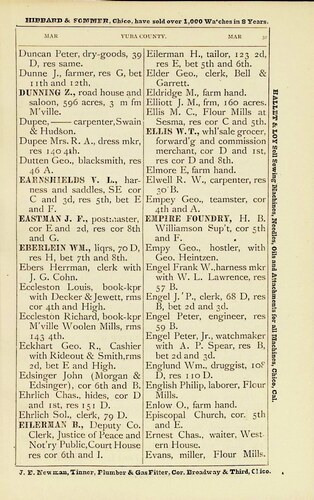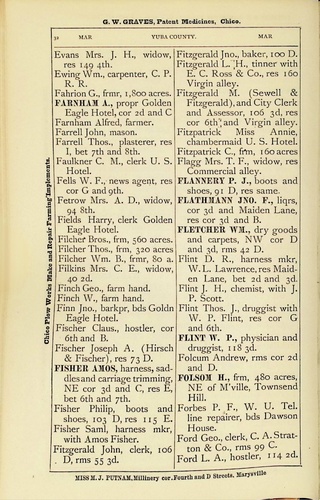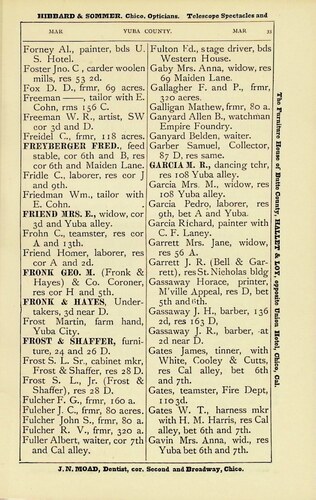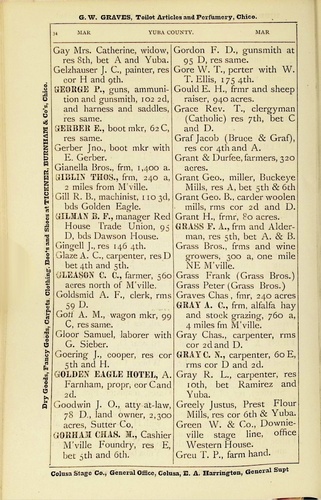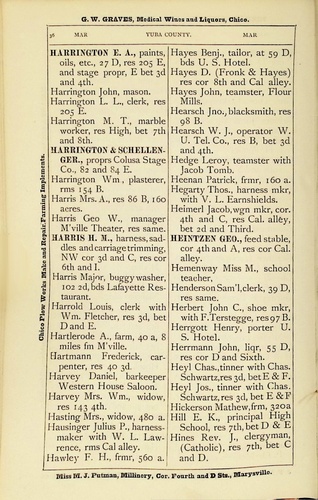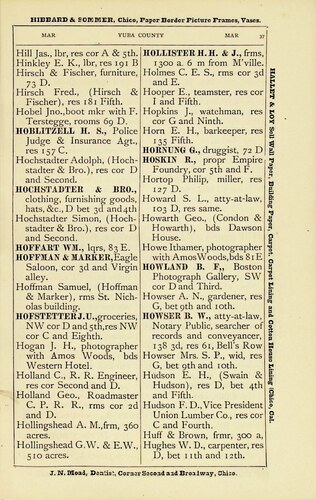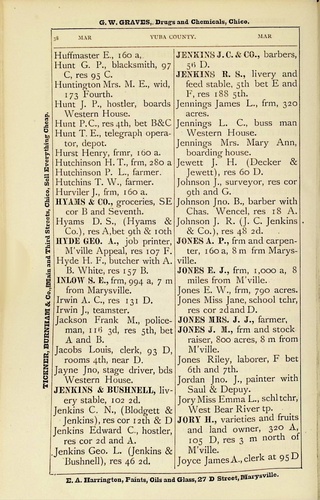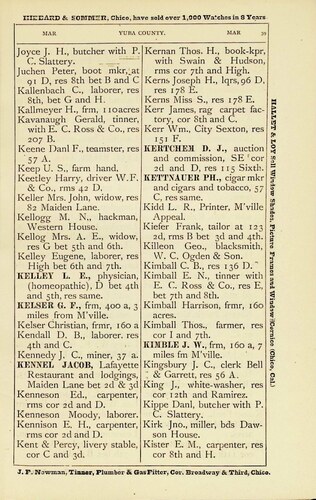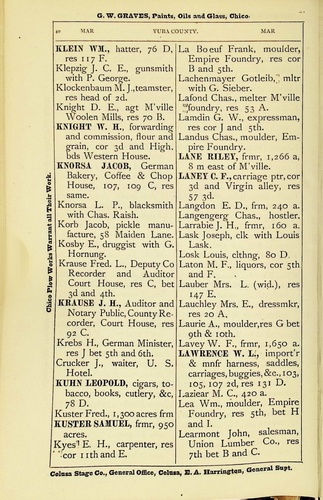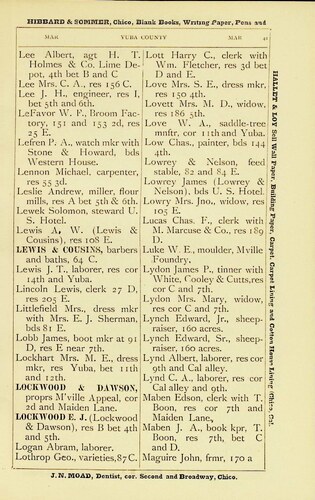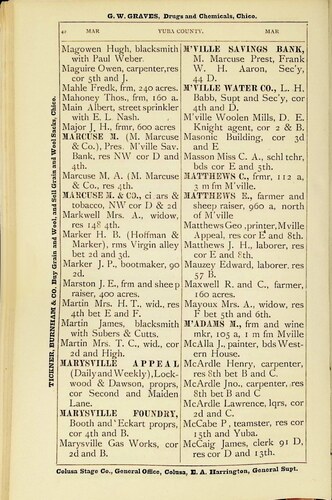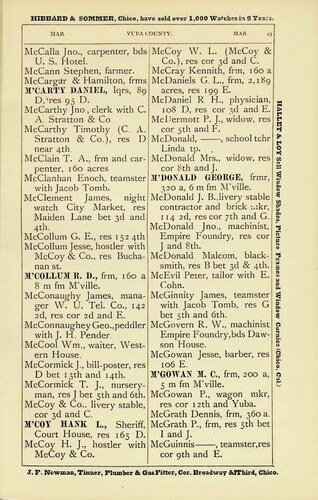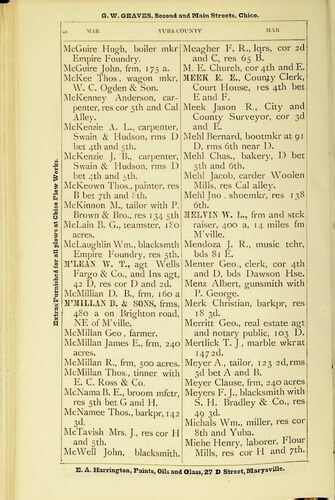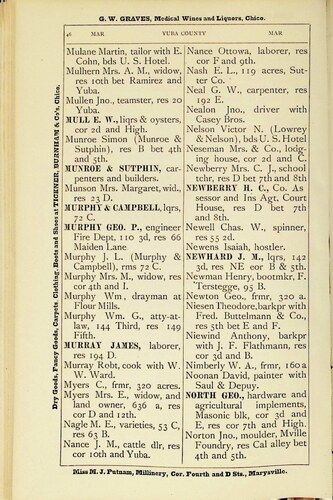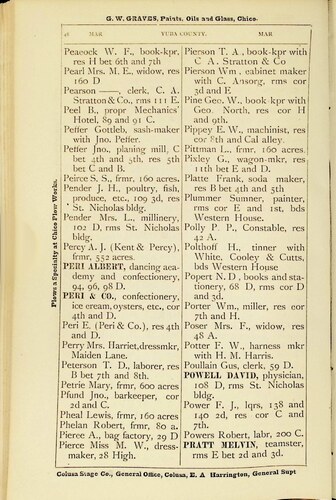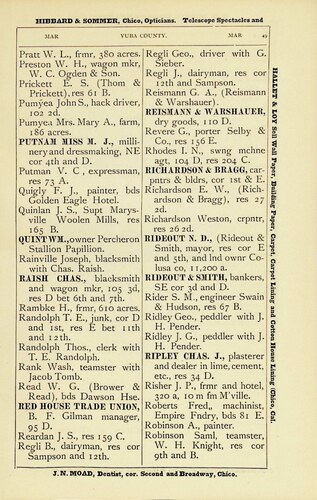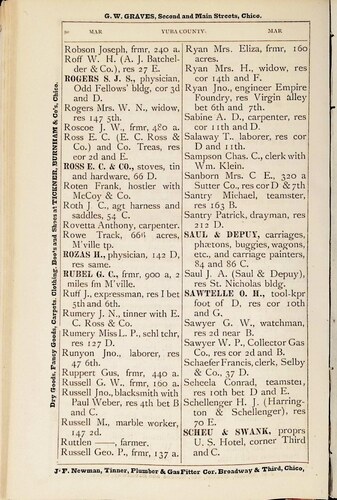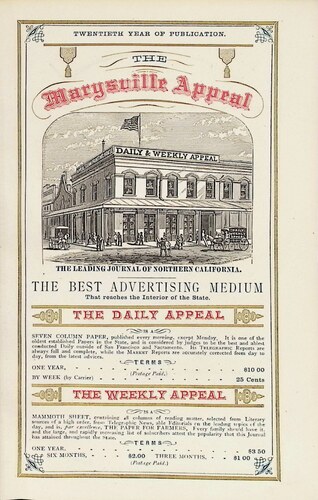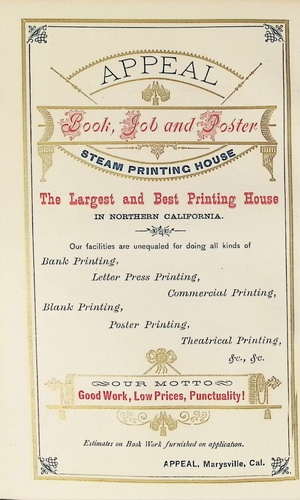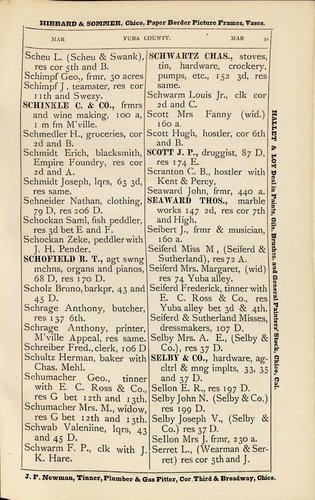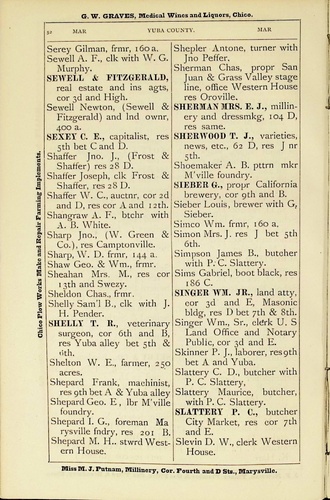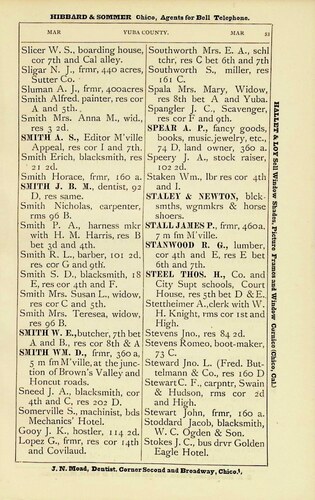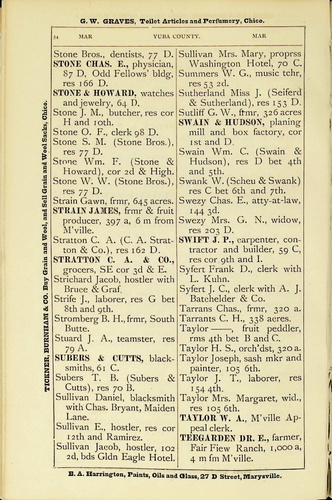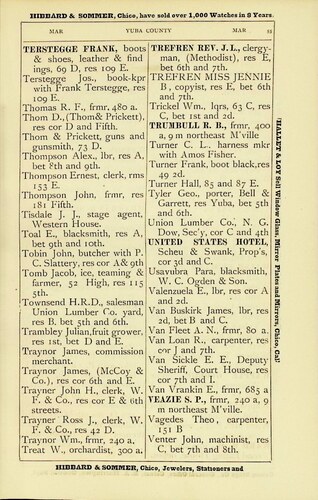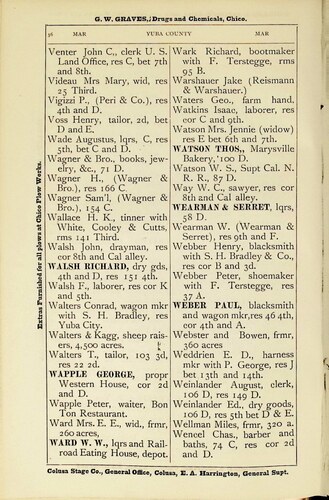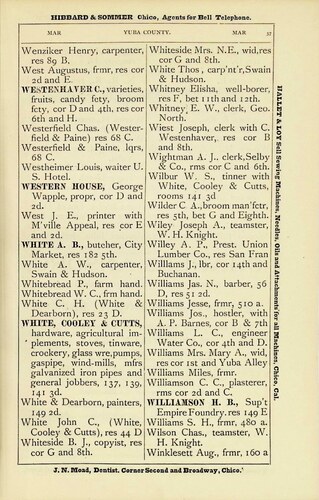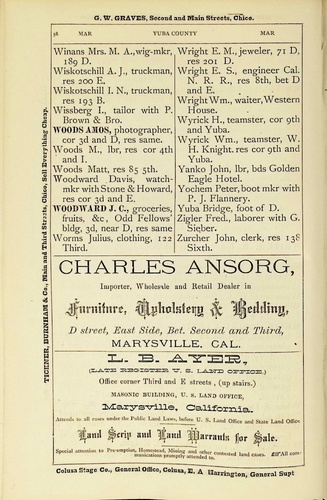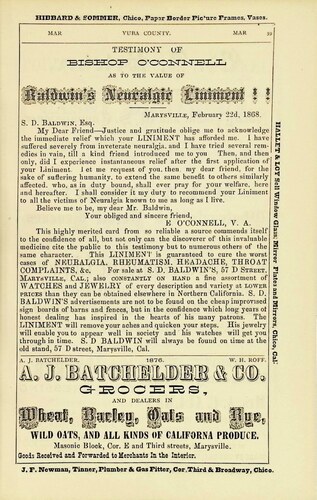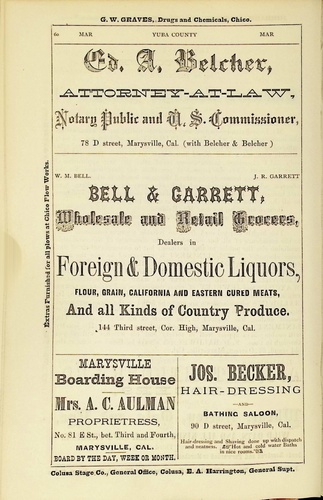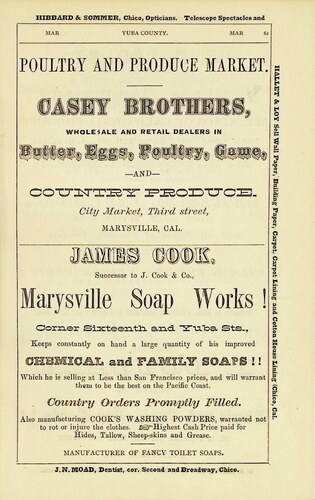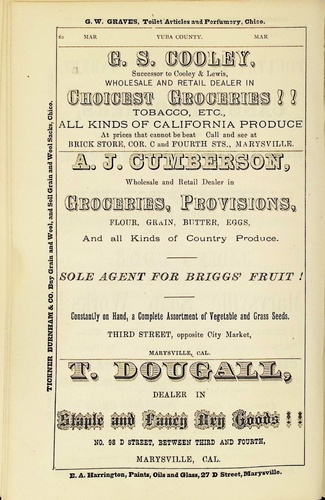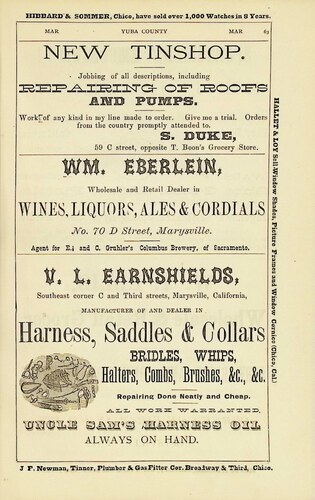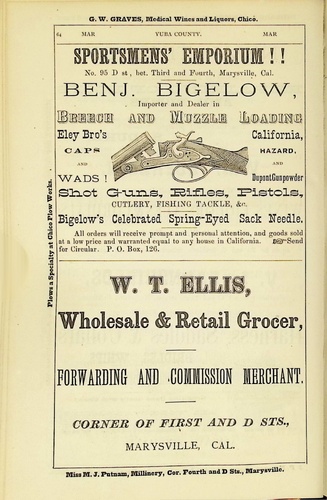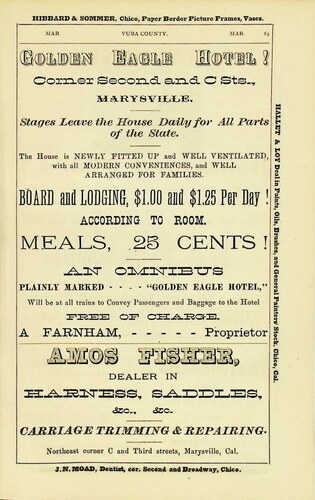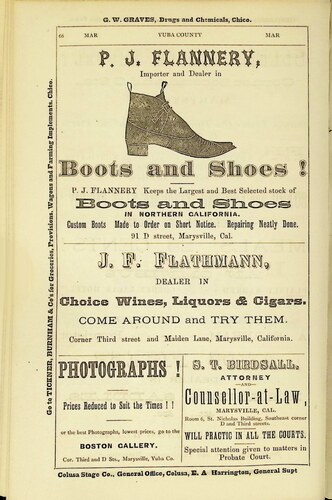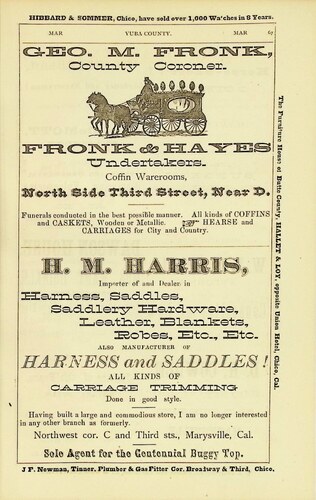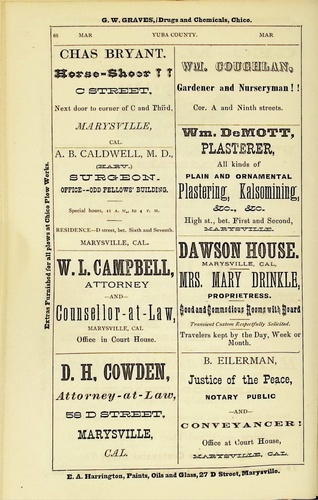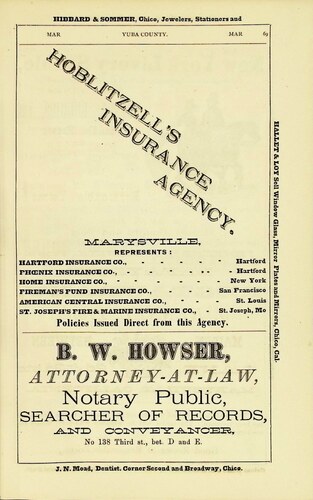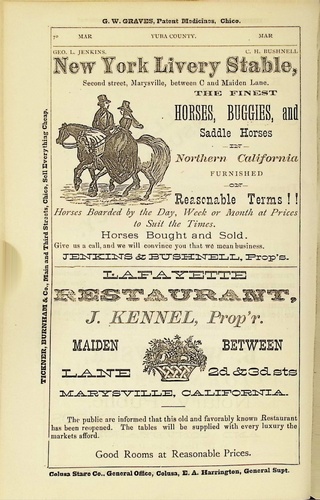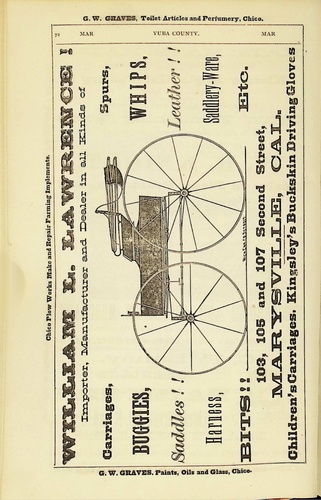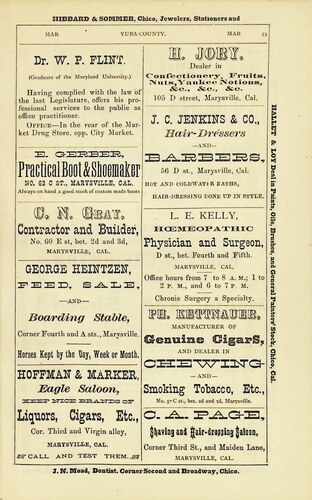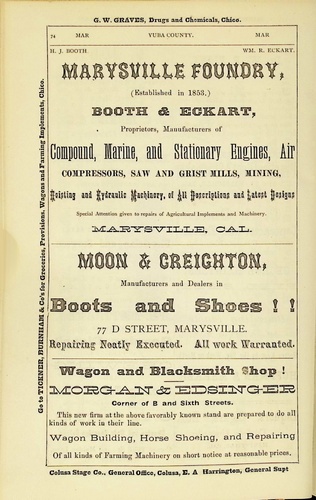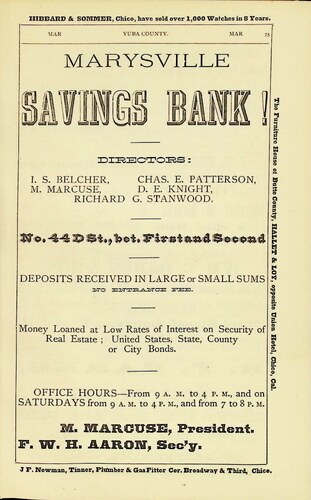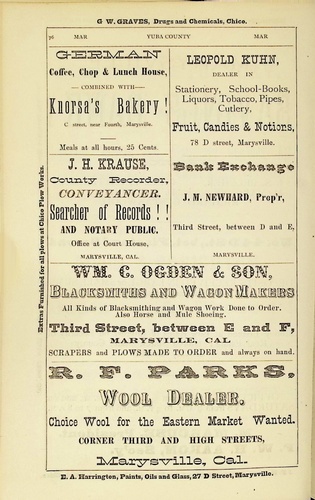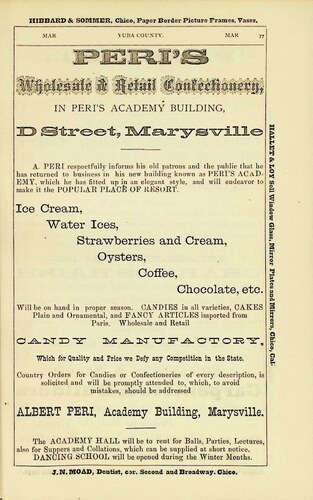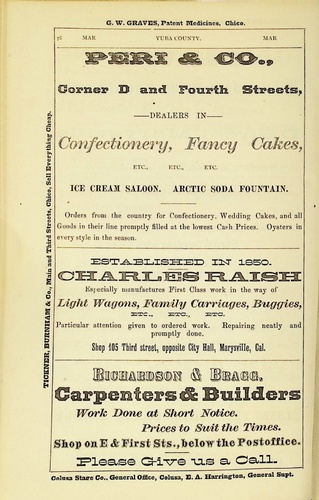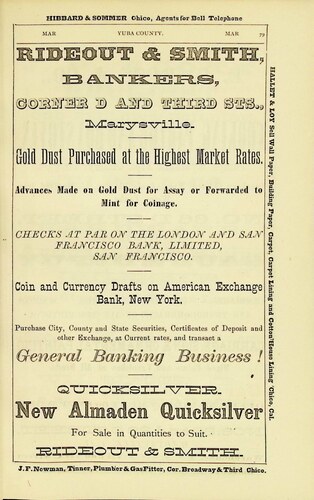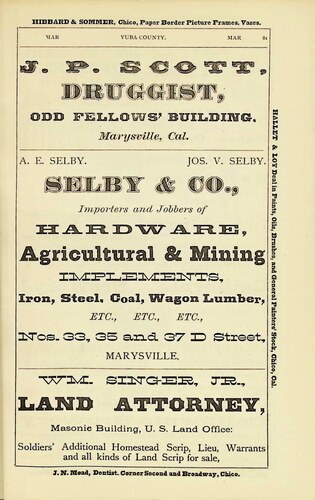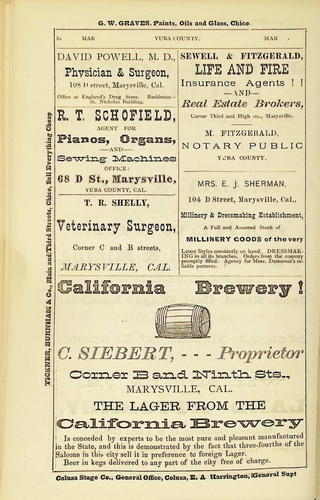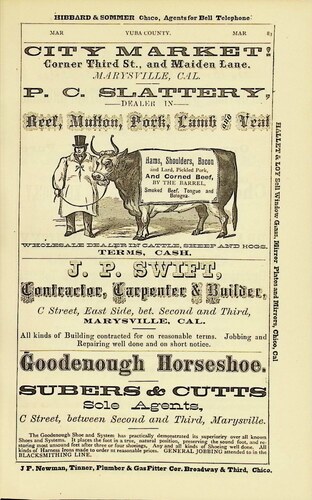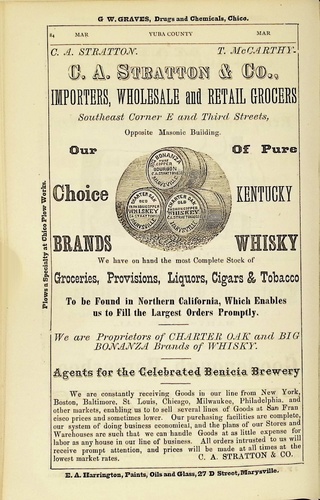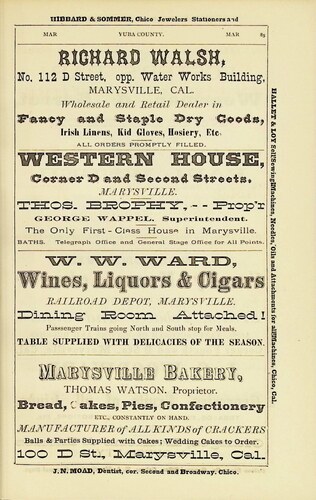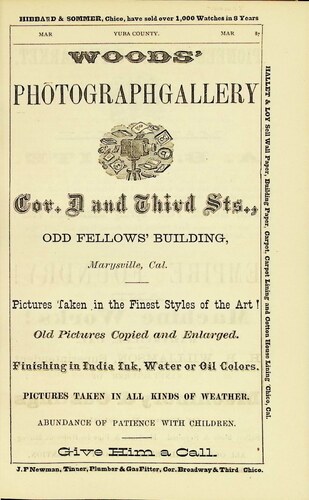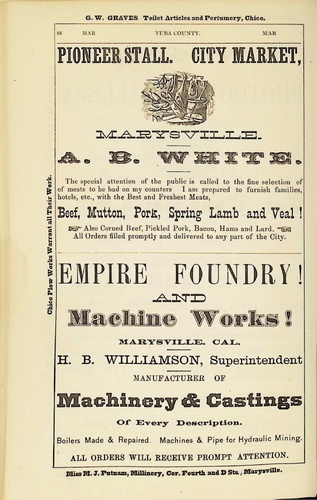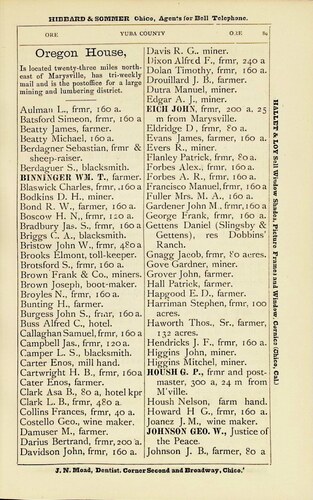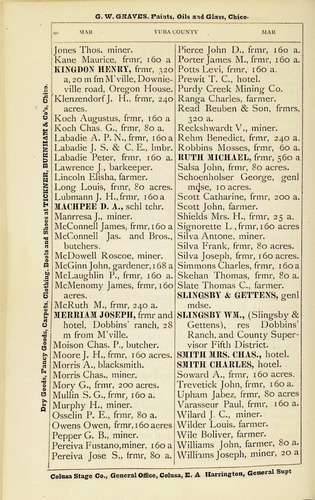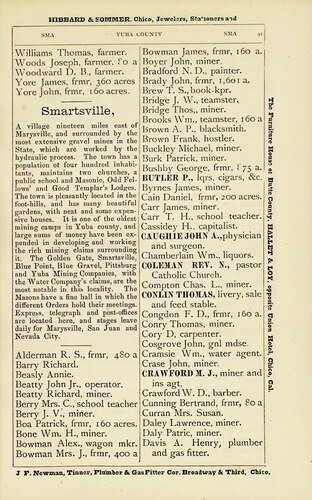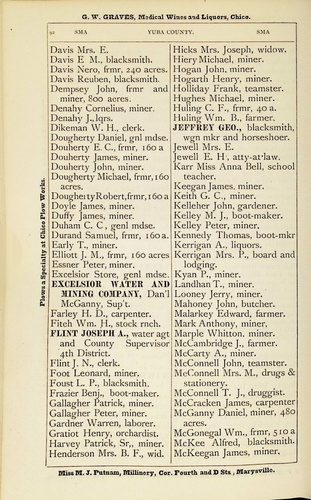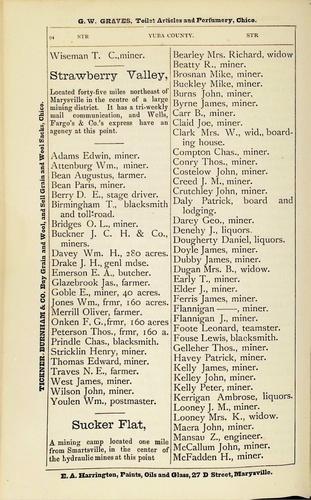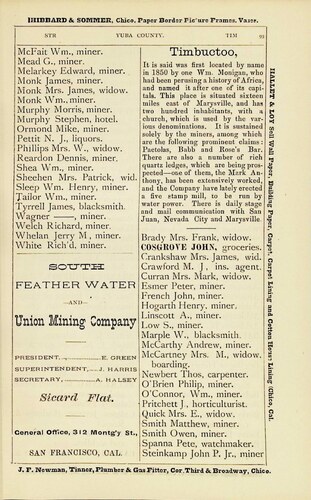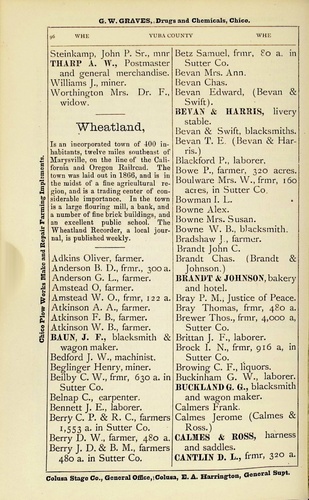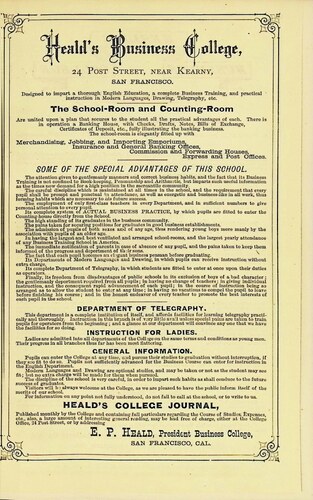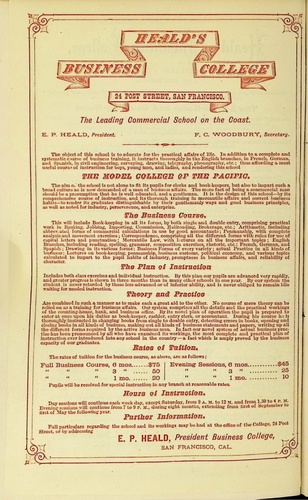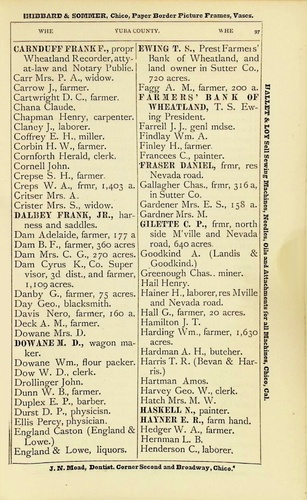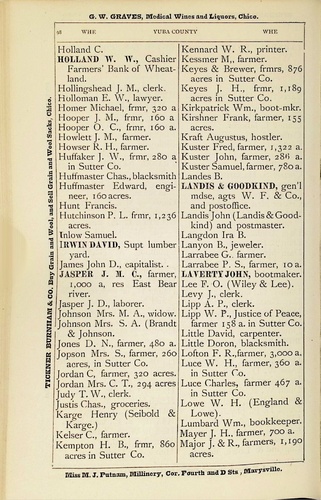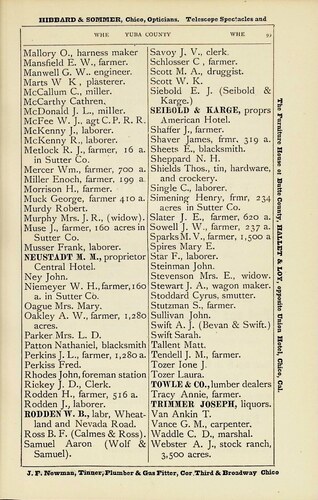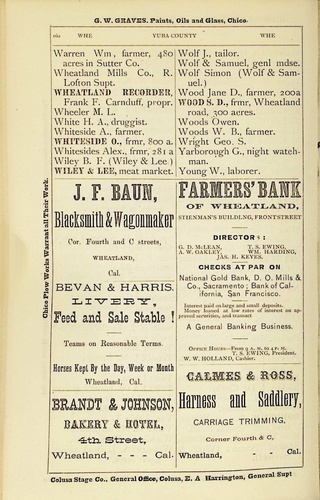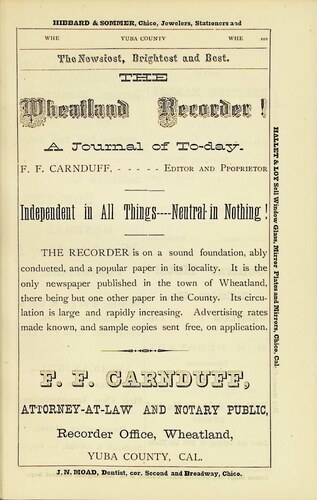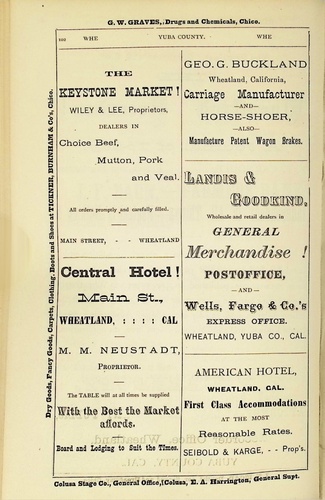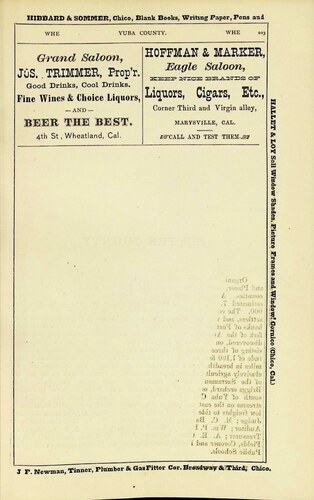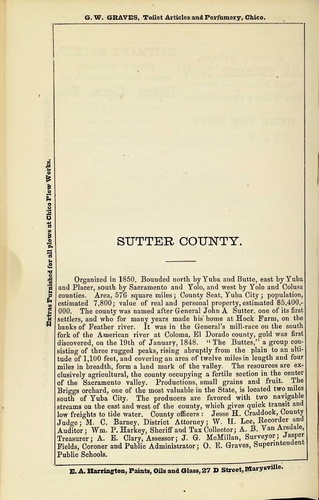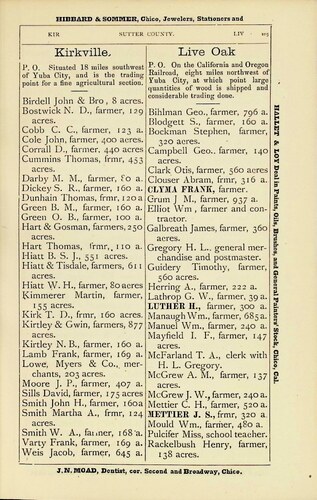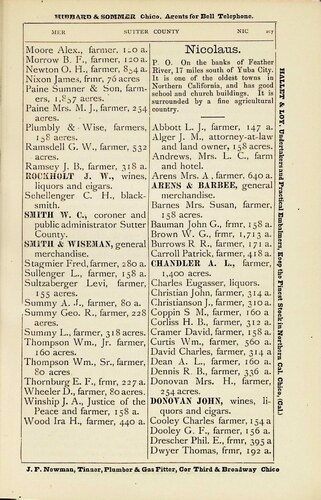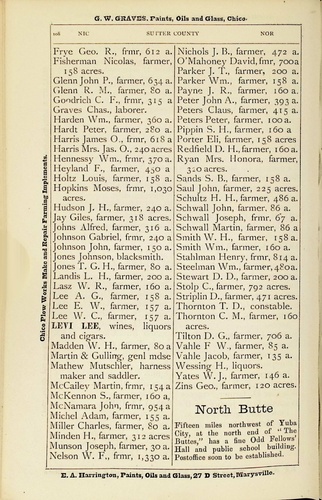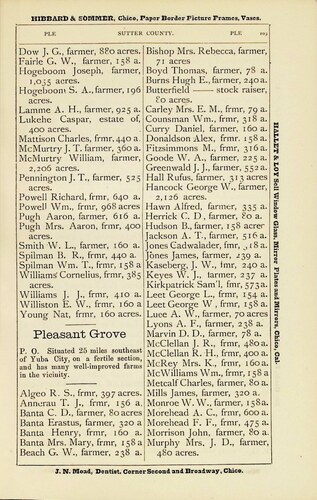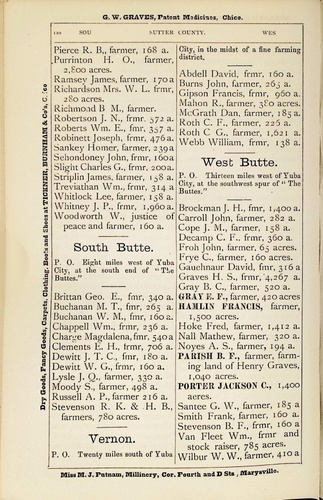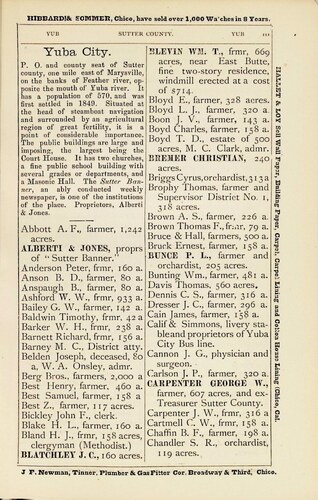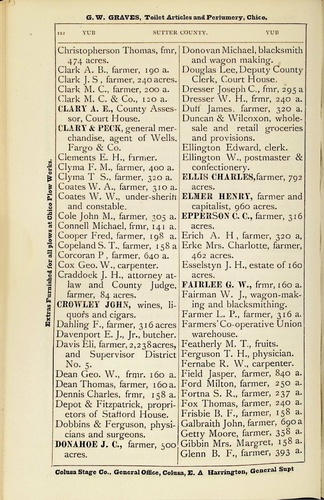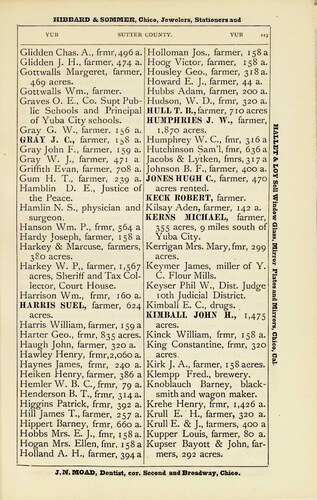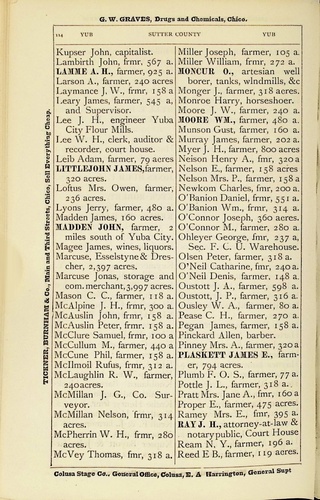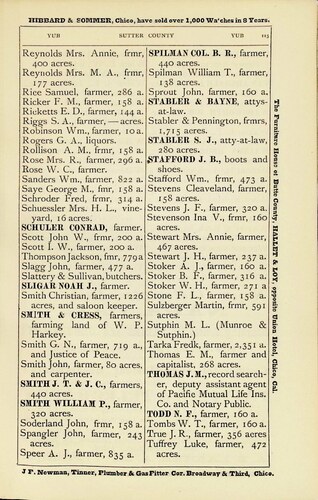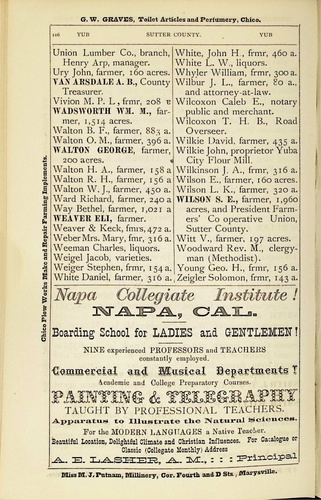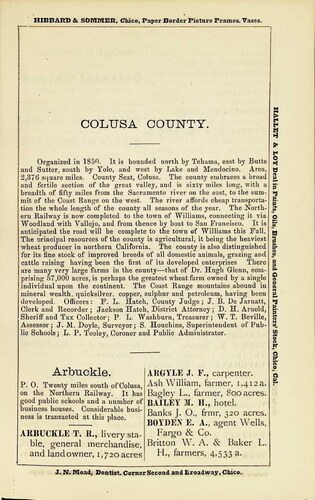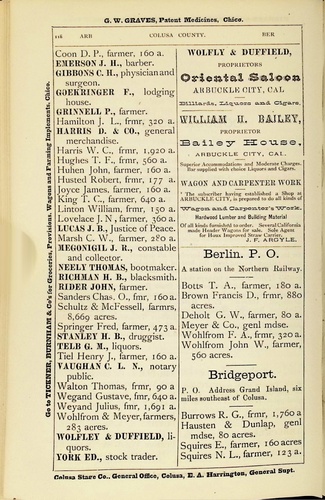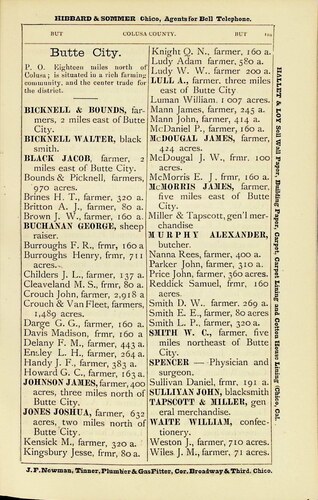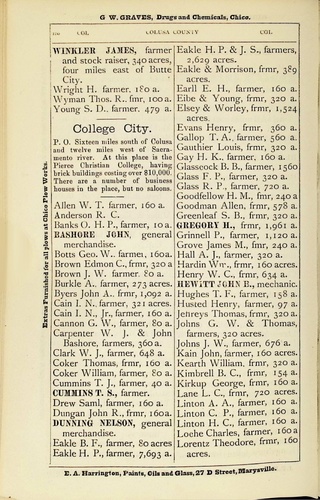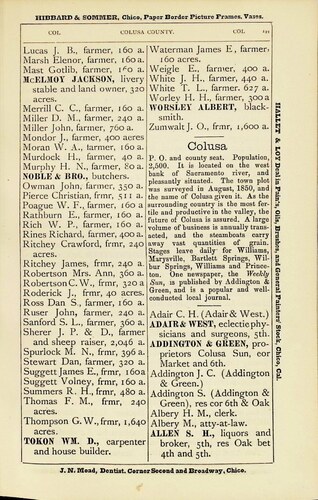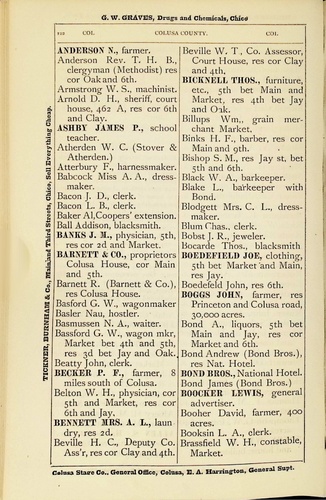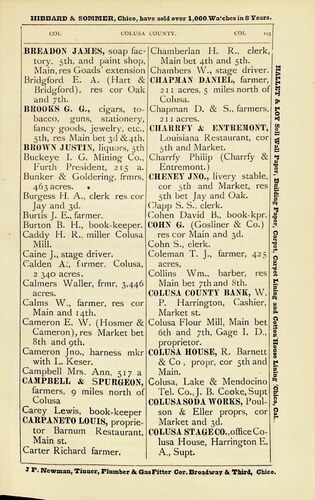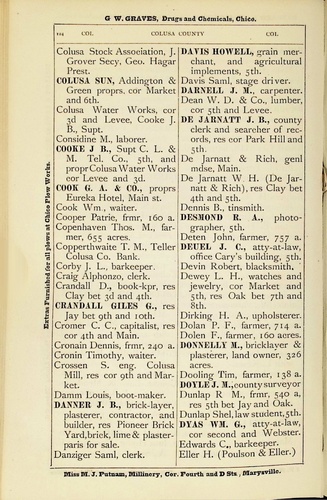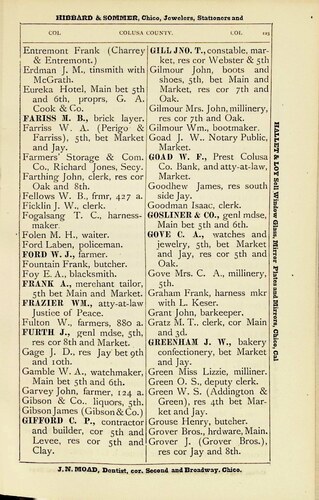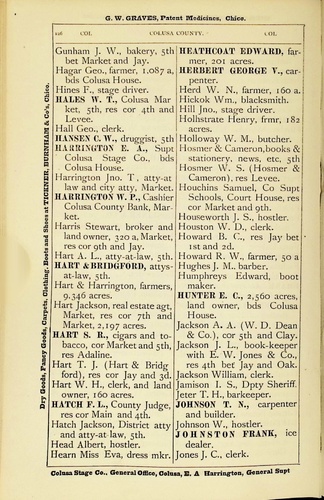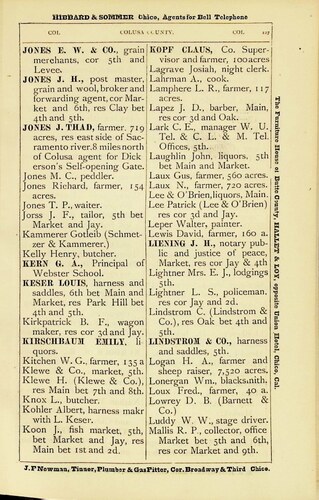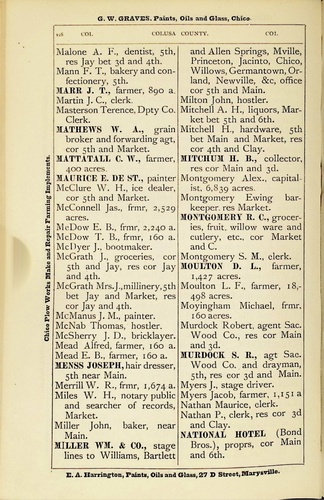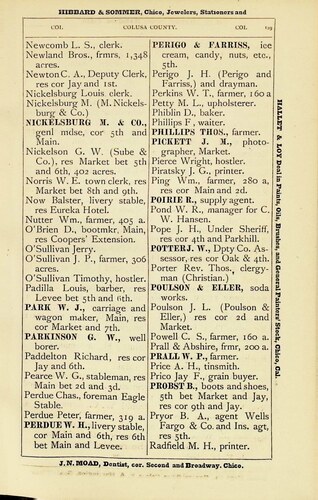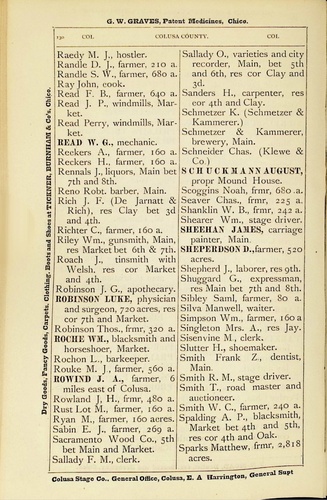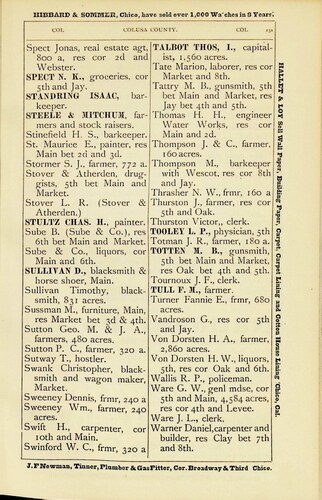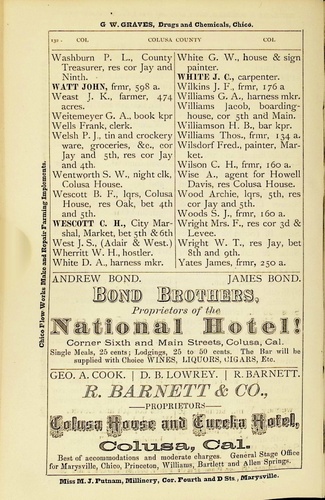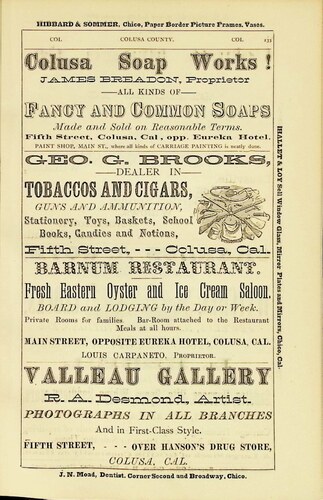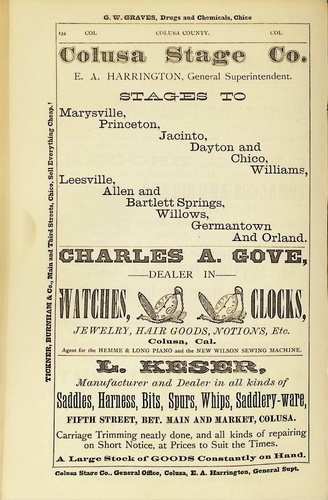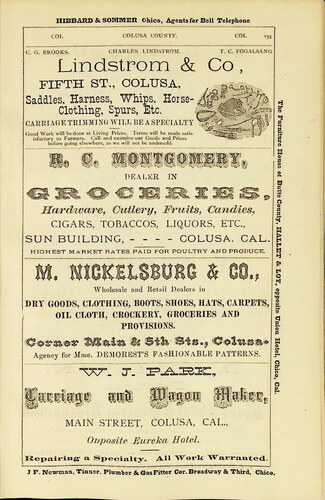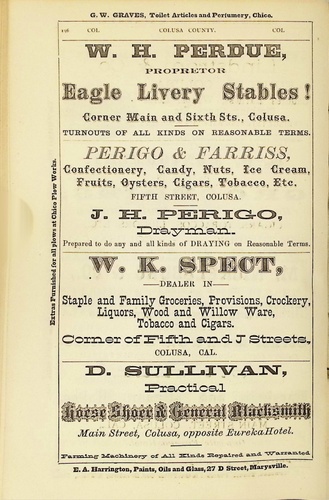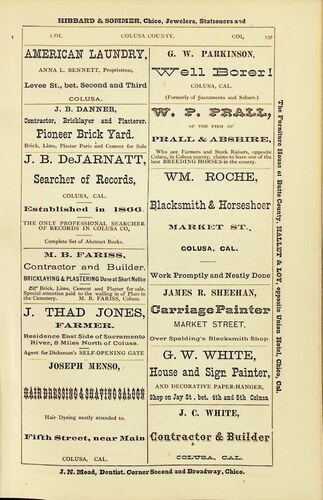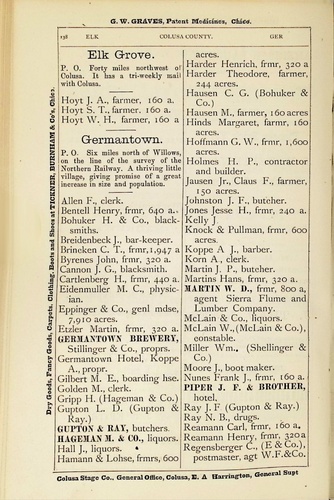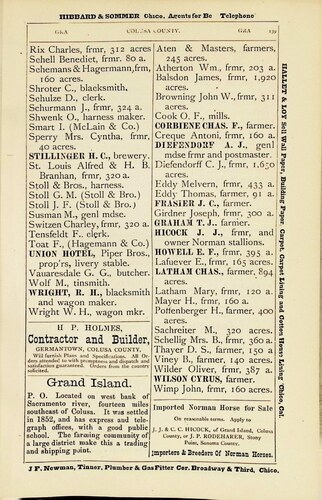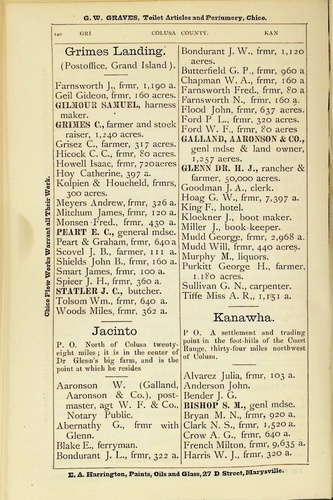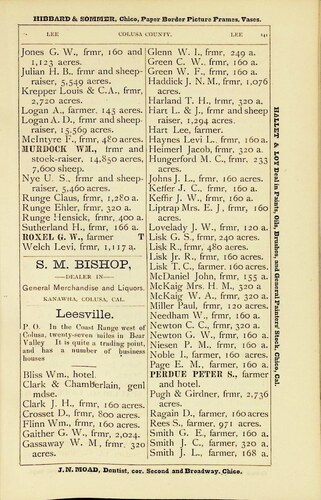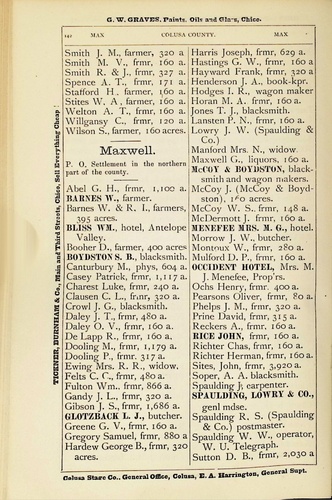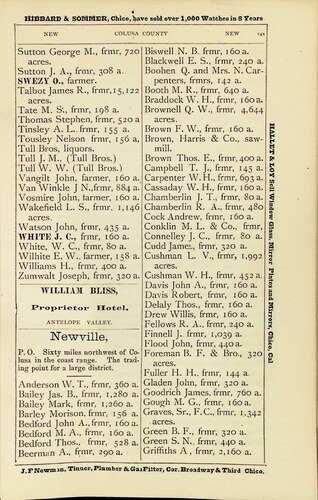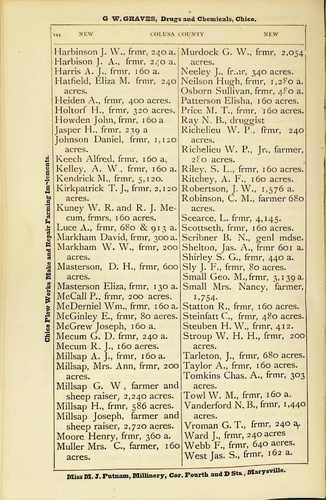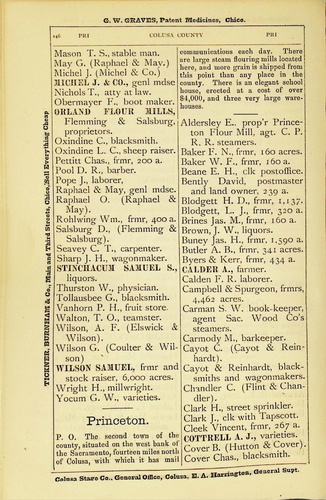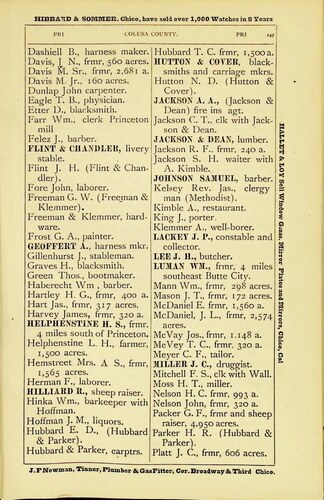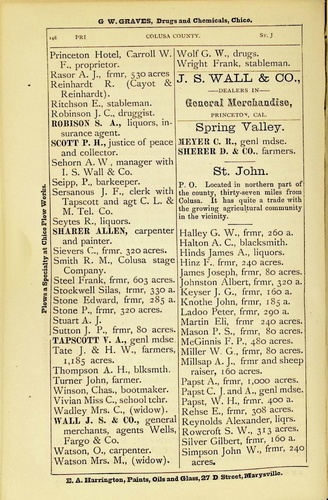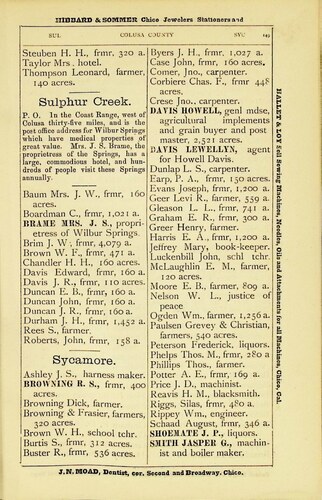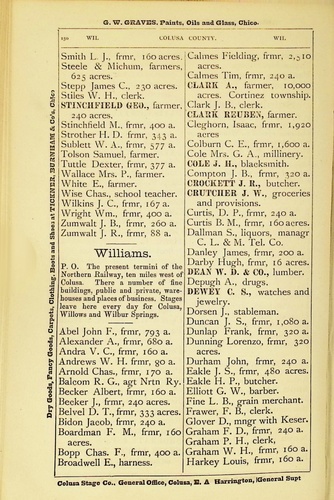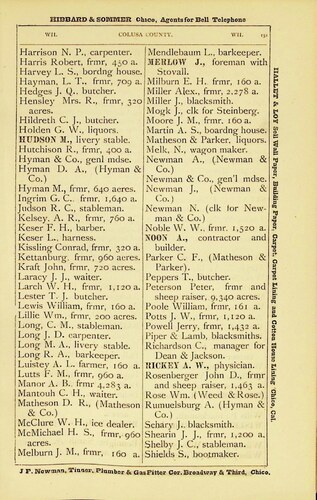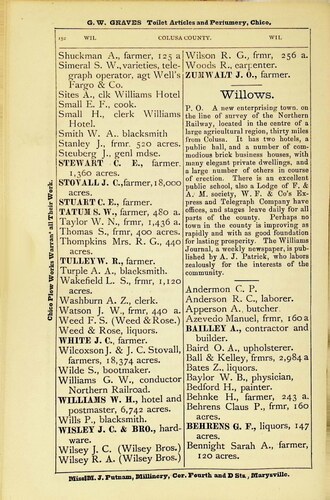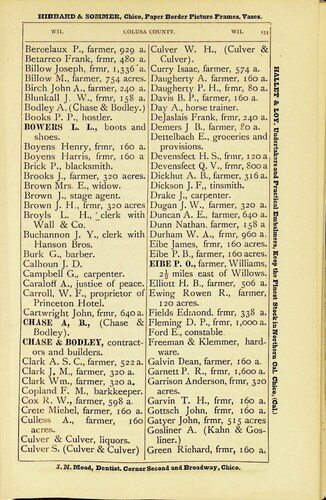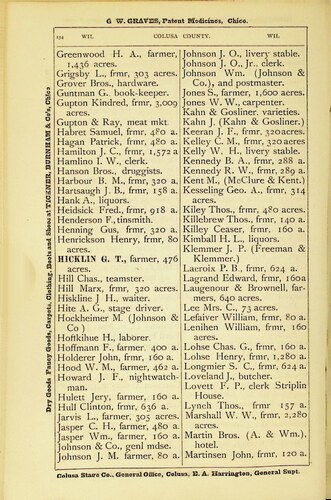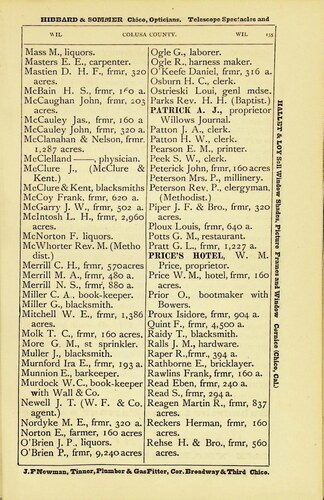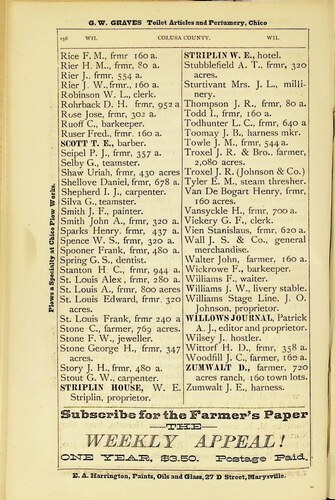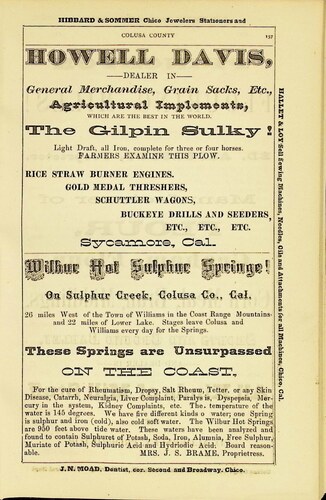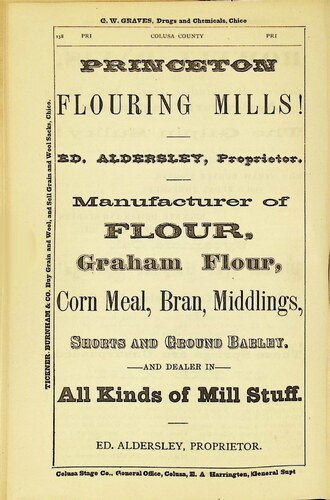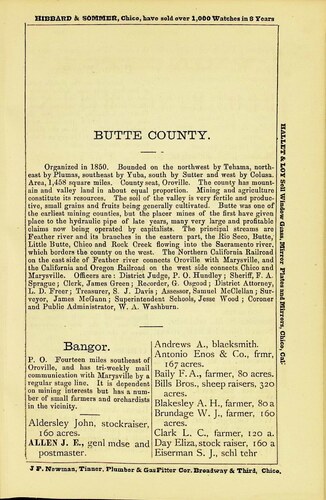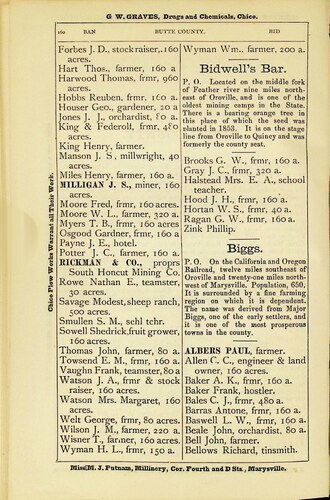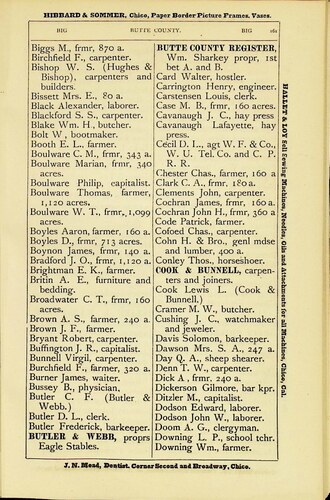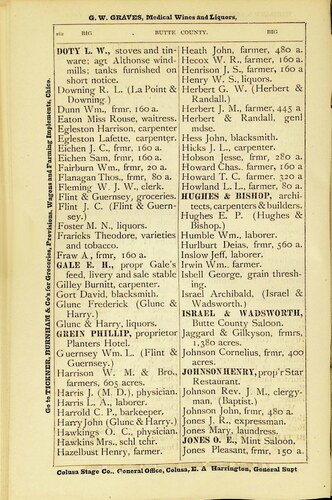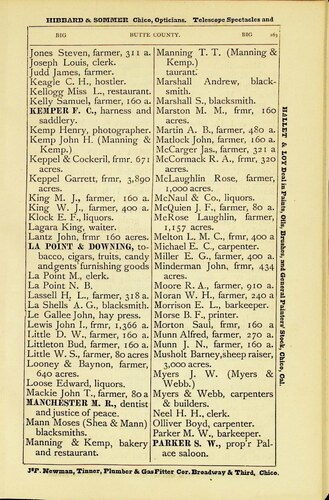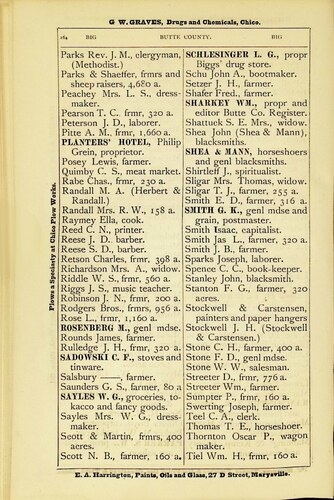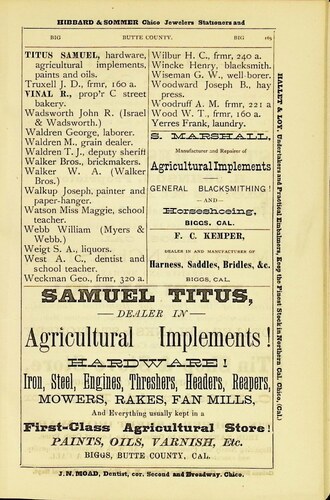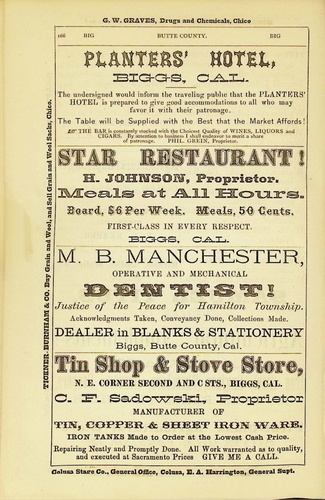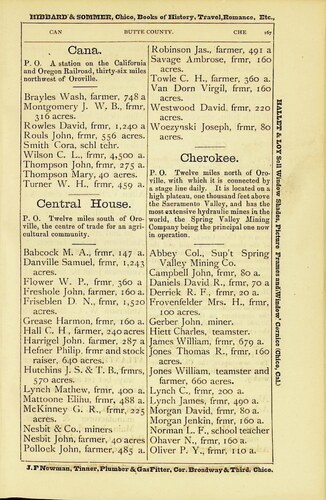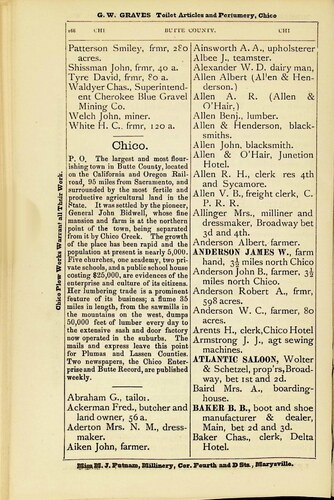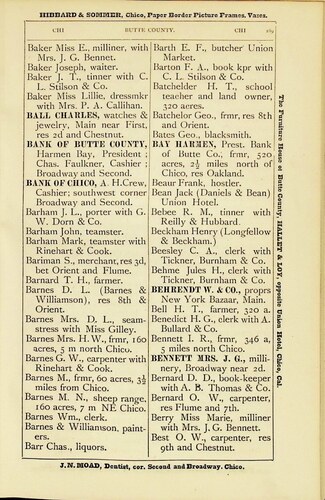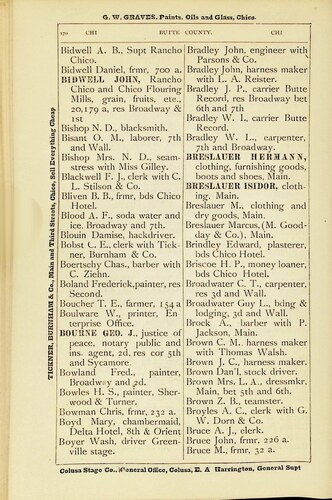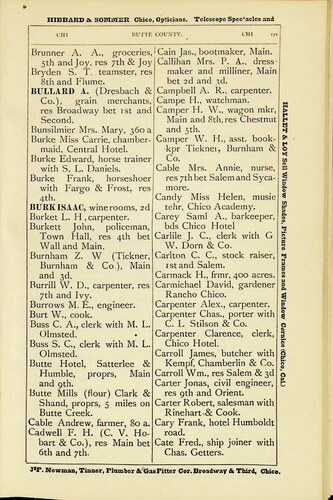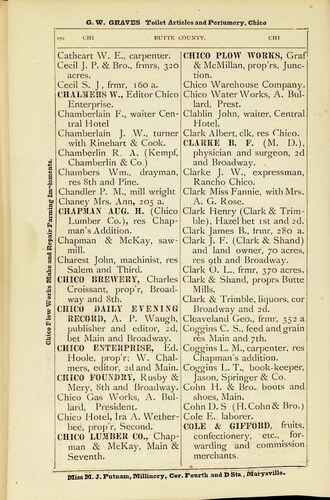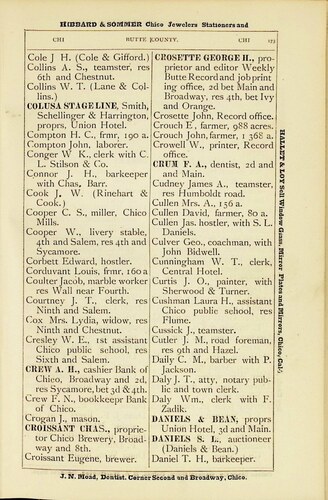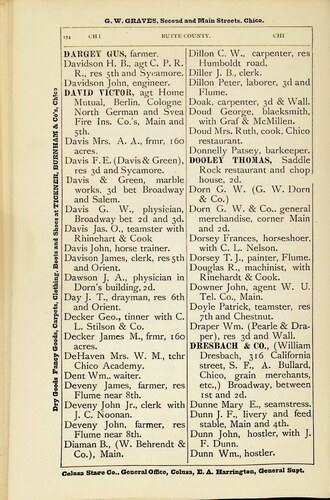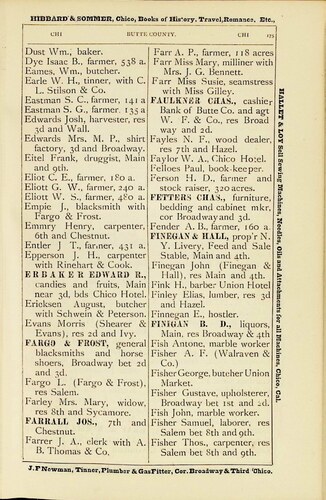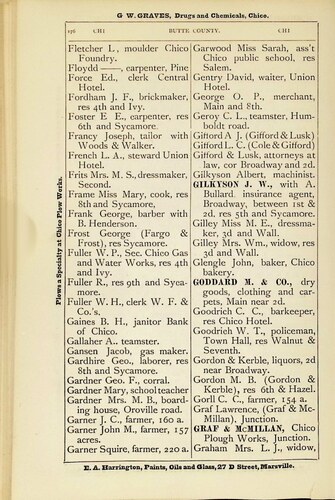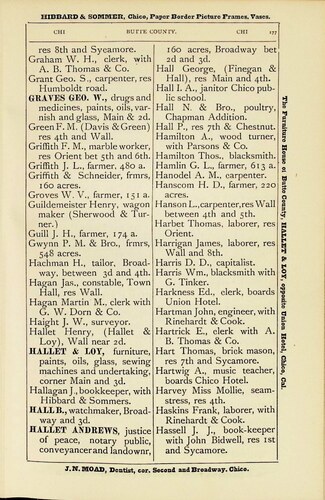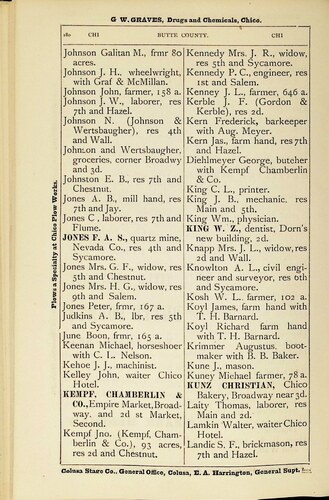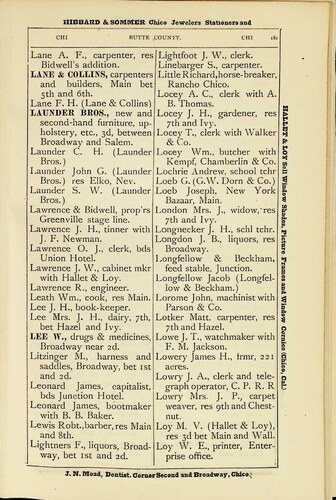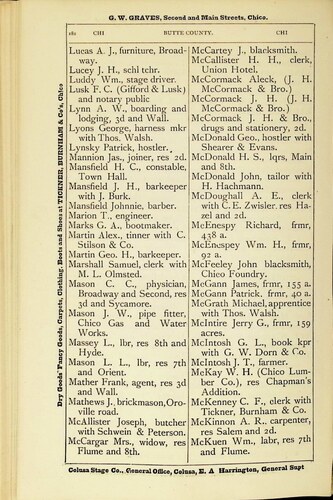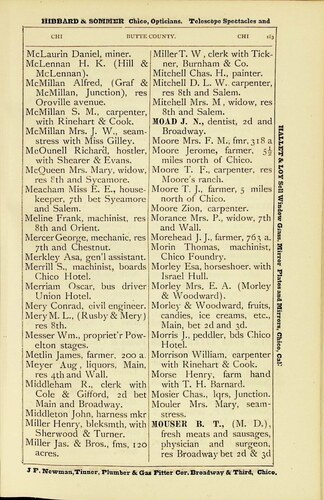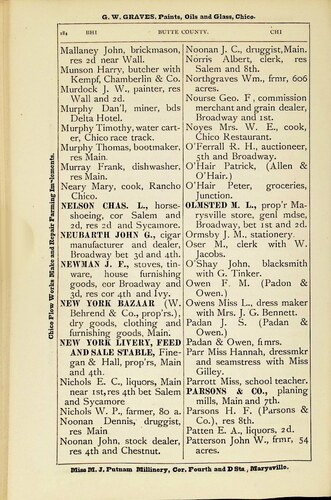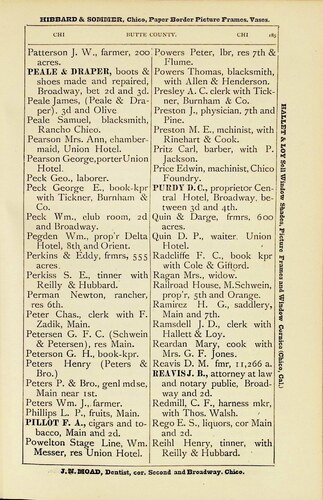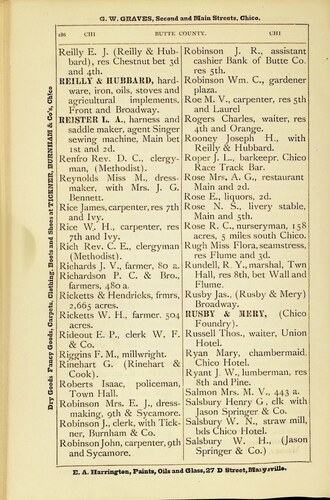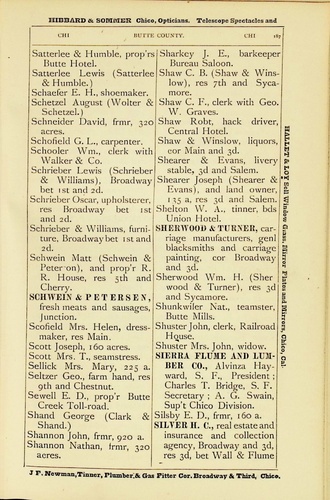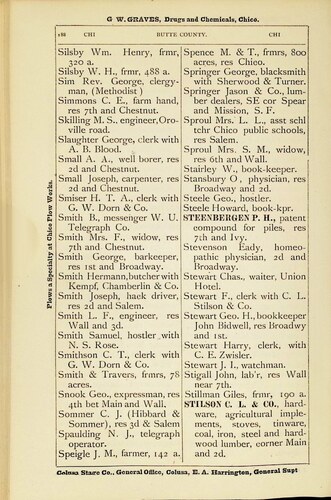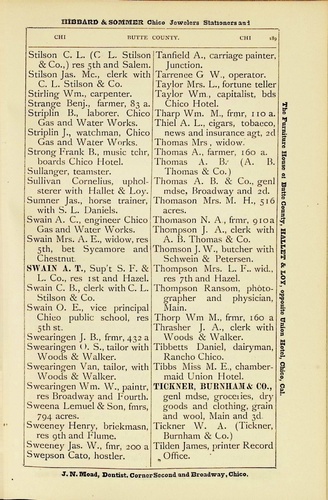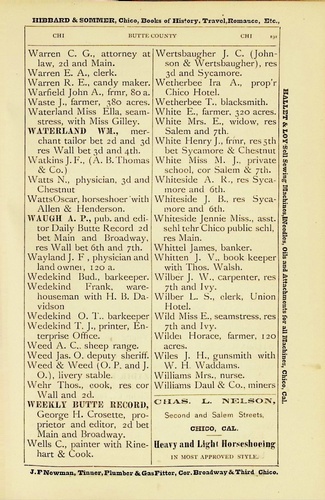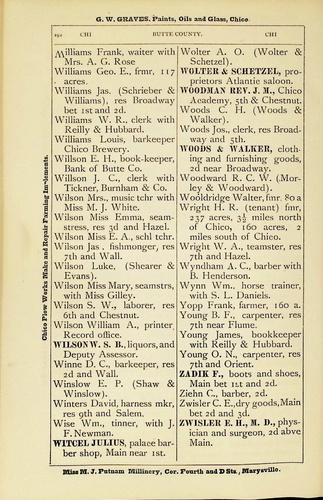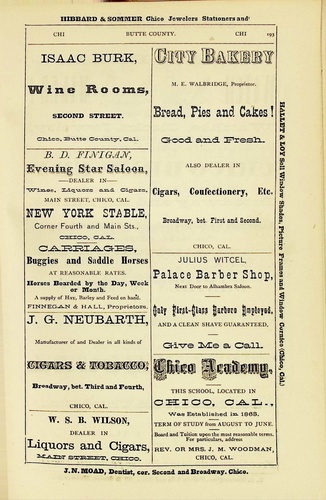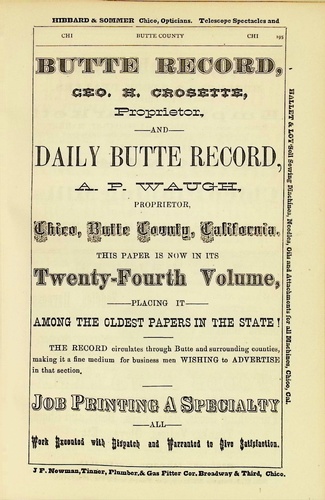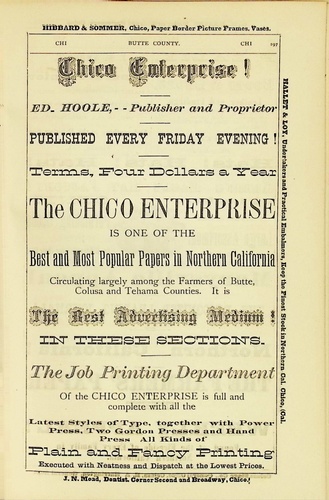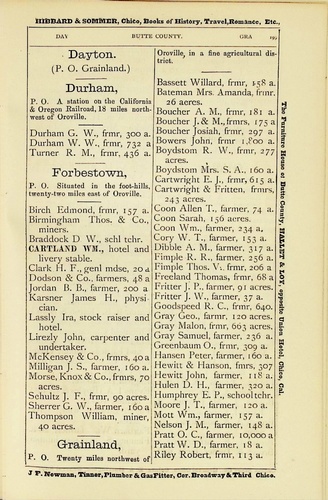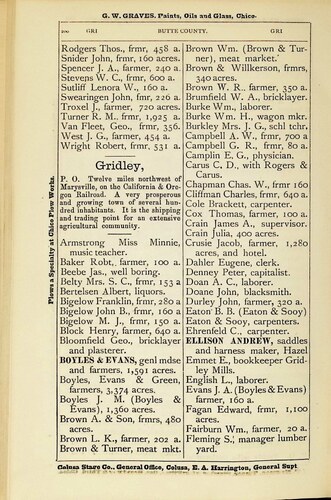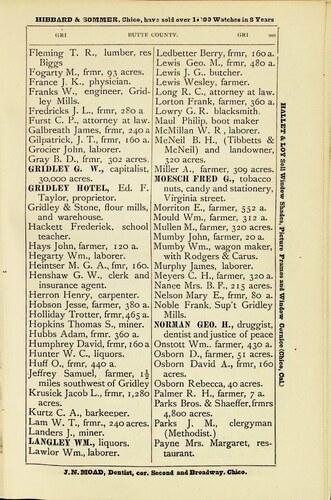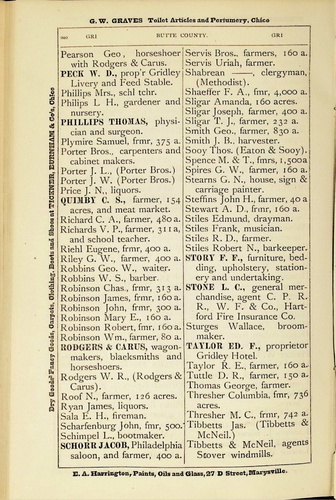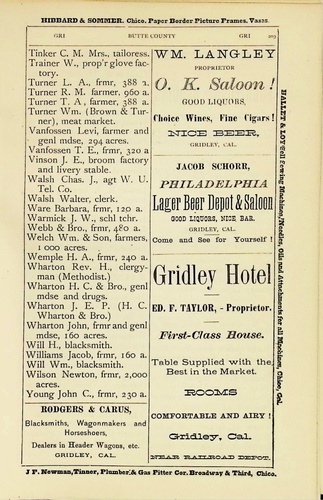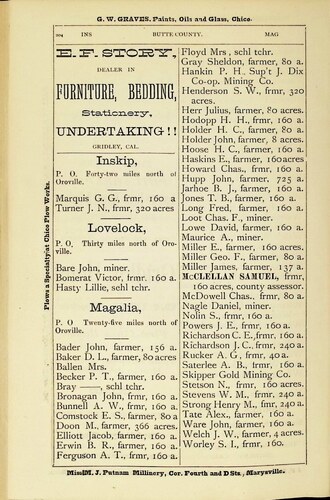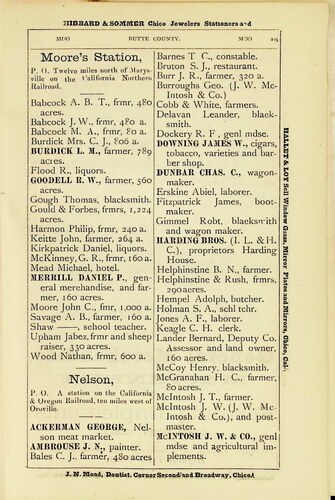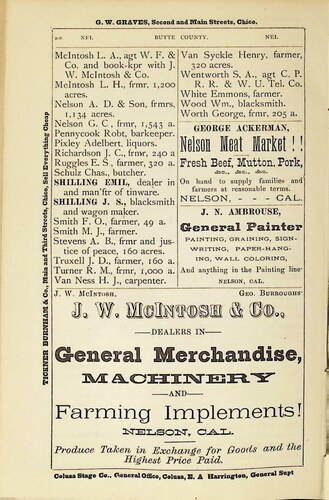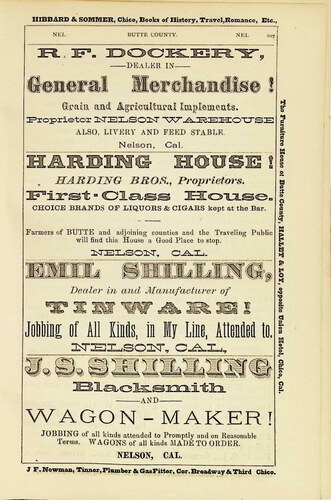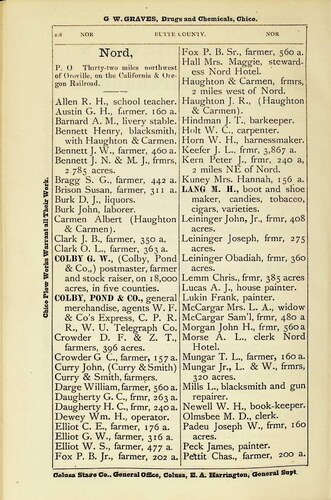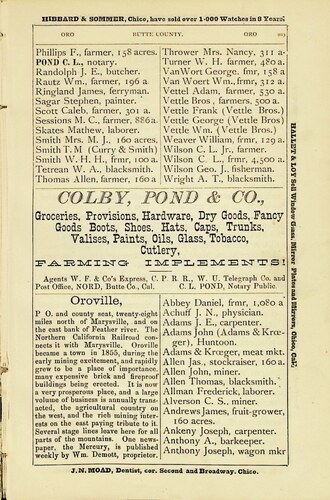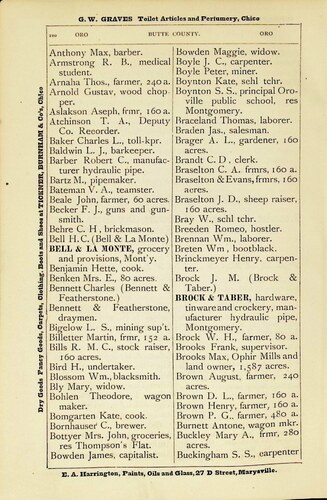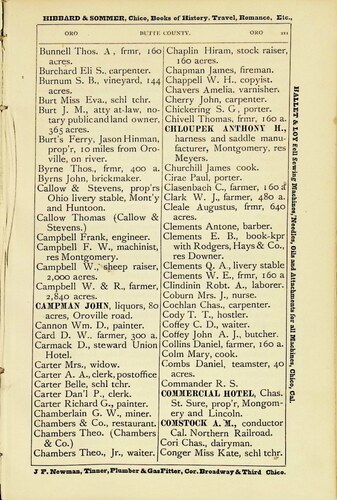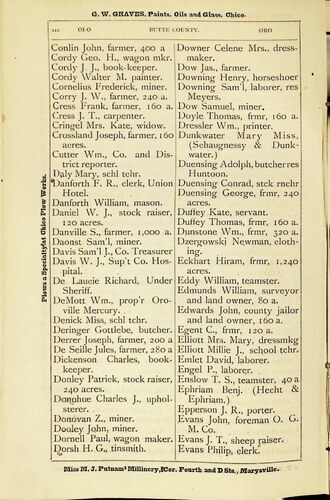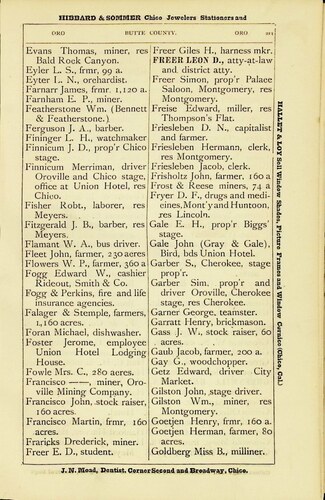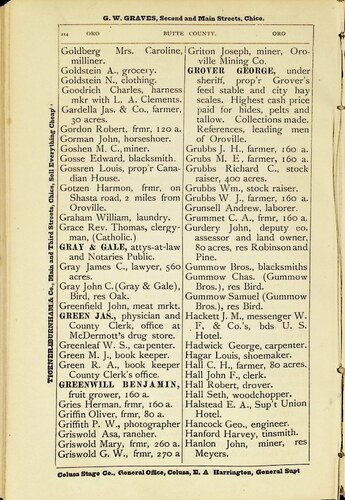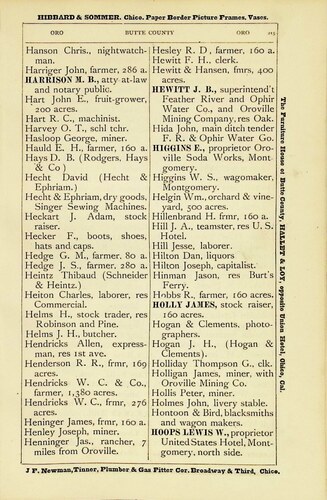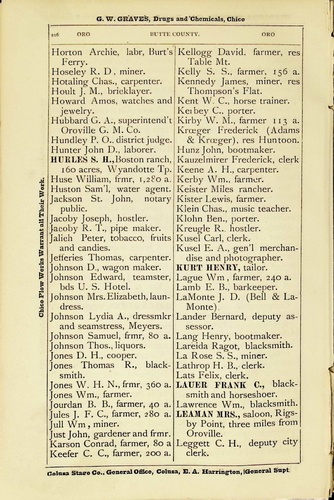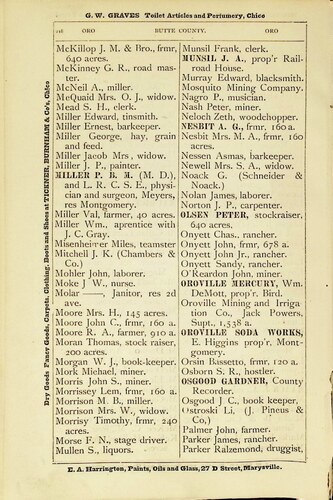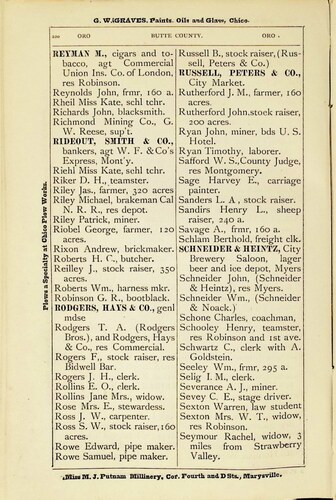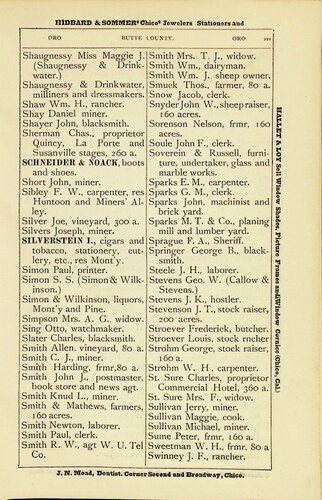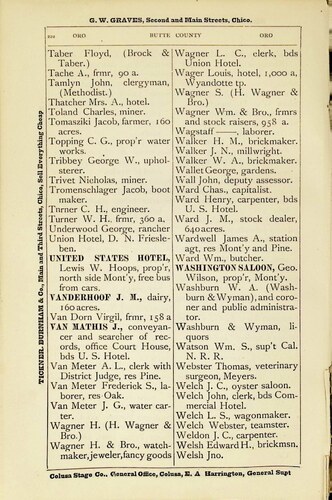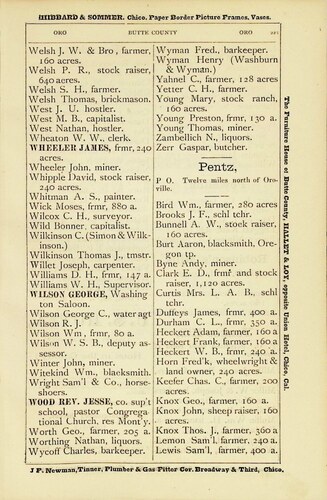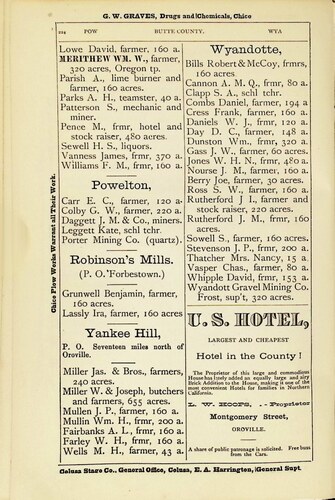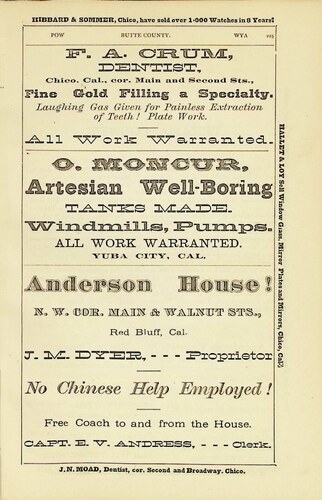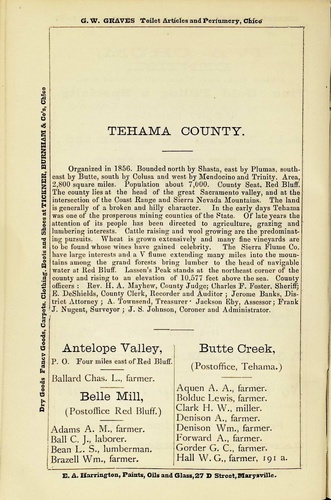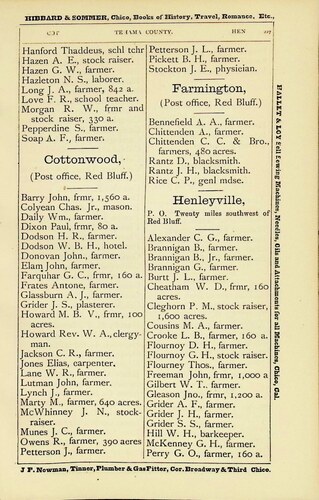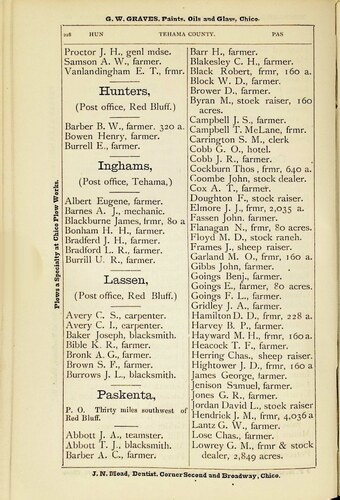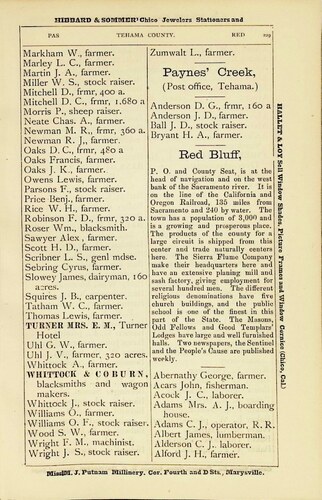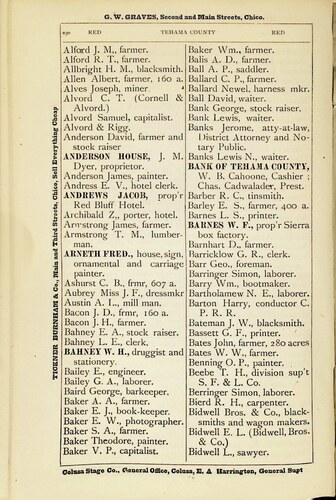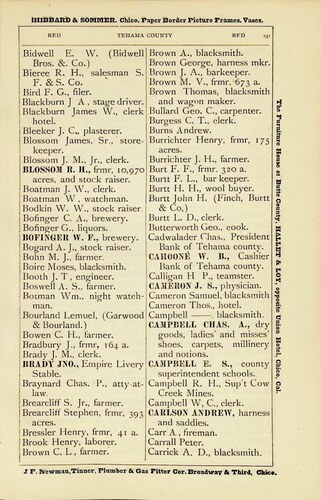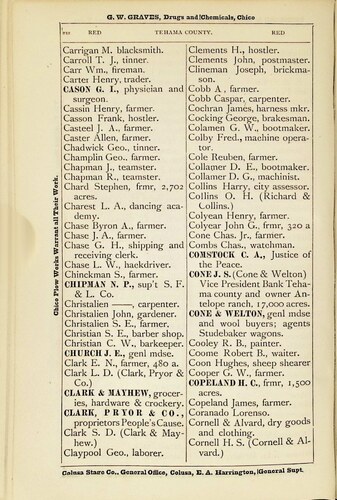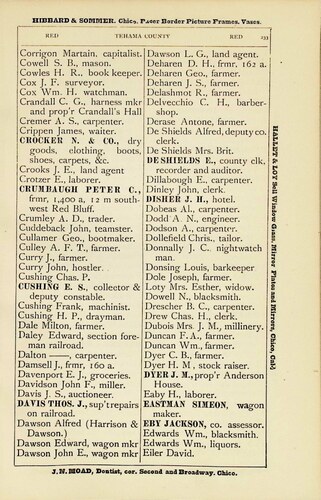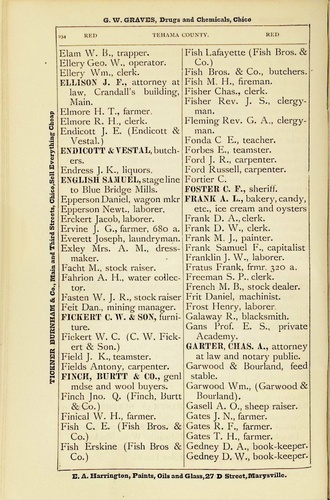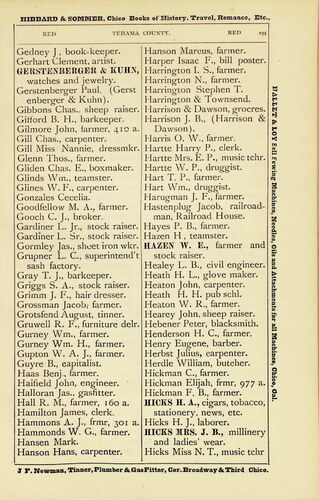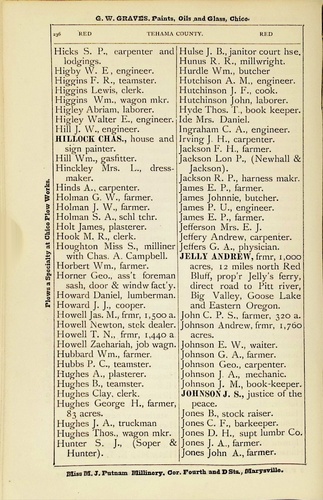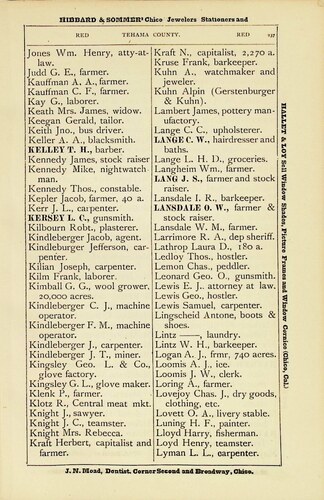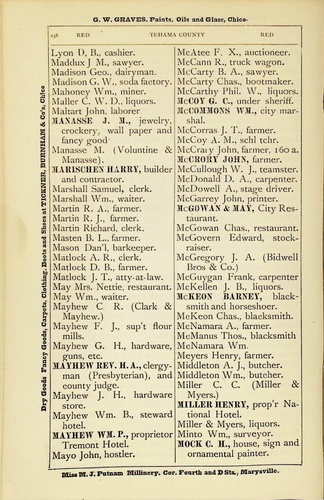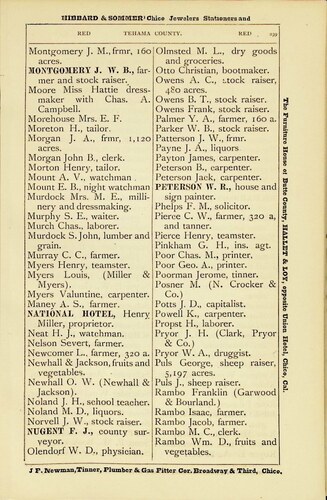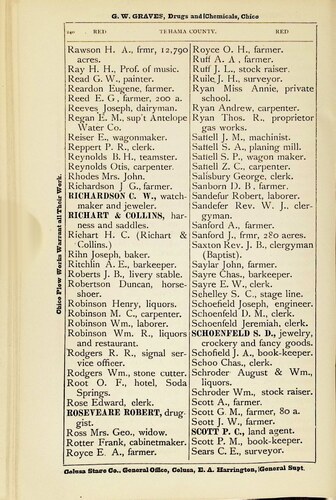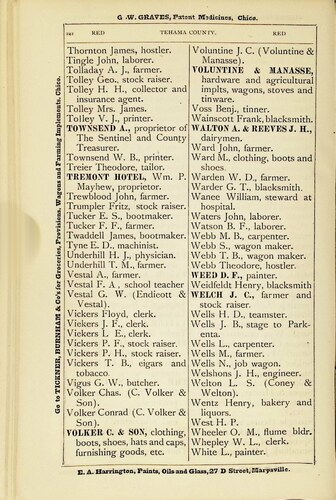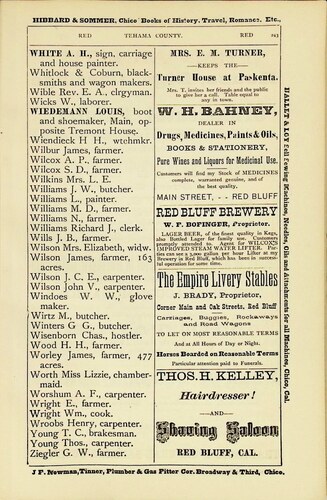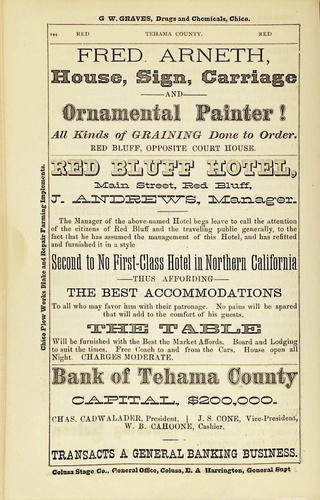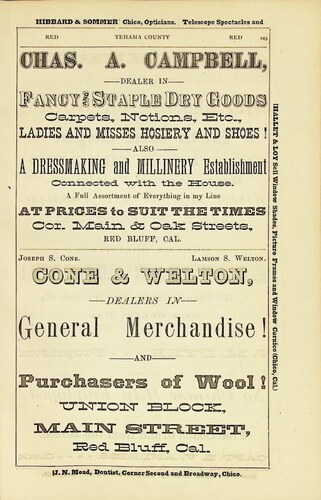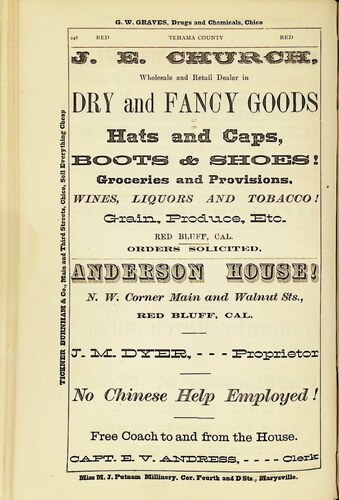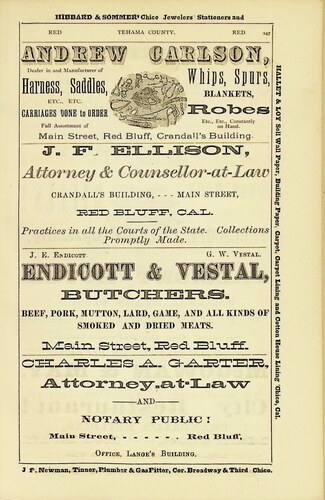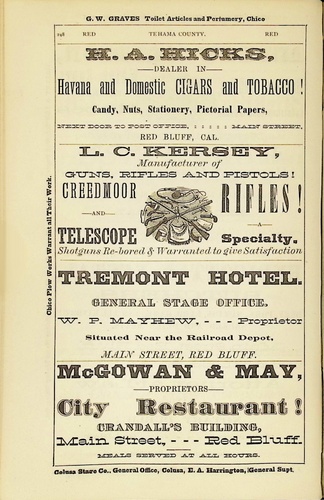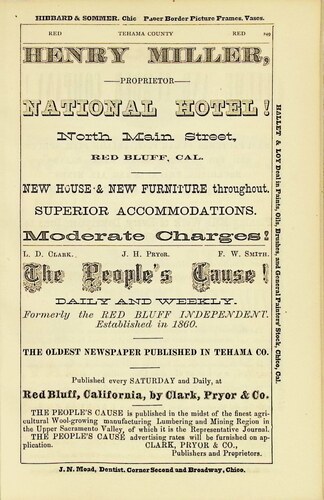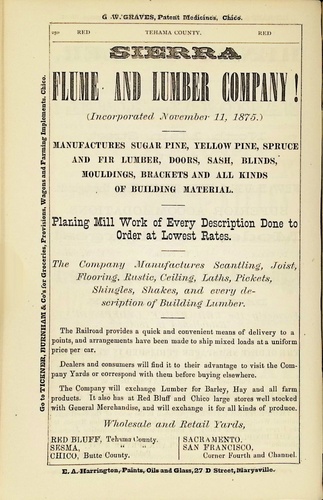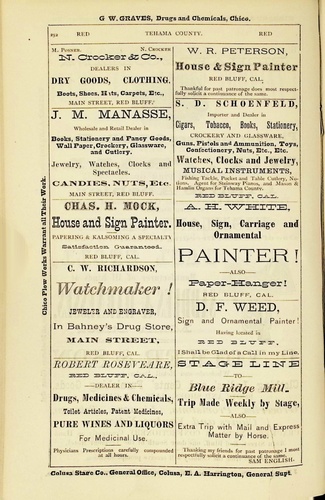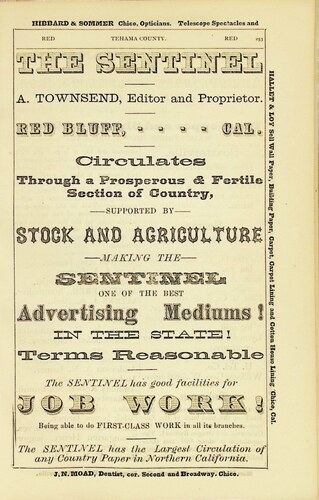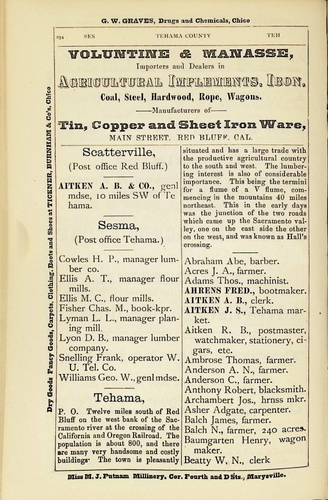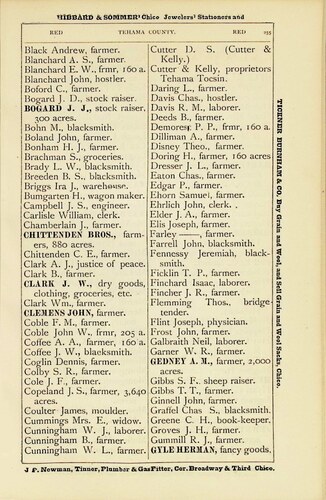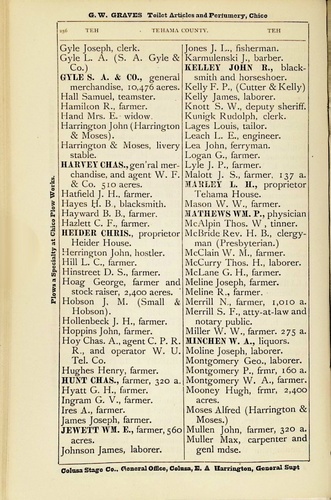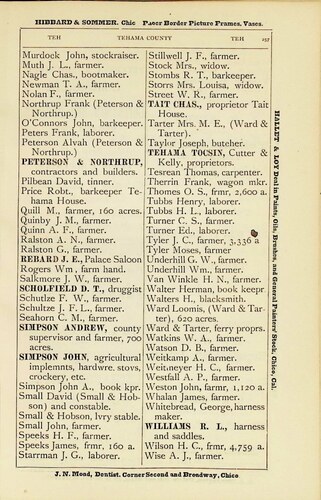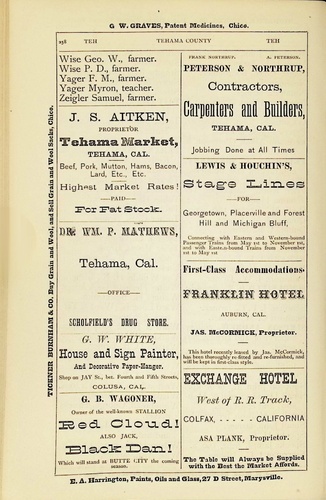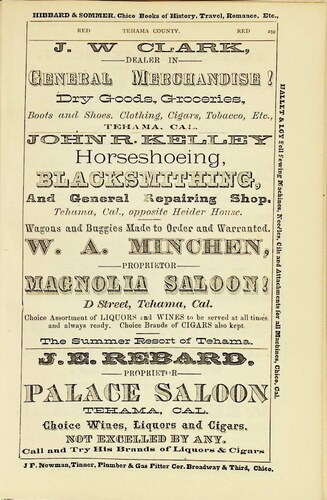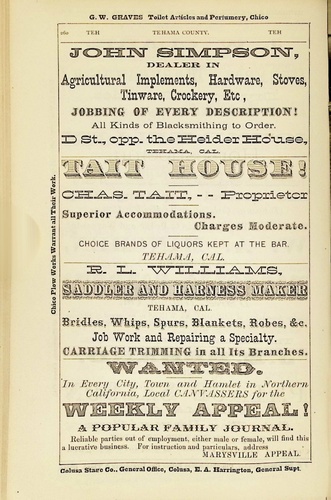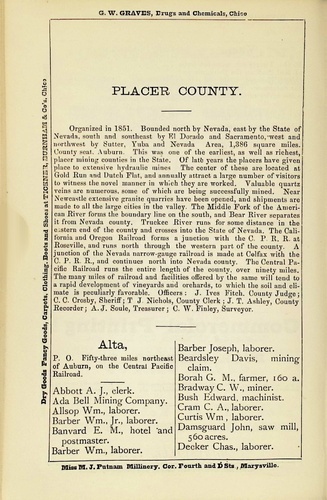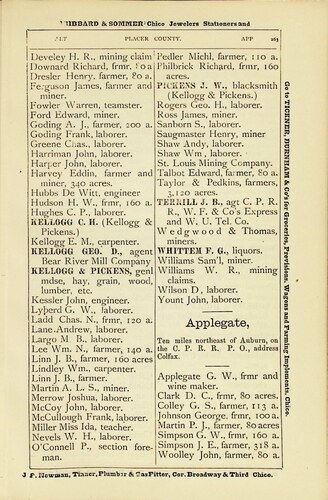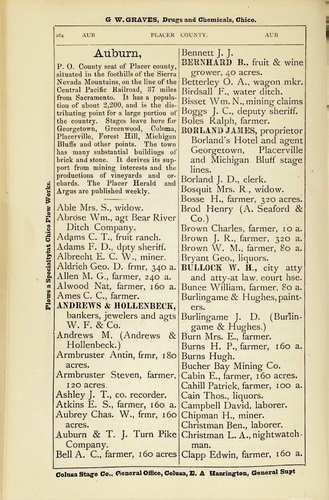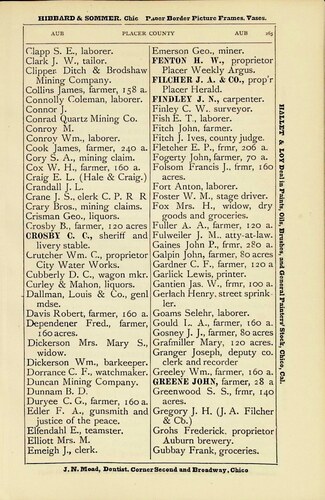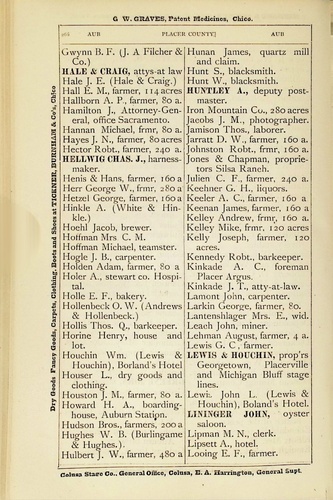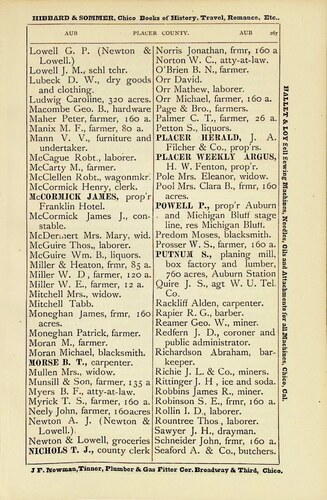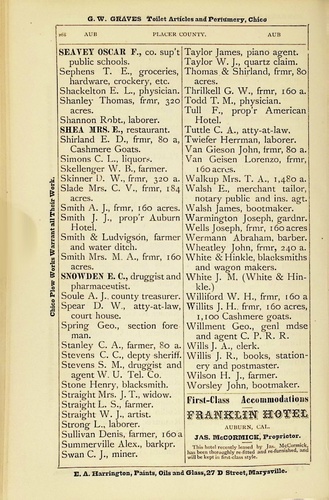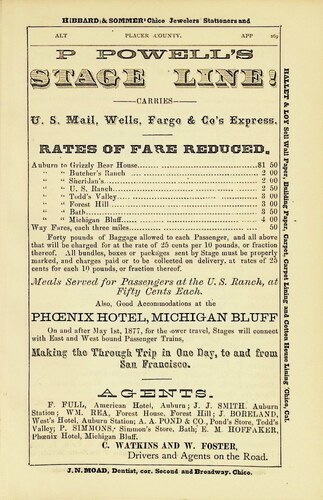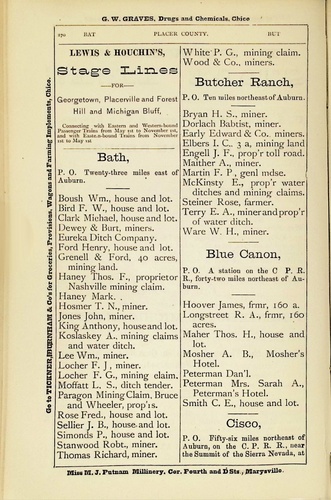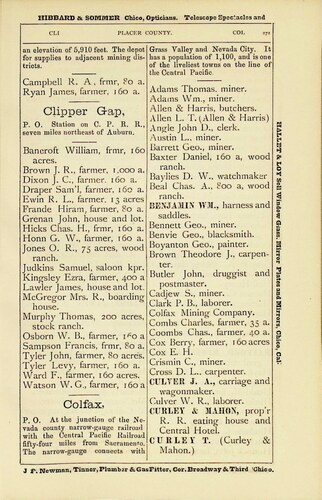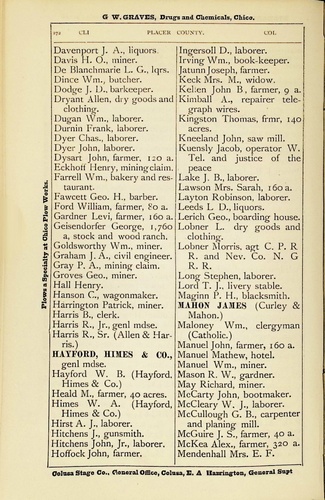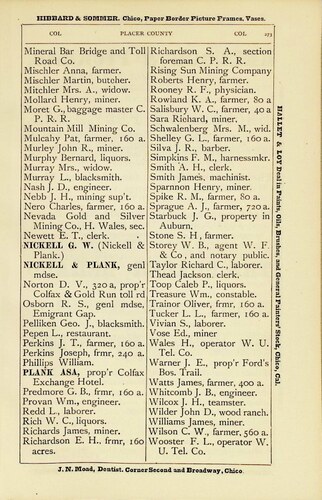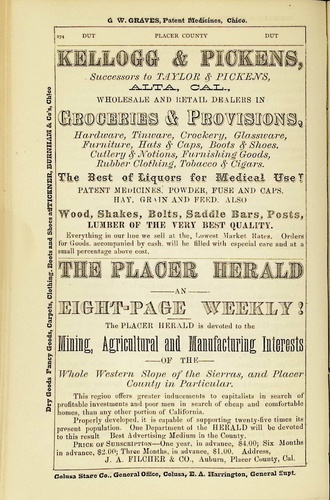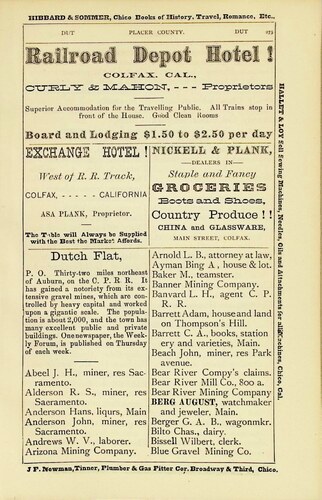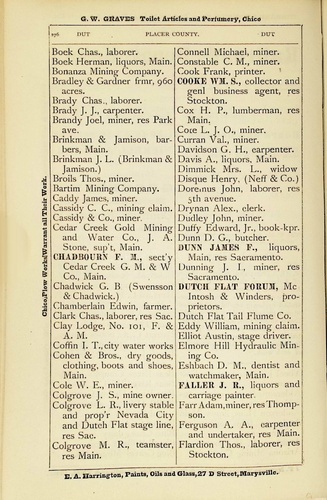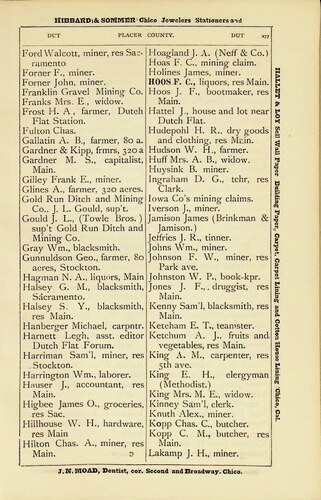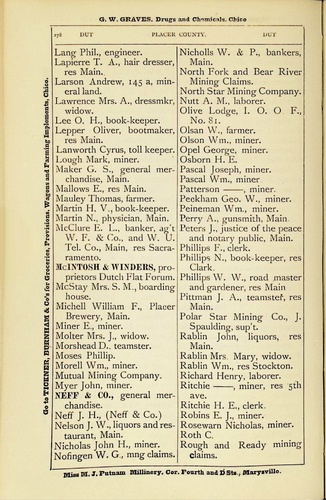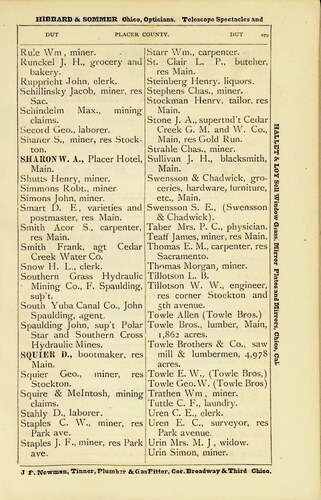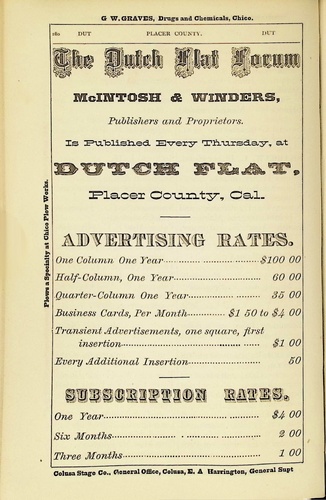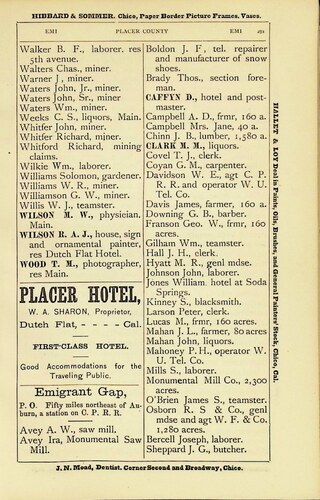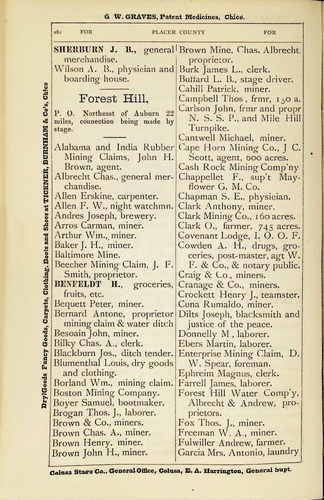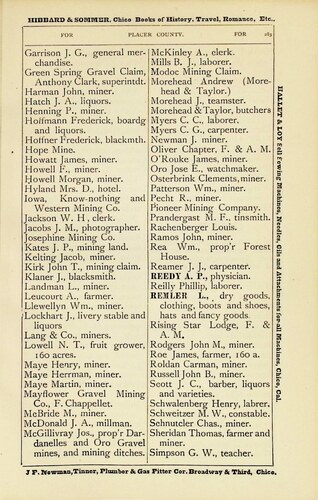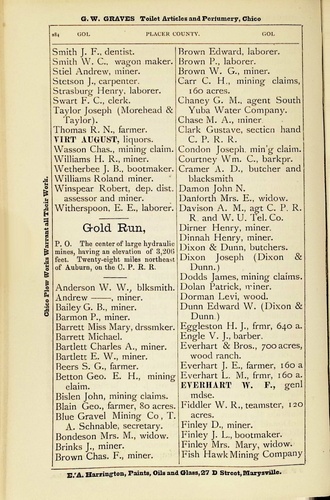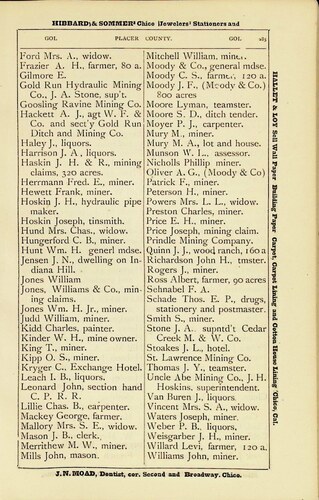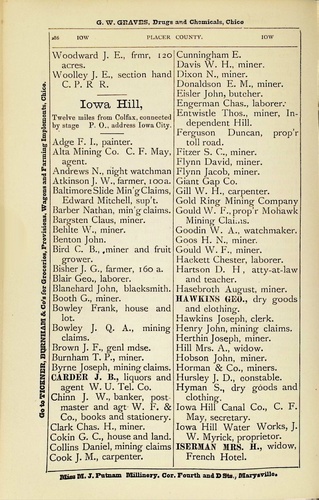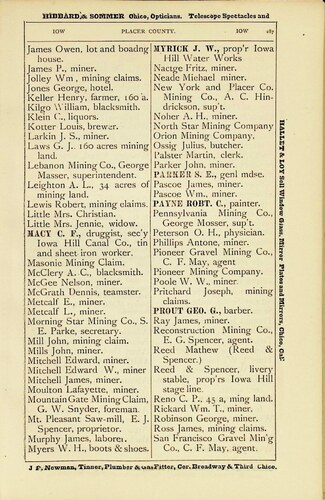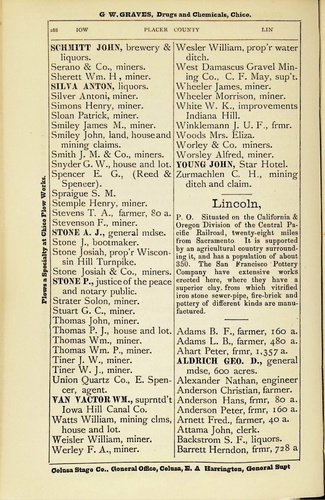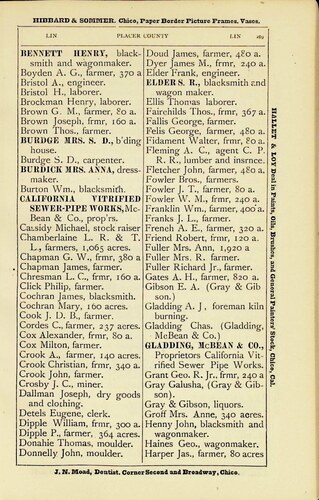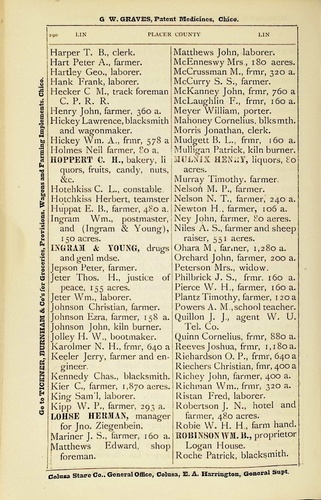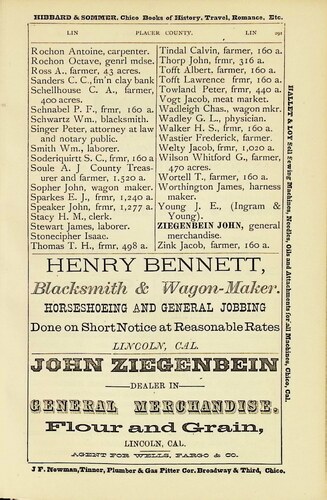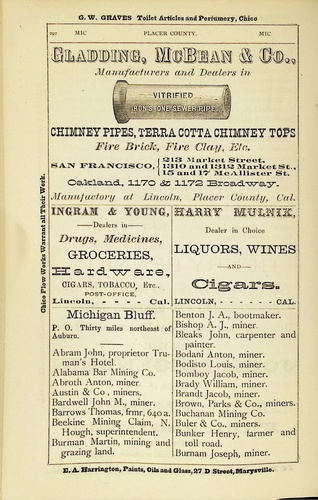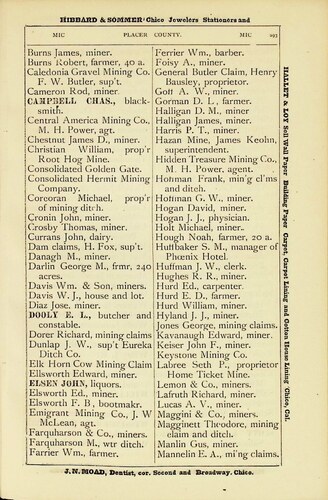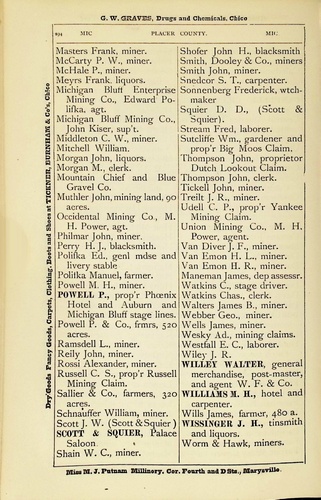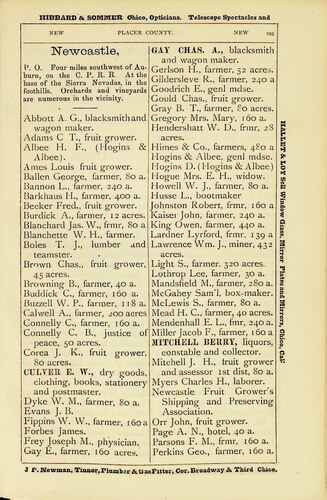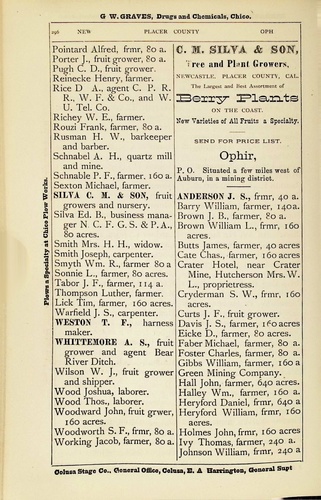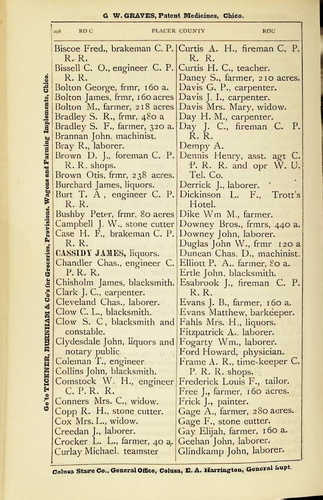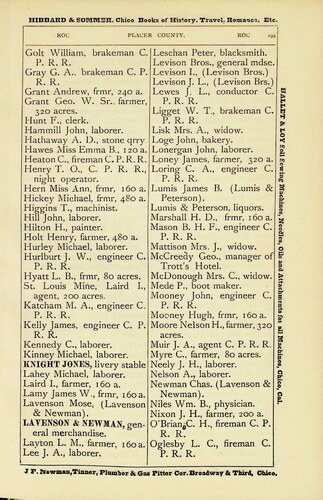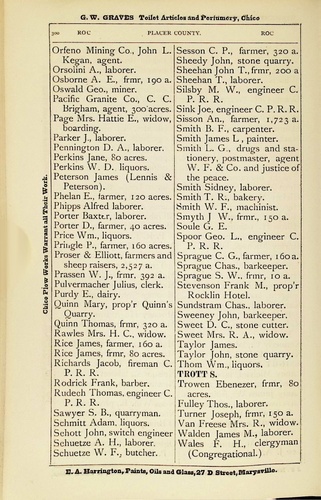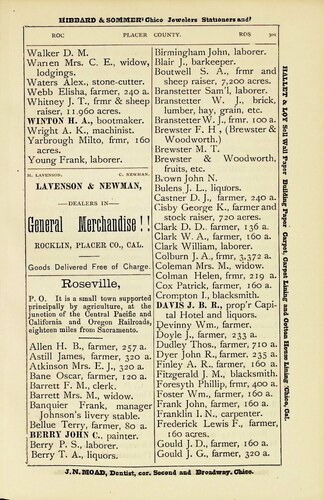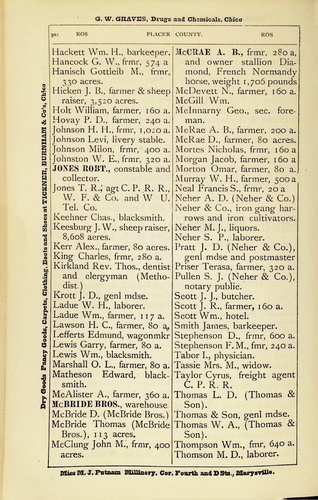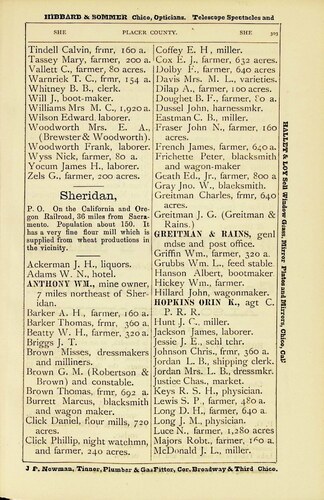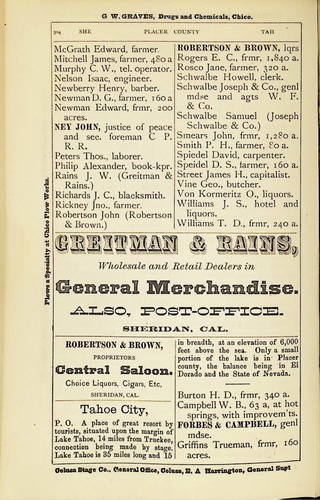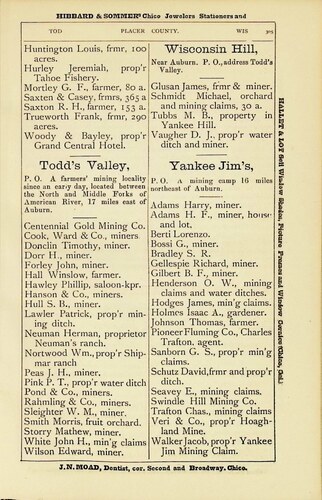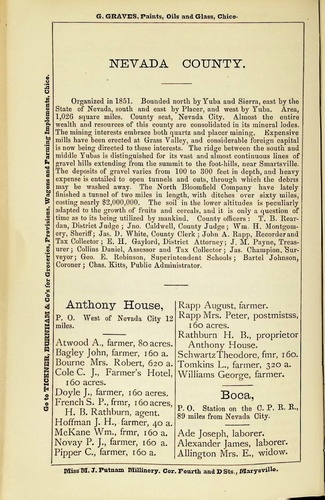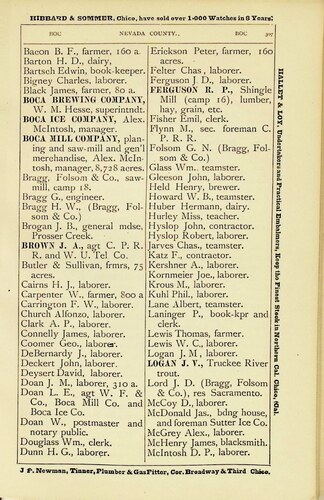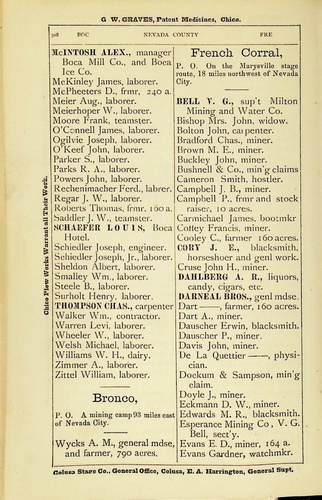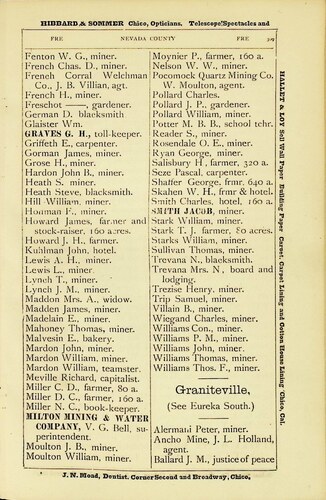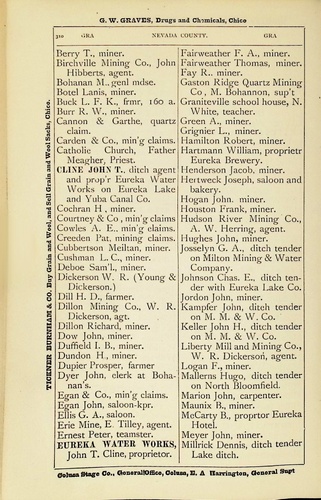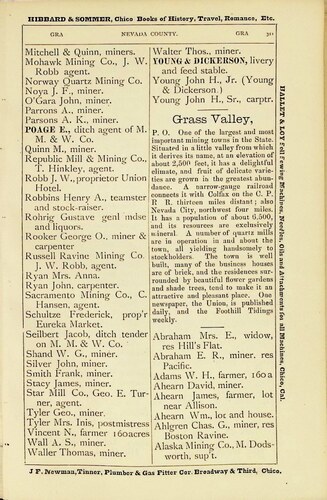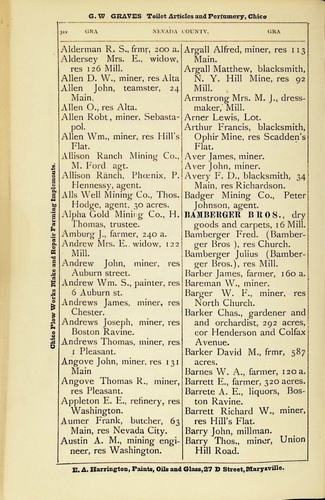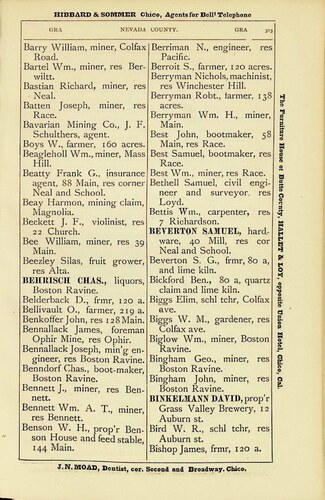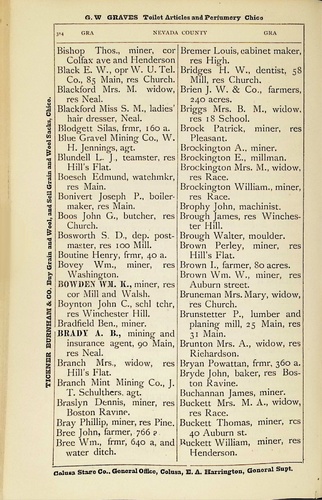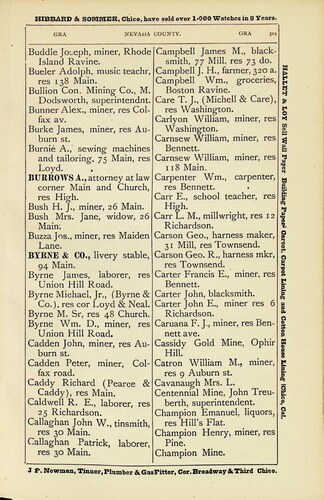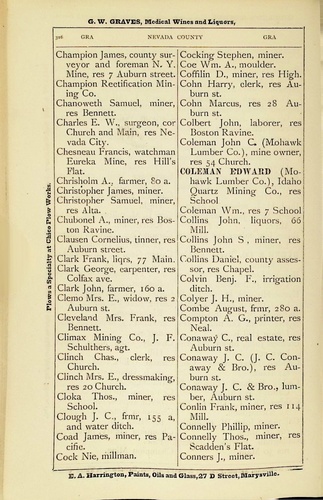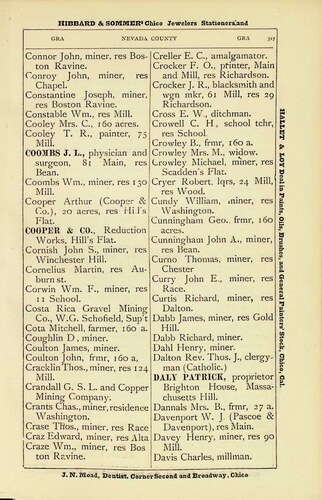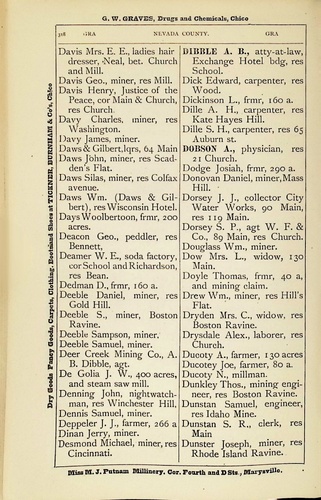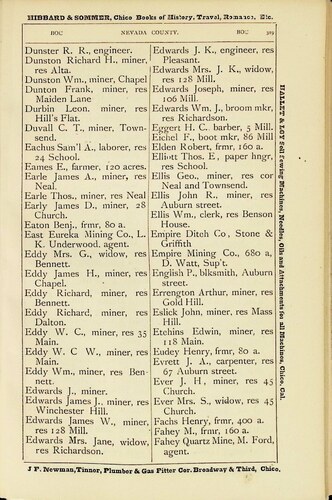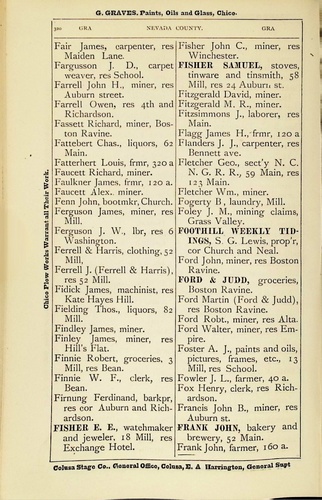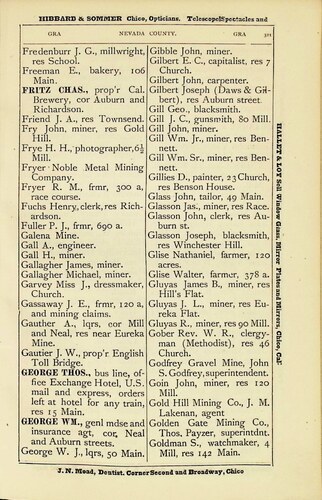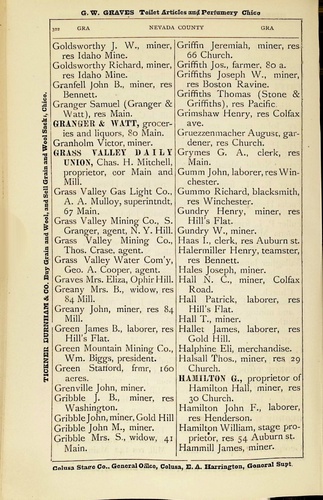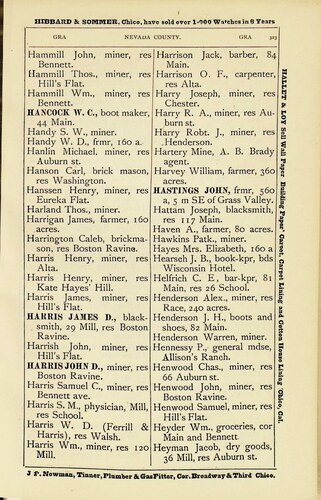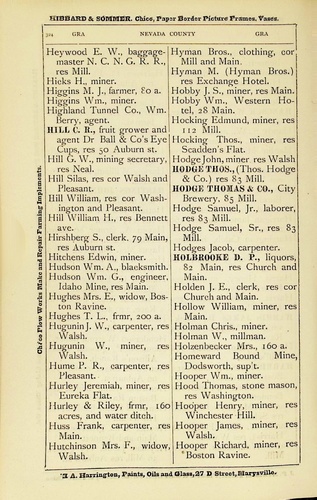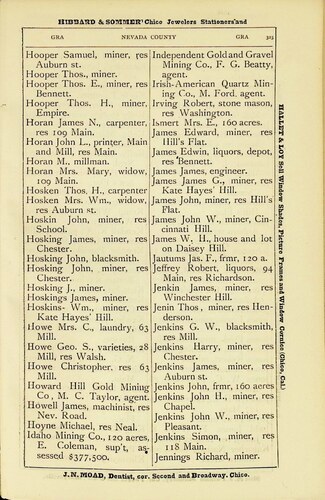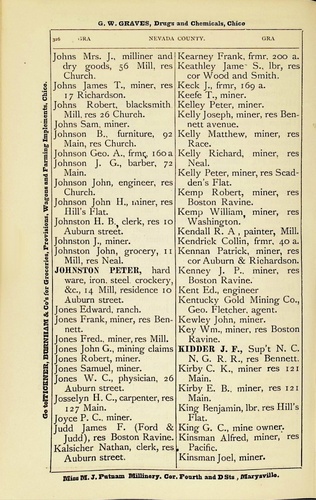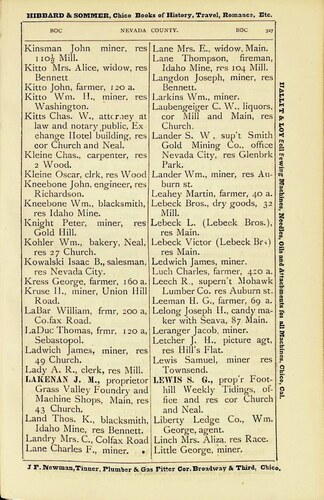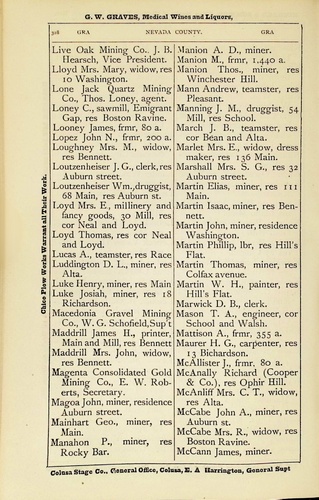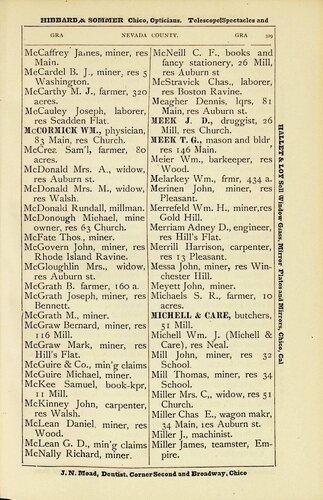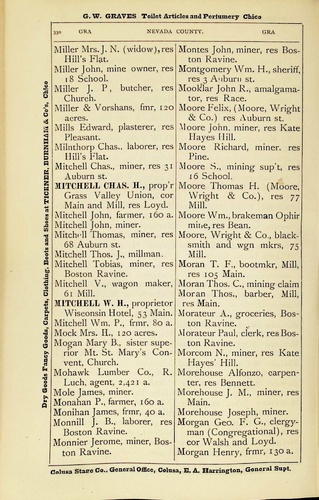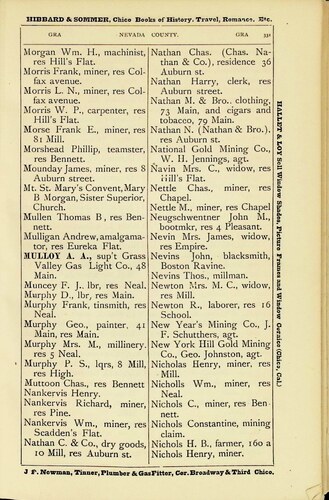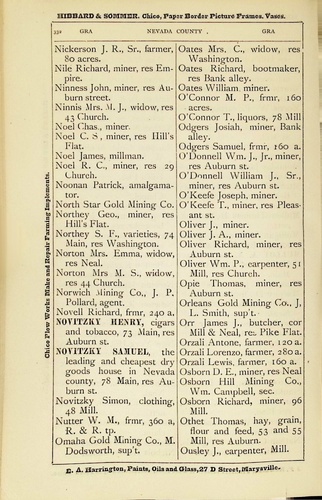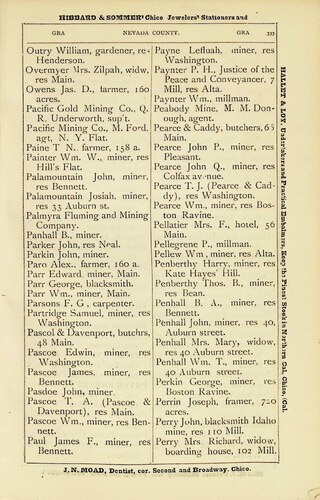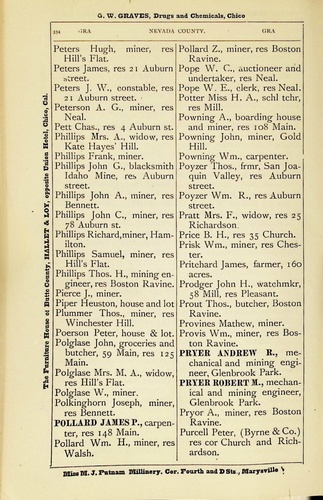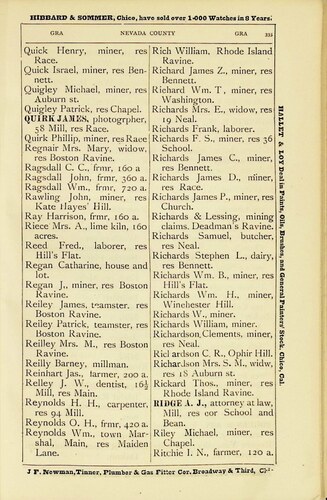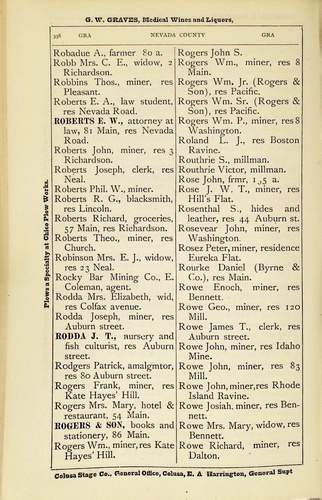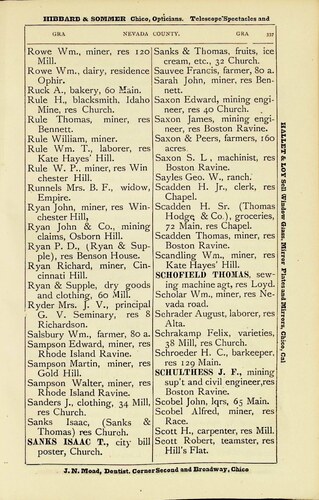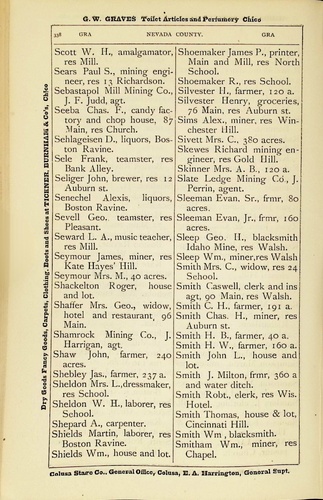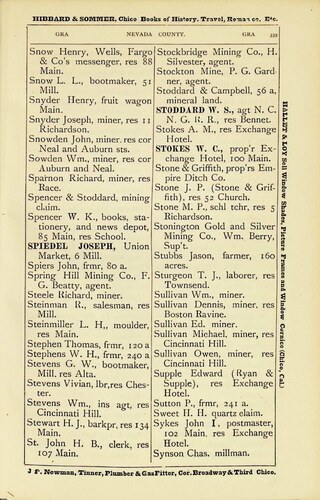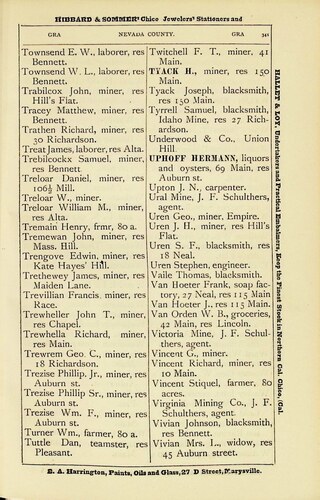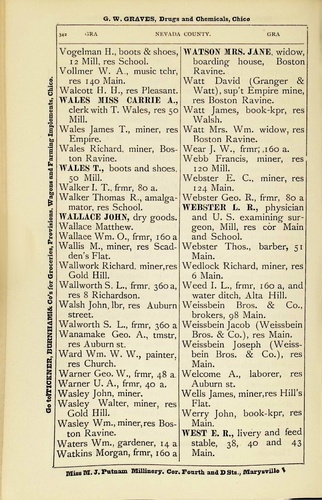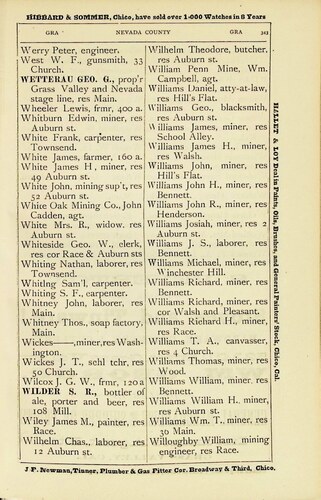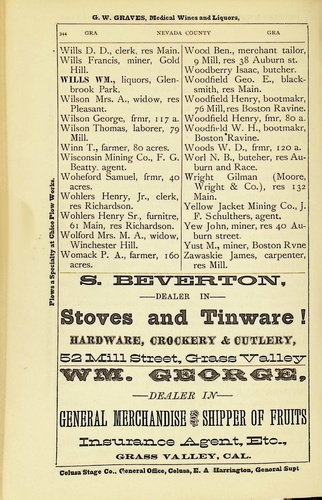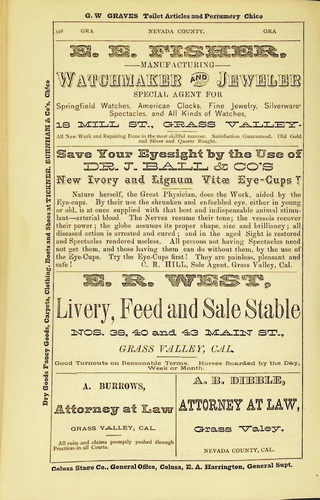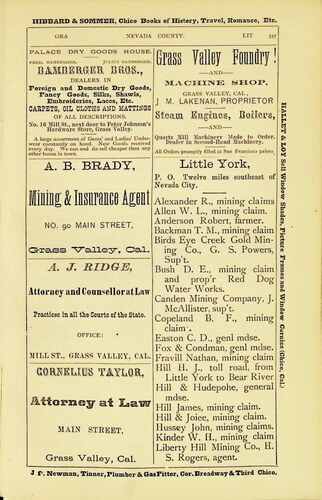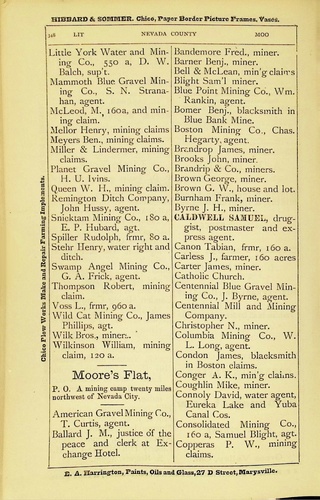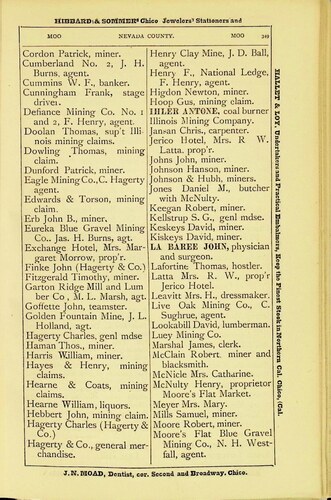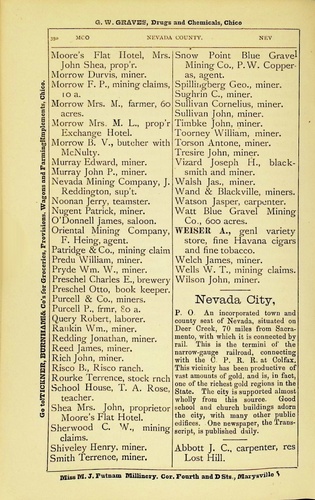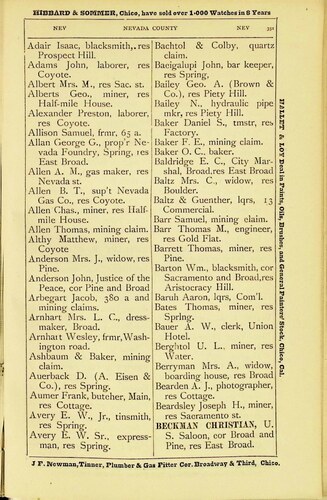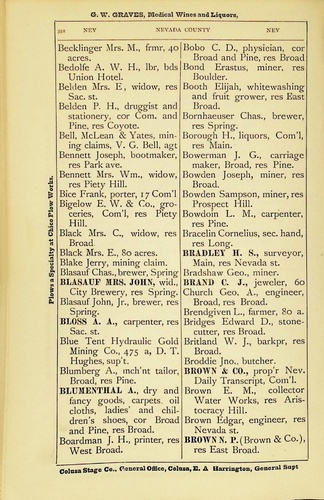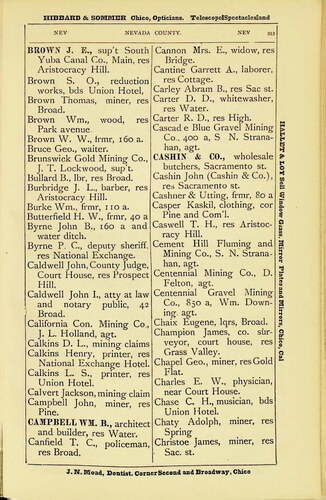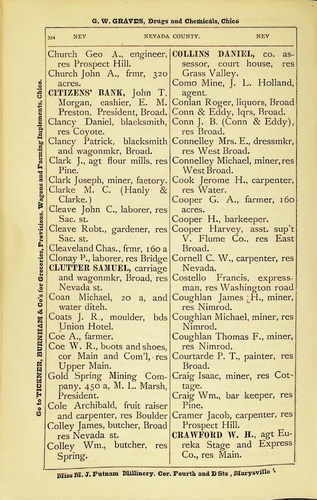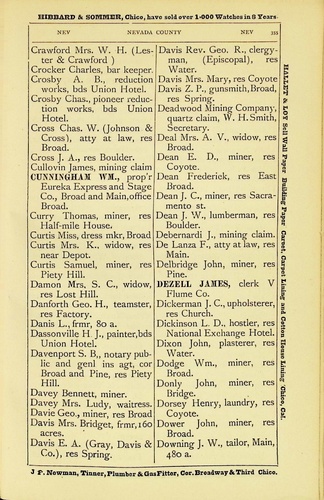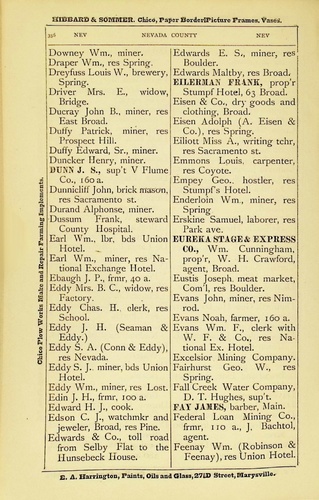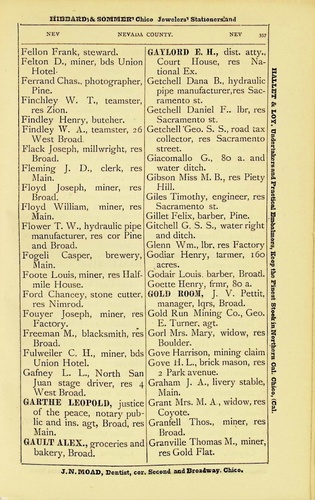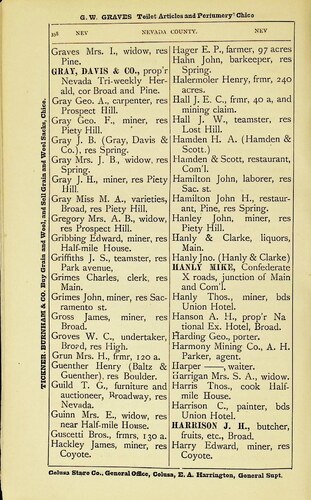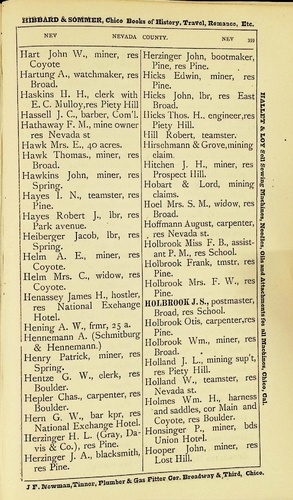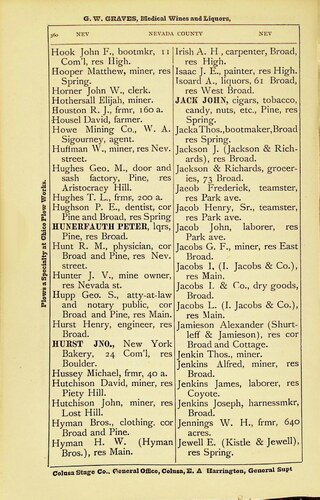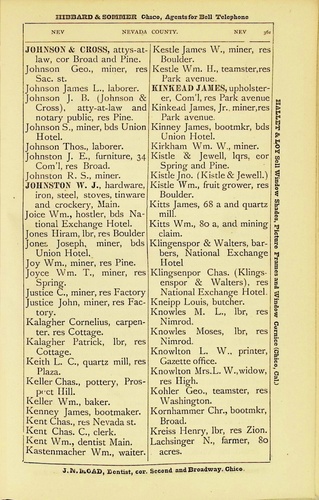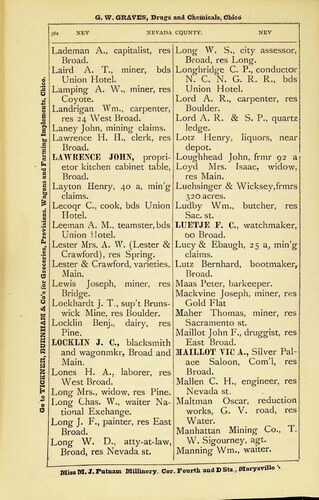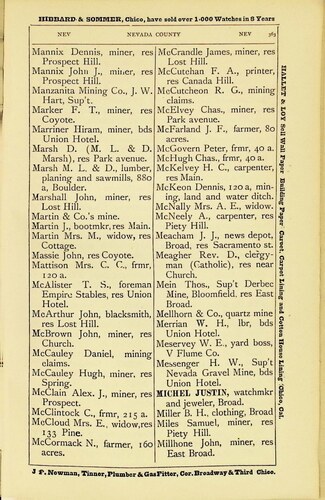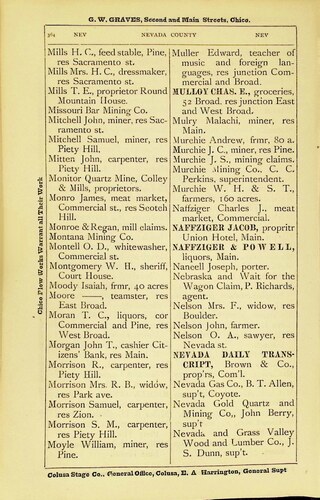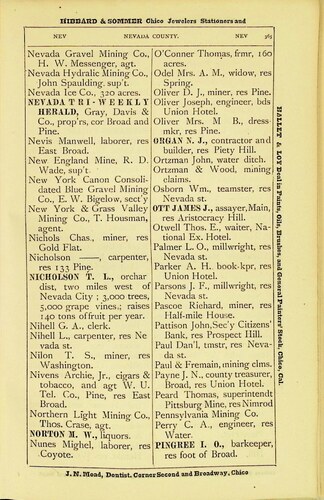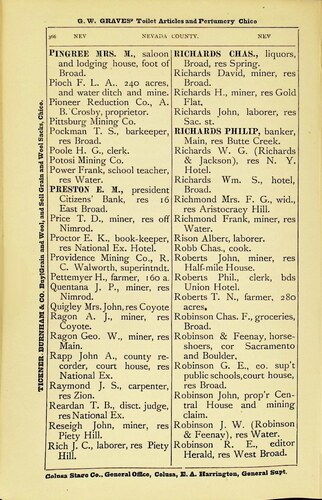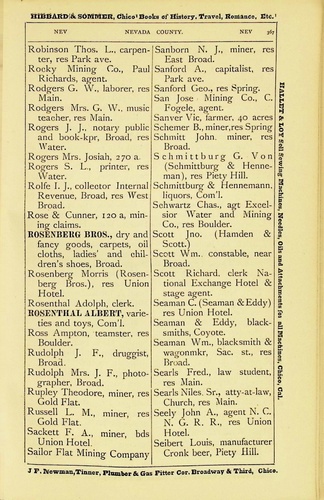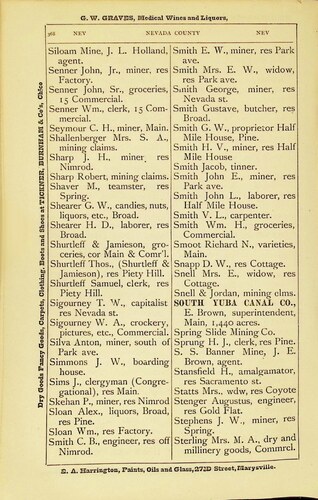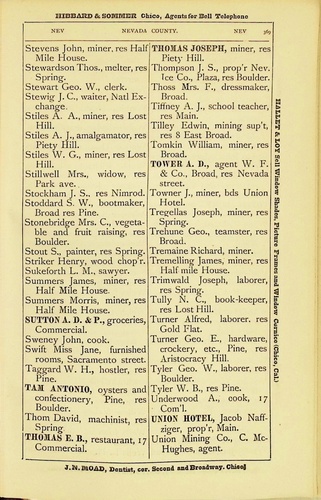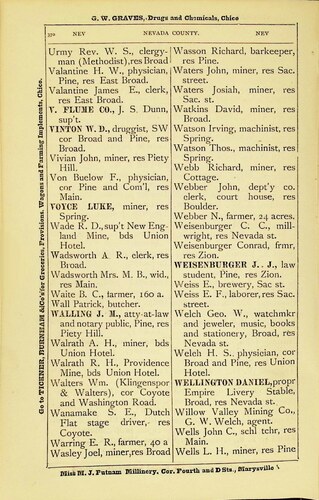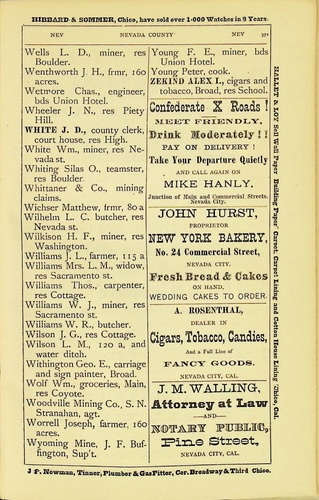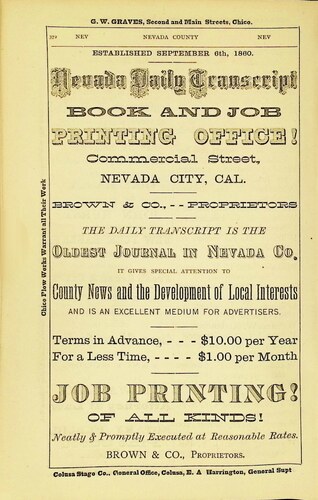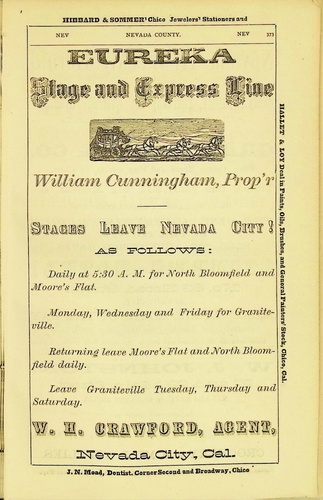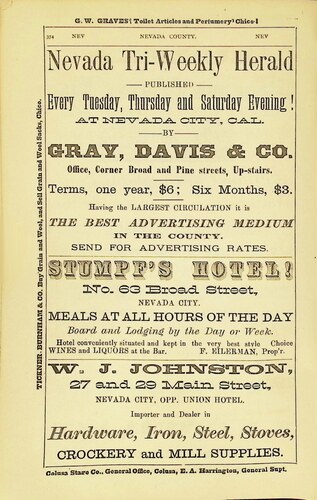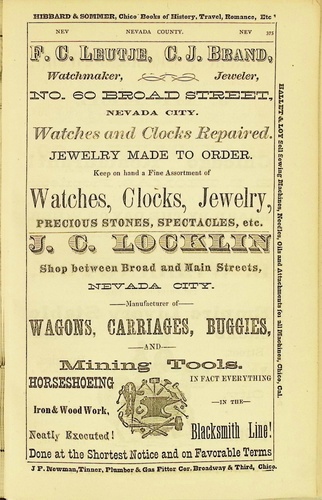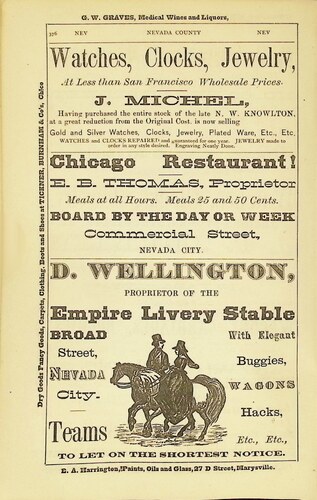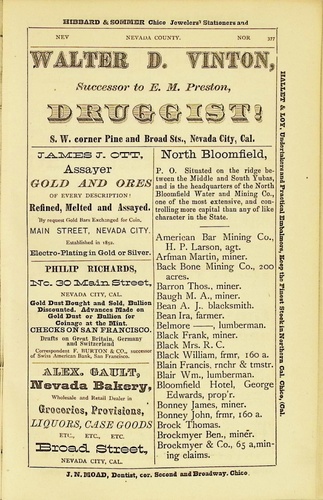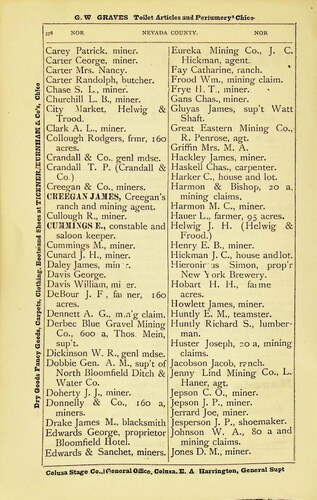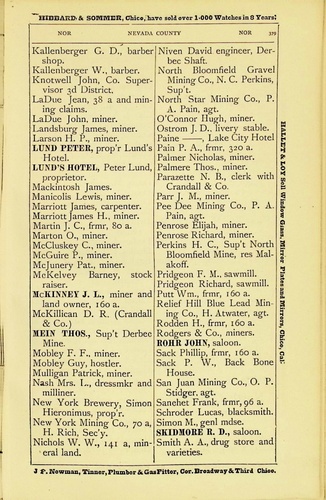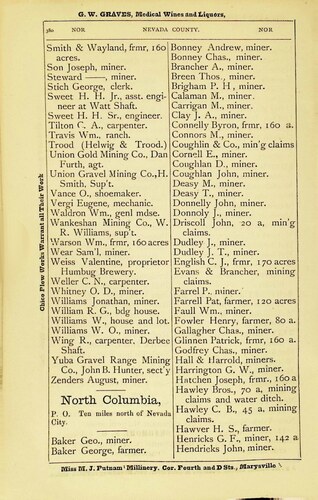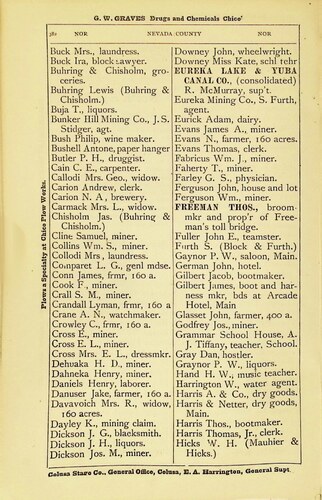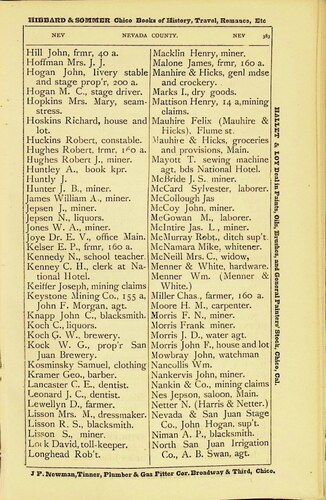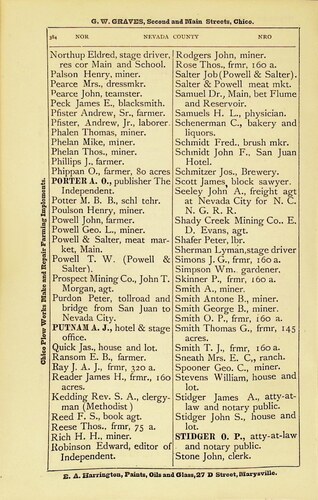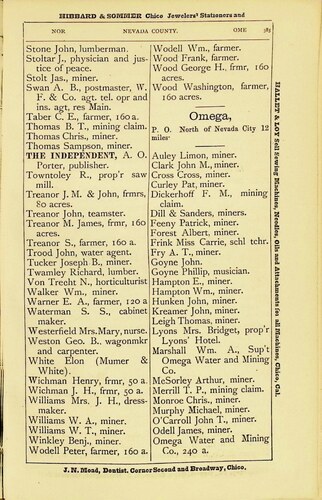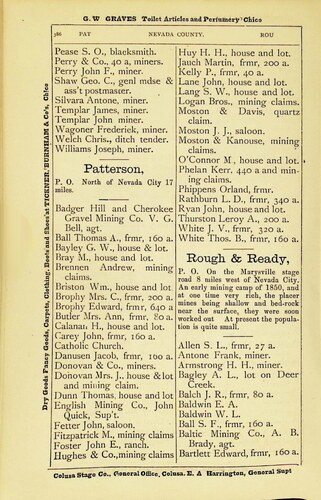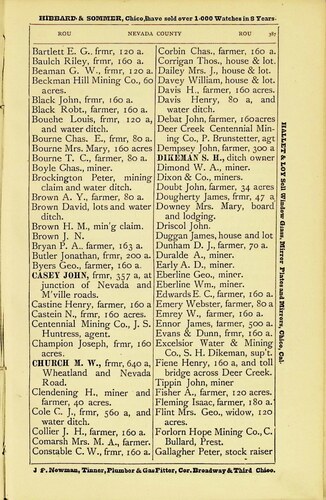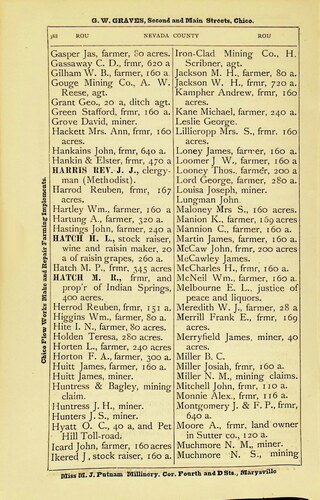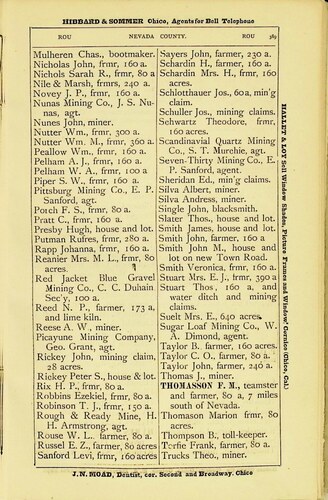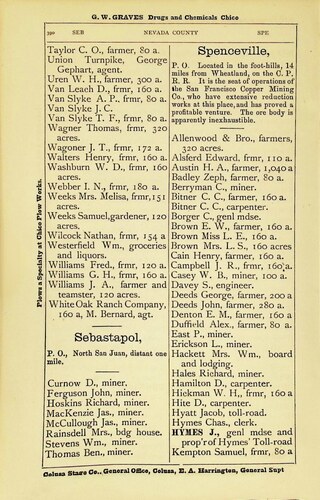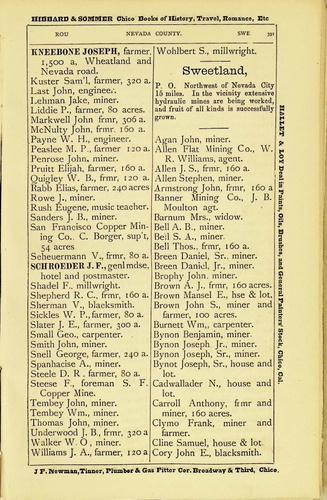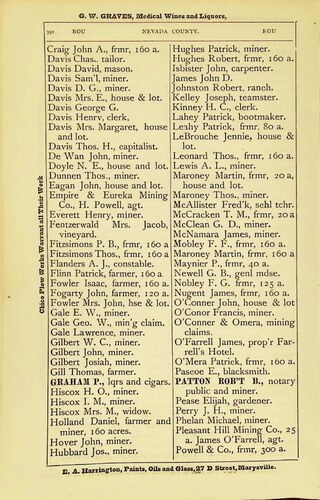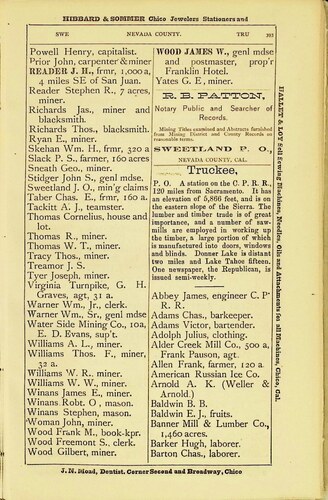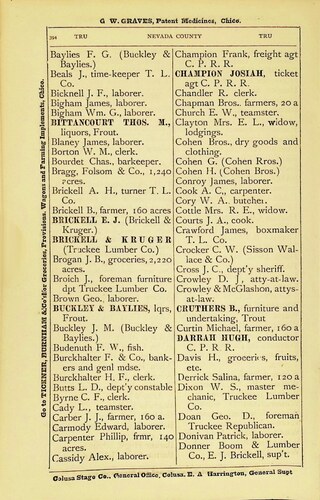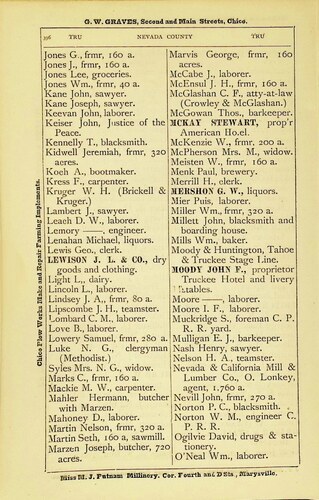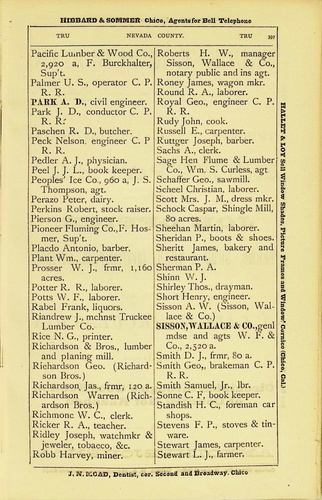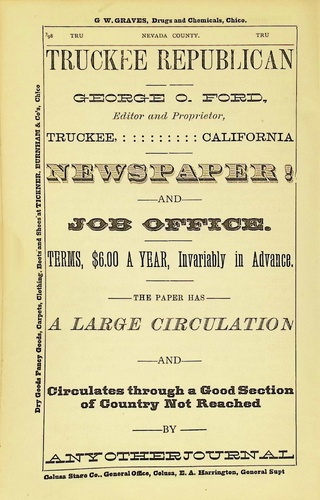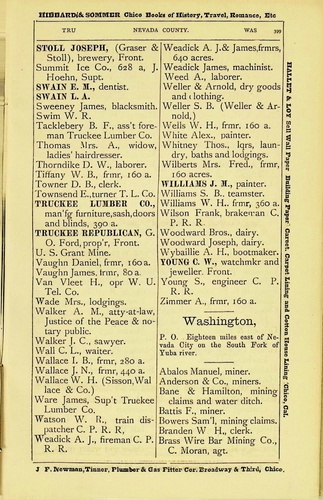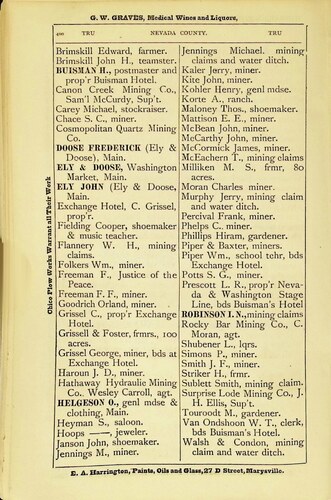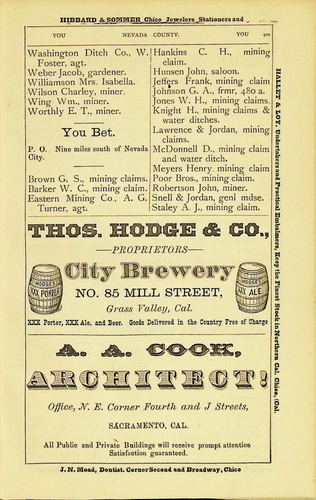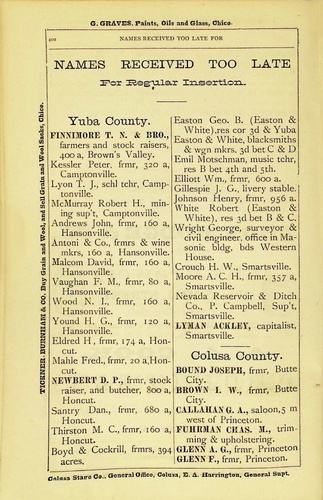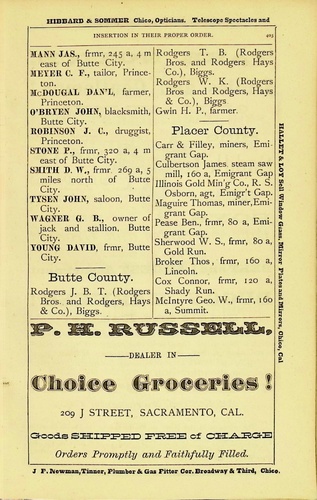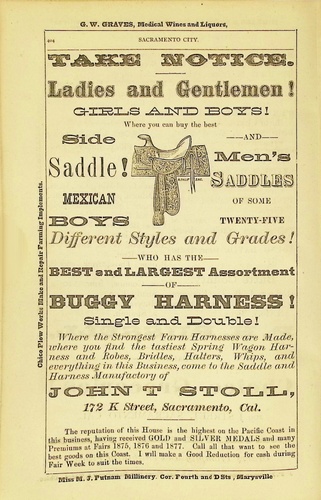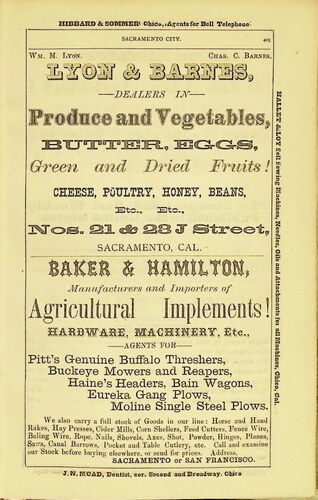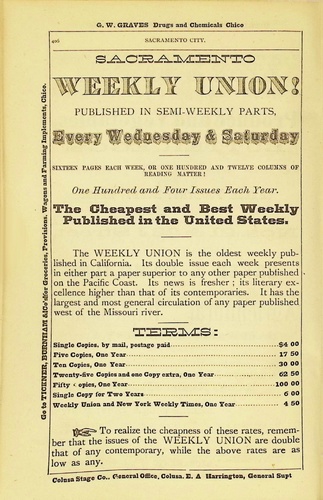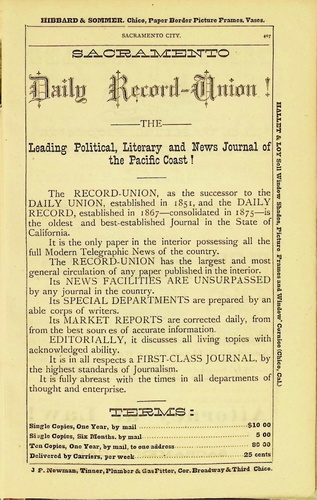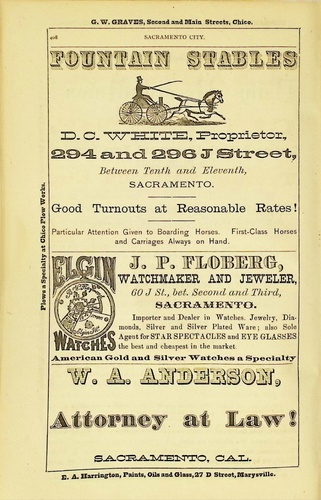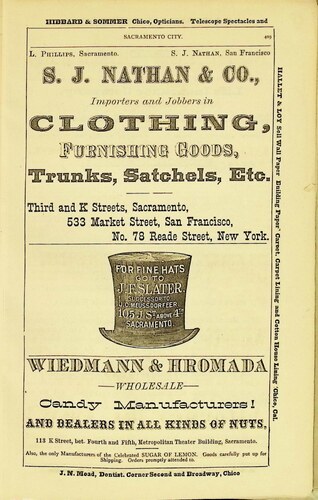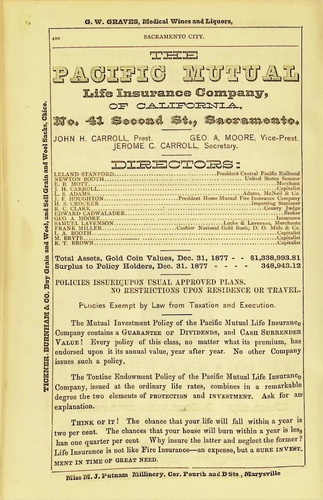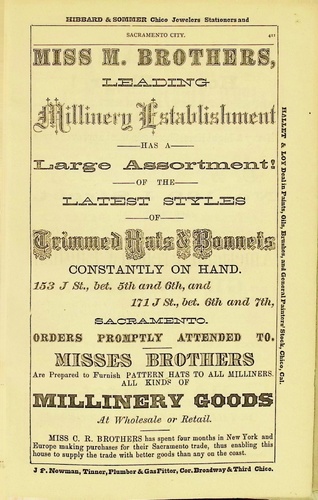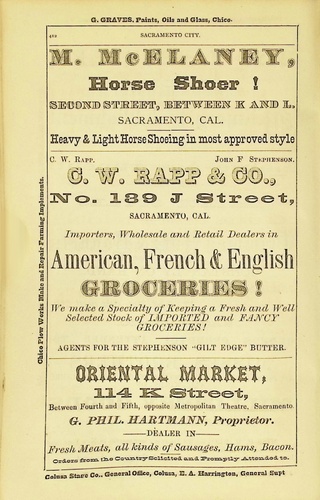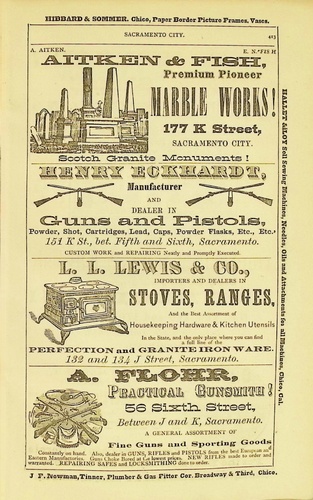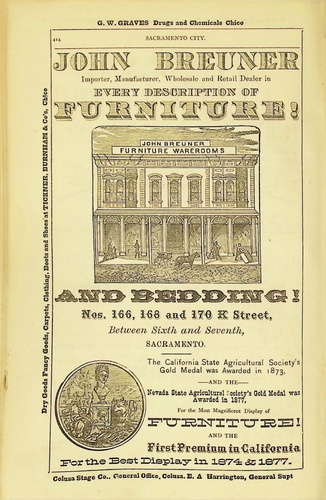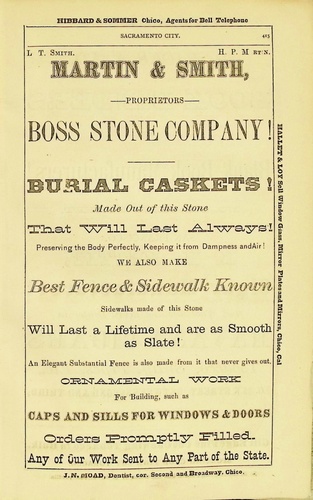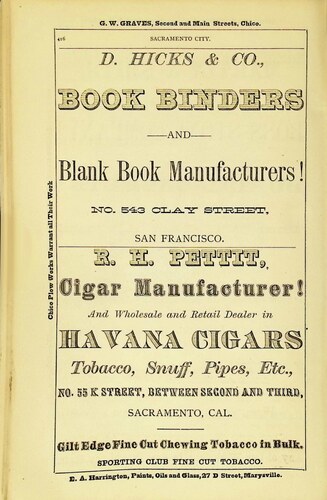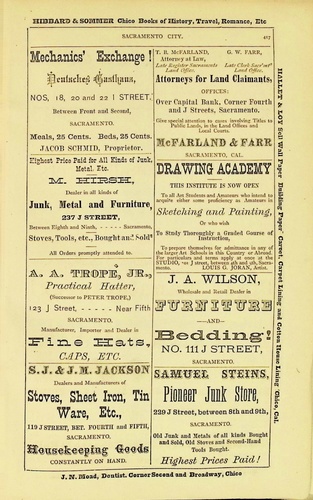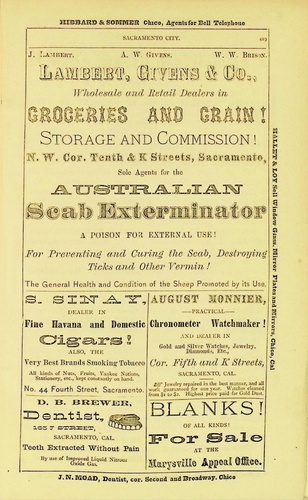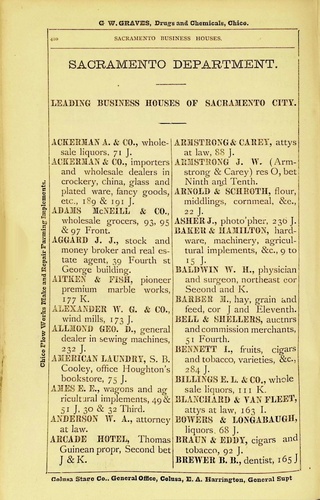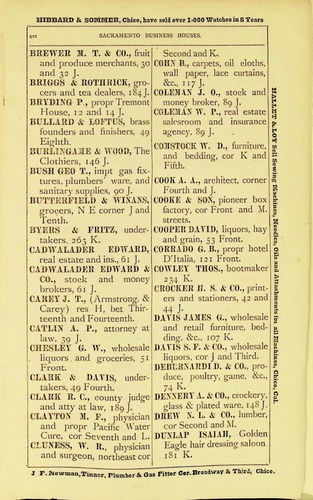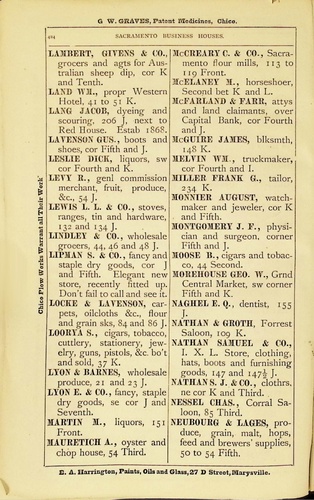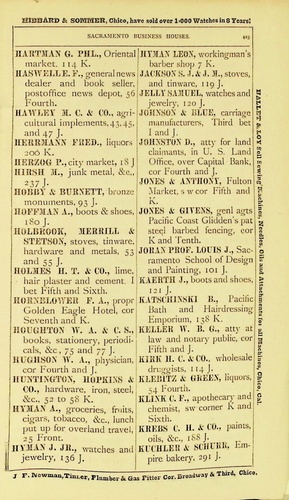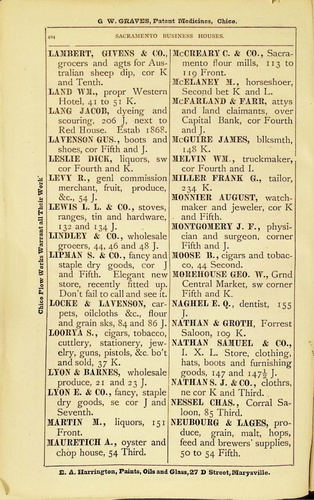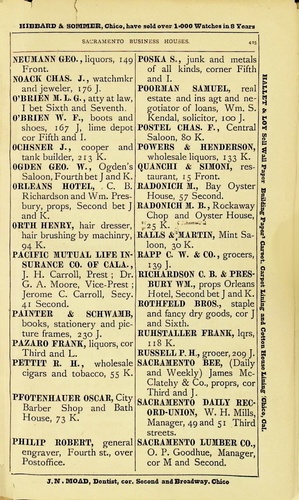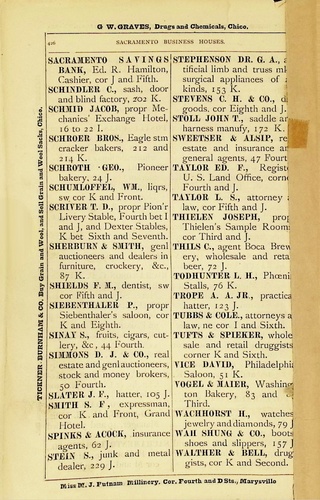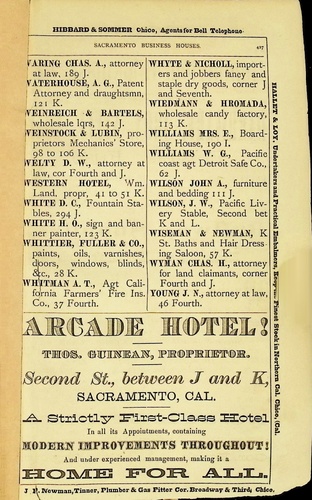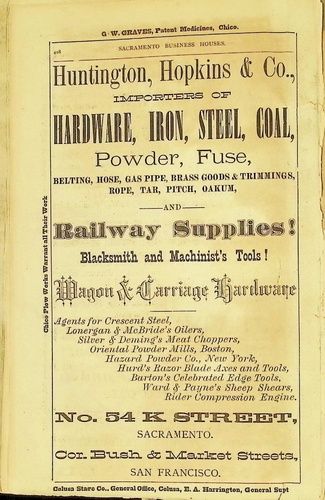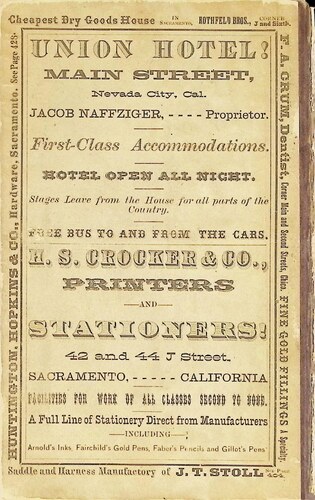Enter a name, company, place or keywords to search across this item. Then click "Search" (or hit Enter).
Collection: Directories and Documents > Directories
The Marysville Appeal Directory of Northern California for 1878 (650.025 MCK)(1878) (440 pages)
The Marysville Appeal Directory of Northern California for 1878 ranks among the top 5 of the many 19th-century directories that include Nevada County townships and postal towns, and among the top 3 that feature numbered street addresses for some listings. Its scope is conveyed in its subtitles, though one is misleading.
L. M. McKenney, compiler
The Marysville Appeal Directory of Northern California for 1878
(Embracing A Complete Directory of Residents in the Counties of Butte, Colusa, Nevada, Placer, Sutter, Tehama and Yuba, including the Cities and Towns, with Historical and Statistical Sketch of Each.)
(A New and Prominent Feature of this Directory, is the fact that Every Resident Land Owner in these Seven Counties Appears, with the Number of Acres and Post Office Address.)
(It is Invaluable to Business Men, Merchants, Manufacturers.
Professional Men and Artisans are Included in the Work,
Containing Over 25,000 Names.)
Marysville, Cal.: Lockwood & Dawson, Publishers
428 pages, plus advertising, price $3.00
Nevada County (pages 306-401) begins with a half-page description of the county, followed by listings of residents by 23 post offices -- Anthony House, Boca, Bronco, French Corral, Graniteville, Grass Valley (311-347), Little York, Moore's Flat, Nevada City (350-377), North Bloomfield, North Columbia, North San Juan, Omega, Patterson, Rough & Ready, Sebestapol, Spenceville, Sweetland, Truckee, Washington, and You Bet.
Most post offices are minimally described by their distance from Nevada City as the county seat. A few, including Grass Valley and Nevada City, have longer descriptions. Graniteville, though followed by over 3 columns of listings, has no description other than "See Eureka South" -- but there is no separate listing for either Eureka, once a Township in Nevada County, or for Eureka South, the main settlement in the township and home to the Graniteville Post Office, its latterday namesake.
Post offices versus municipalities -- Settlements like Boston Ravine, Glenbrook, and Hills Flat were not at the time within Grass Valley's corporate limits. But their residents generally patronized the Grass Valley Post Office -- a federal entity with its own territory or catchment, not to be confused with the much smaller corporate City of Grass Valley. Nevada City, as a post office, likewise referred to a federal postal catchment -- not to Nevada or later Nevada City as an incorporated locality.
Understanding directory listings in the context of their times requires some awareness of what was and wasn't part of an incorporated locality. A good example would be "ROBERTS E. W., attorney at law, 81 Main, res Nevada Road" (page 336). Roberts's son, a law student, also resided on Nevada Road -- the name of the turnpike that ran from the start of Main street in Grass Valley at Grass Valley's corporate limits between Eureka and Bennett streets, and the corporate limits of Nevada City. Today, most of Nevada Road is part of East Main Street -- the result of a series of annexations up to and including Glenbrook in more recent times. In 1878, there were no East/West Main distinctions, as the numbering of Main street began from its start off the Nevada Road at the city limits between Eureka and Bennett.
Some address listings in the Marysville Appeal directory include streets, and some listings with streets also show building numbers. But as mail was received at a post office, names of streets and building numbers, or non-incorporated localities, were not part of a postal address, which required only the recipient's name, and the name of the post office and state. Rural Free Delivery (outside an incorporated municipality), and Free Mail Delivery (within an incorporated municipality), would not begin until the 20th century. Until then, people had to go to a post office to send and receive mail.
Contrary to the title page, not "every resident land owner" appears with a "number of acres". Most listees are identified by their business or occupation, without any acreage or other assets. Acreage is shown for practically all listees identified as farmers, but for very few others. Some farmers owned a specified number of acres and a water ditch. A few listees owned a mining claim, a house and lot, or a water ditch. And some had a mining claim and water ditch. Someone at an undisclosed occupation had an irrigation ditch.
Grass Valley led Nevada City in building number usage. Grass Valley's 1,502 listings include 81 Mill street addresses, of which 55 (67.9 percent) were numbered. Of 109 Main addresses 71 (65.1 percent) were numbered, and of 84 Auburn addresses 30 (35.7 percent) were numbered. Nevada City's 890 listings include 135 Broad (6 or 4.4 percent numbered), 53 Main (none numbered), and 36 Commercial (8 or 22.2 percent numbered).
These figures suggest that Grass Valley residents -- especially Mill and Main street listees -- were many times more likely to have building numbers than shops, offices, and residences on Nevada City's principal streets. The highest percentage of building numbers in Nevada City, on Commercial street (22.2 percent), amounted to only two thirds of the lowest percentage of building numbers on Auburn street in Grass Valley (35.7 percent). Whether this reflects canvassing biases, or actual differences in the use of building numbers in the two towns, is not clear. Contemporary newspaper ads suggest that, even in Grass Valley, very few businesses publicized their building numbers -- simply because they were useless.
Building numbers were promoted in Nevada in late 1855 by the compilers of Brown & Dallison's Nevada, Grass Valley and Rough and Ready Directory, as something done in most large cities. Grass Valley businesses and stores were numbered the following year, with cards the Grass Valley Telegraph called "signs of the times" (Tuesday, 13 May 1856, p2).
The start of free mail delivery -- Half a century of directories and newspaper ads suggest that the early novelty of building numbers quickly wore off. Not until 1904-1905 were street numbers, until then the whim of private number agents, come to be mandated and controlled by city governments, to facilitate free mail delivery within their corporate limits. Grass Valley qualified in 1913, while free mail delivering in Nevada City -- where numbering began -- didn't begin until 1940.
L. M. McKenney, compiler
The Marysville Appeal Directory of Northern California for 1878
(Embracing A Complete Directory of Residents in the Counties of Butte, Colusa, Nevada, Placer, Sutter, Tehama and Yuba, including the Cities and Towns, with Historical and Statistical Sketch of Each.)
(A New and Prominent Feature of this Directory, is the fact that Every Resident Land Owner in these Seven Counties Appears, with the Number of Acres and Post Office Address.)
(It is Invaluable to Business Men, Merchants, Manufacturers.
Professional Men and Artisans are Included in the Work,
Containing Over 25,000 Names.)
Marysville, Cal.: Lockwood & Dawson, Publishers
428 pages, plus advertising, price $3.00
Nevada County (pages 306-401) begins with a half-page description of the county, followed by listings of residents by 23 post offices -- Anthony House, Boca, Bronco, French Corral, Graniteville, Grass Valley (311-347), Little York, Moore's Flat, Nevada City (350-377), North Bloomfield, North Columbia, North San Juan, Omega, Patterson, Rough & Ready, Sebestapol, Spenceville, Sweetland, Truckee, Washington, and You Bet.
Most post offices are minimally described by their distance from Nevada City as the county seat. A few, including Grass Valley and Nevada City, have longer descriptions. Graniteville, though followed by over 3 columns of listings, has no description other than "See Eureka South" -- but there is no separate listing for either Eureka, once a Township in Nevada County, or for Eureka South, the main settlement in the township and home to the Graniteville Post Office, its latterday namesake.
Post offices versus municipalities -- Settlements like Boston Ravine, Glenbrook, and Hills Flat were not at the time within Grass Valley's corporate limits. But their residents generally patronized the Grass Valley Post Office -- a federal entity with its own territory or catchment, not to be confused with the much smaller corporate City of Grass Valley. Nevada City, as a post office, likewise referred to a federal postal catchment -- not to Nevada or later Nevada City as an incorporated locality.
Understanding directory listings in the context of their times requires some awareness of what was and wasn't part of an incorporated locality. A good example would be "ROBERTS E. W., attorney at law, 81 Main, res Nevada Road" (page 336). Roberts's son, a law student, also resided on Nevada Road -- the name of the turnpike that ran from the start of Main street in Grass Valley at Grass Valley's corporate limits between Eureka and Bennett streets, and the corporate limits of Nevada City. Today, most of Nevada Road is part of East Main Street -- the result of a series of annexations up to and including Glenbrook in more recent times. In 1878, there were no East/West Main distinctions, as the numbering of Main street began from its start off the Nevada Road at the city limits between Eureka and Bennett.
Some address listings in the Marysville Appeal directory include streets, and some listings with streets also show building numbers. But as mail was received at a post office, names of streets and building numbers, or non-incorporated localities, were not part of a postal address, which required only the recipient's name, and the name of the post office and state. Rural Free Delivery (outside an incorporated municipality), and Free Mail Delivery (within an incorporated municipality), would not begin until the 20th century. Until then, people had to go to a post office to send and receive mail.
Contrary to the title page, not "every resident land owner" appears with a "number of acres". Most listees are identified by their business or occupation, without any acreage or other assets. Acreage is shown for practically all listees identified as farmers, but for very few others. Some farmers owned a specified number of acres and a water ditch. A few listees owned a mining claim, a house and lot, or a water ditch. And some had a mining claim and water ditch. Someone at an undisclosed occupation had an irrigation ditch.
Grass Valley led Nevada City in building number usage. Grass Valley's 1,502 listings include 81 Mill street addresses, of which 55 (67.9 percent) were numbered. Of 109 Main addresses 71 (65.1 percent) were numbered, and of 84 Auburn addresses 30 (35.7 percent) were numbered. Nevada City's 890 listings include 135 Broad (6 or 4.4 percent numbered), 53 Main (none numbered), and 36 Commercial (8 or 22.2 percent numbered).
These figures suggest that Grass Valley residents -- especially Mill and Main street listees -- were many times more likely to have building numbers than shops, offices, and residences on Nevada City's principal streets. The highest percentage of building numbers in Nevada City, on Commercial street (22.2 percent), amounted to only two thirds of the lowest percentage of building numbers on Auburn street in Grass Valley (35.7 percent). Whether this reflects canvassing biases, or actual differences in the use of building numbers in the two towns, is not clear. Contemporary newspaper ads suggest that, even in Grass Valley, very few businesses publicized their building numbers -- simply because they were useless.
Building numbers were promoted in Nevada in late 1855 by the compilers of Brown & Dallison's Nevada, Grass Valley and Rough and Ready Directory, as something done in most large cities. Grass Valley businesses and stores were numbered the following year, with cards the Grass Valley Telegraph called "signs of the times" (Tuesday, 13 May 1856, p2).
The start of free mail delivery -- Half a century of directories and newspaper ads suggest that the early novelty of building numbers quickly wore off. Not until 1904-1905 were street numbers, until then the whim of private number agents, come to be mandated and controlled by city governments, to facilitate free mail delivery within their corporate limits. Grass Valley qualified in 1913, while free mail delivering in Nevada City -- where numbering began -- didn't begin until 1940.
Catalog #: 650.025 MCK
Author: L. M. McKenney
Publisher: Lockwood & Dawson, Publishers
Published: 1878
Subjects: Town Directory, Gazetteer, Nevada County, Townships
Related Items: Original Held At:
Author: L. M. McKenney
Publisher: Lockwood & Dawson, Publishers
Published: 1878
Subjects: Town Directory, Gazetteer, Nevada County, Townships
Related Items: Original Held At:
Zoom Out
Zoom In (Please allow time for high-res images to load)
Zoom: 100%




